

DOUGLASVILLE PEDESTRIAN & BICYCLE CONNECTIVITY PLAN


ACKNOWLEDGMENTS

CITY MAYOR
Rochelle Robinson
CITY COUNCIL
Terry Miller, Ward 1
Nycole Miller, Ward 2, Post 1
Mark Adams, Ward 2, Post 2
LaShun Burr Danley, Ward 3, Post 1
Sam Davis, Ward 3, Post 2
Chris Watts, Ward 4
Howard Estes, Ward 5
CITY MANAGER
Marcia Hampton
COMMUNITY DEVELOPMENT
Patrice Williams
CITY PLANNING
Michelle Wright
ECONOMIC DEVELOPMENT
April McKown
PUBLIC WORKS
Greg Roberts
BICYCLE & PEDESTRIAN STEERING COMMITTEE
George Boulineau - Chairman
Jon Brown - Tributary
Derrick Crump - Citizen
J.R. Davidson - Douglas County Police Department
Elena Hudson - Downtown Business Owner
Chris “Coach” Watts - Councilman
Corey Jackson - Public Services Department
April McKown - Economic Development Manager
Shandron Pemberton - Downtown Business Owner
Byron Rushing - Atlanta Regional Commission
Steve Tiedemann - AECOM SPLOST Manager
Karen Tominey - Douglas County Planning
Miguel Valentin - Douglas County Transportation
Michelle Wright - Planning Manager
Patrice Williams - Community Development Director
Brieana Watts - City of Douglasville
Marcus Thompson - City of Douglasville
CONSULTANT TEAM
Mickey O’Brien - AECOM Project Director
John Hightower - AECOM Project Manager
Corey Klawunder - AECOM Project Consultant
Weiyi Zhou - AECOM Project Consultant
Danny Han - AECOM Project Consultant
Yiran Zhao - AECOM Project Consultant
Deborah Postma - AECOM Project Consultant



LIST OF FIGURES
LIST OF FIGURES




EXECUTIVE SUMMARY
The City of Douglasville is on the cusp of a transformation. The State Route 92 Bypass is nearing completion. When it opens, traffic that once caused noise and congestion at the at-grade railroad crossing in the heart of downtown will be routed around Douglasville to the northeast. Overnight, downtown will be transformed back into the quiet town center that it used to be. This is an incredible opportunity. It is the perfect time for Douglasville to pivot into a place that promotes active transportation to boost its economy and the health and happiness of its citizens. In order to act upon this once-in-a-lifetime opportunity, the City of Douglasville retained AECOM to study the connectivity of the existing pedestrian and bicycling network to provide a path forward. The result of that effort is a list of 122 projects prioritized based on their value as first steps. These recommendations can be found in the final chapter starting on page 188.

Many of these are large-scale projects like the Fairburn Road Complete Street/Veterans Memorial Hwy Shared-Use Path. Such ambitious projects provide a beautiful backbone for future infrastructure improvements and indicate that the City is serious about a prosperous future. Others are as short as the ~200 foot segment of sidewalk along Club Drive (the highest ranked project) Although not glamorous, filling in short connections such as these are arguably the most important first steps the city can take. All of these projects together will create a robust springboard as the City continues to invest in its future.
INTRODUCTION
In the Introduction, we take stock of the beautiful City of Douglasville and its many attributes. We begin with the goals and objectives of this study - we aim to make recommendations that create a robust active transportation network. Then we perform a Strengths-Opportunities-Constraints analysis. Douglasville’s strengths include a beautiful historic downtown, streets with quiet, local character, and proximity to Sweetwater Creek State Park, one of the most visited state parks in Georgia. The City is ripe with opportunity. It has a strategic regional position, it is split into two separate parts that would be perfect for a connection, and soon the New 92 Bypass will open, routing the traffic along State Route 92 away from downtown. As with every City, Douglasville comes with some constraints. The Norfolk Southern Railroad and Interstate-20 both split the City up, making connectivity across these facilities difficult. Finally, we provide a data-based rationale for making active transportation an integral part of the overall transportation network. Active transportation is safer than driving, boosts the local economy, and makes citizens healthier.



EXISTING CONDITIONS
PAGES 40-105
To begin, we survey the conditions in the City of Douglasville. We identify destinations of interest that we will use throughout the rest of the study. We map out the density of jobs and worker residences to understand the spatial distribution of people and work throughout the City limits. We take stock of the roads in the City of Douglasville, making note of characteristics such as speed, volume, and number of lanes to determine how comfortable they are for our design users. Then we map out the active transportation infrastructure that exists on the ground today. Finally, we map out natural characteristics such as streams and easements to identify potential connections that would be missed if we studied only the street network.
In the network analysis section, we take the information that we gathered in Part I and run it through a rigorous analysis. To begin, we reviewed 16 different City of Douglasville plans. We pull out the recommended projects that specifically pertain to active transportation and map them. At the end of this section, we blend all 16 of these previously proposed networks together in a variety of ways. This provides an understanding of the efforts that have gone before. In the latter half of this chapter, we run the existing street, pedestrian, and bicycle networks through a novel process that identifies street segments that are highly connective. Through this process, we identify a set of corridors that are important for the connectivity of a future active transportation network.
2 NETWORK ANALYSIS
106-187
3 RECOMMENDATIONS
PAGES 188-305
Finally, we present our recommendations. This chapter begins with an overview of the framework with which the design team made recommendations - active transportation loops. By packaging recommendations into greater loops, the City can break the list of projects down into more actionable and marketable goals. Next, we take the gaps that were identified in the existing conditions survey and identify which gaps need to be filled and which gaps can be safely left alone. We then package these gaps into 122 different projects and prioritize them based on their connectivity impact, their support from the public, their estimated planning level cost, and their potential to spur economic development. The result is a list of projects prioritized so that the most impactful projects rise to the top. In addition to the prioritized list, we present informational sheets for each of the top 30 projects. Finally, we use the same process employed to analyze the existing network to check our work by assessing the connectivity of the active transportation network if all 122 projects were implemented.

GOALS & OBJECTIVES
GOALS & OBJECTIVES
The end goal of this plan is to provide the City of Douglasville with a vision and path forward for a well-connected active transportation infrastructure system for all users, accommodating useful and enjoyable trips, and allowing for healthy lifestyle choices.

OBJECTIVES
Complete existing infrastructure
Connect children to schools OBJECTIVES
Provide accessibility wherever facilities exist
Provide people paths to nearby parks
OBJECTIVES
Eliminate conflicts among all modes
Reduce motor vehicle crashes and fatalities
OBJECTIVES
Encourage citizens to get outside
Promote active commuting
People can assume connectivity
Connect employees to job centers
FIGURE 1: Goals and objectives of the plan.
Increase perception of safety for all road users
Encourage physical activity every day
DESIGN USERS - PEDESTRIANS






























PEDESTRIAN DESIGN USER: ELDERS & CHILDREN
Designing facilities with these two user groups in mind will allow children to cultivate independence and the elderly to maintain it.











Source: United States Census Bureau (2018).
FIGURE 2: Pedestrian design user types and needs.
Image source: pedbikeimages.org
DESIGN USERS - CYCLISTS

Cyclist Types
I would describe myself as...
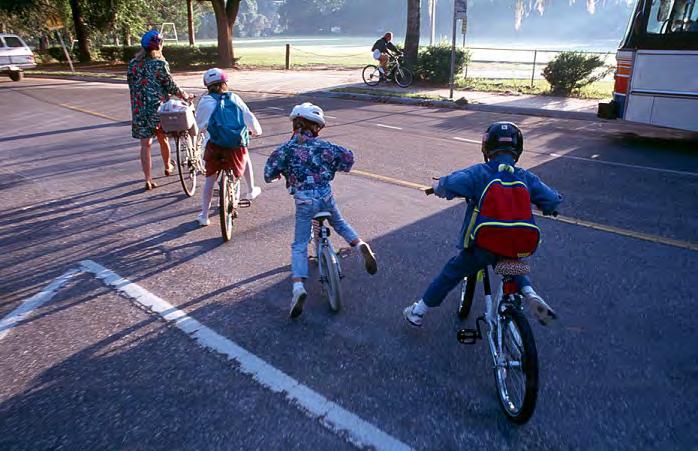

BICYCLE DESIGN USER: INTERESTED BUT CAUTIOUS
Image source: pedbikeimages.org
Designing for the 60% of potential cyclists that are interested but concerned about the dangers of riding on the road will help us build bicycle facilities for all ages and abilities.
Source: TDill, J., & McNeil, N. (2013). Four types of cyclists? Examination of typology for better understanding of bicycling behavior and potential. Transportation Research Record, 2387(1), 129-138.
FIGURE 3: Bicycle design user types and needs.
DOUGLASVILLE COMMUNITY BACKGROUND
D
DOUGLASVILLE COMMUNITY BACKGROUND
Douglasville, Georgia is a vibrant community that blends small town charm with big-town fun. It is the perfect example of a turn-of-the-century southern railroad town, chosen as the seat of the nascent Douglas County for its enviable position on the Georgia Western Railroad rightof-way. The historic downtown is listed on the National Register of Historic Places, and for good reason – it features beautiful architecture from the mid-19th century. Many of these buildings were built in the Victorian style, with details lifted from the Romanesque, Italianate, and Queen Anne periods. Sidewalks are often made of brick and are set flush to the buildings, elevated above the level of the street in many cases. It even features a dense grid system that allows the downtown area to maintain a walkable character, to the delight of tourists and residents alike.
Although founded on the basis of transportation, the specific combination of railroad and highways that Douglasville experiences have presented unique traffic issues. Georgia S.R. 92 runs right through the center of Douglasville, bringing with it noise and smog from car traffic. The railroad exacerbates this motor vehicle congestion when trains are running through downtown Douglasville, which brings traffic to a halt on SR 92. Fortunately, the Georgia Department of Transportation (GDOT), in cooperation with Norfolk Southern and the City, is nearing completion of a bypass, known colloquially as the New 92, that will route traffic around downtown Douglasville to the northeast of the town’s center.
This is a critical opportunity for the City of Douglasville. By synergizing the completion of the New 92 with a renewed focus on active modes of transportation, Douglasville can achieve a robust and resilient multimodal transportation system that makes it safe, easy, and efficient for citizens to get where the need to go. To this end, the City of Douglasville has hired AECOM to assess its bicycle and pedestrian infrastructure and provide the City a road map as it moves forward with improvements to its active transportation network.



Douglasville is committed to creating spaces where people love to play.
ASSETS: ALLEYWAYS
Historic Downtown Douglasville has many alleyways that are perfect for pedestrian activity.
PEDESTRIAN PLAZA
Douglasville’s new plaza across from the conference center displays a commitment to placemaking.
O’NEAL PLAZA
STUDY AREA
DOUGLAS COUNTY
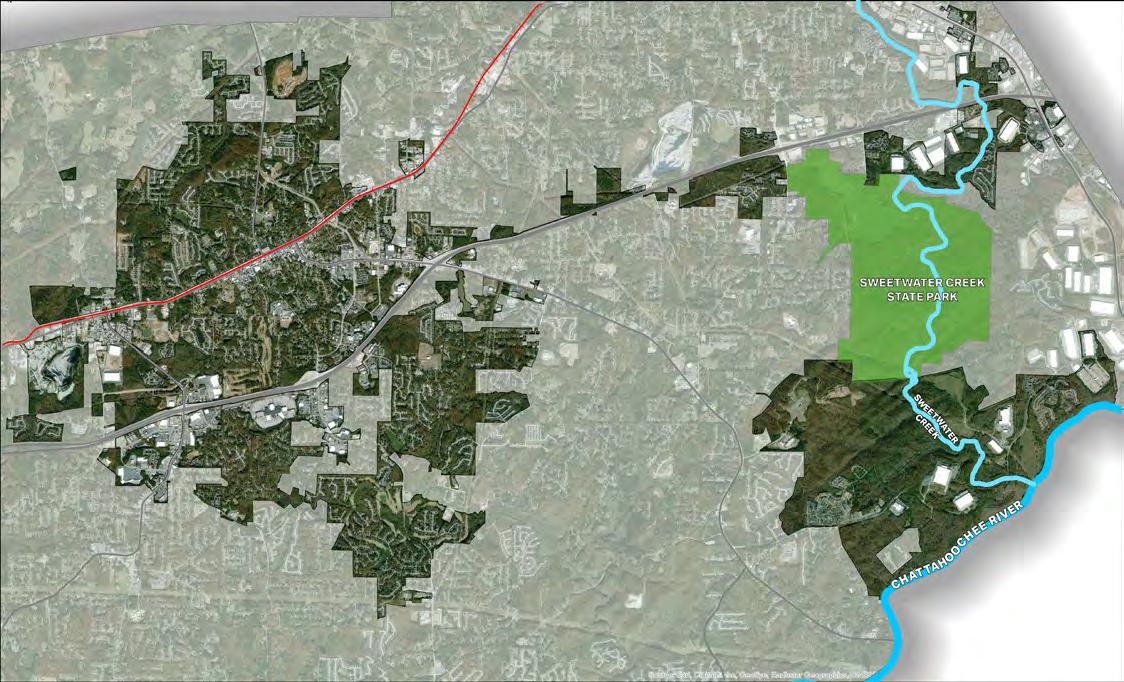
CITY OF DOUGLASVILLE

COBB COUNTY
FULTON COUNTY
PAULDING COUNTY
GEORGIA
DOUGLASVILLE DEMOGRAPHICS
Douglasville’s population has boomed since the turn of the millennium. As of the 2000 Census, Douglasville’s population was about 20,000. Today, its population is estimated at approximately 34,000 people for a 70% increase in 20 years. The key to retaining this growth likely lies in retaining Douglasville’s current younger population and attracting their peers. An estimated 9,000 people living in Douglasville - 26% of the population - are under the age of 18. The future success of Douglasville will be aided greatly by retaining these young people who are attracted to places which provide walking and biking opportunities.



34,190 people
14,814 people
Total population in Douglasville Workers 16 years and over
1,518 people / mi2
Population density
Commute Modeshare
Like many cities in America, Douglasville’s citizens commute to work almost entirely by car. Almost 90% of people make their typical trip to work by driving. By contrast, only 1.4% of workers in Douglasville walk to work.






FIGURE 5: Commuting behavior of Douglasville residents.
FIGURE 4: Demographics of Douglasville, Georgia.
STRENGTHS & ASSETS
Douglasville has many strengths that make it a strong contender in Metro Atlanta as we move deeper into the 21st century. Characteristics such as the local character of many roads, the well-gridded historic downtown area, and being at a crossroads of many different transportation assets are a real boon for the City of Douglasville. We detail these assets below.
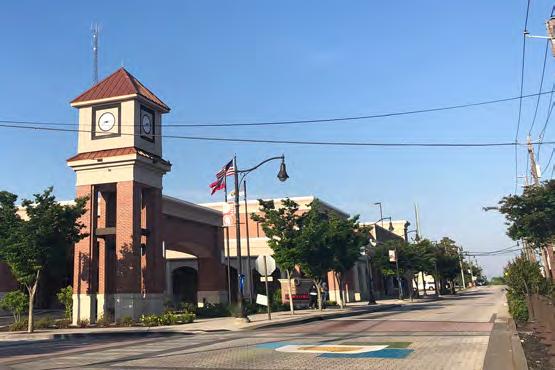
Local Character
Many of Douglasville’s streets have maintained a local character despite all odds. These are the streets that you’d be comfortable letting your children play on; where you would stand on the asphalt with your neighbor. These kinds of streets are living things; urban campfires where people can come together and live life. It is critical to the soul of Douglasville that these urban treasures are preserved while the City attracts more and more people into its limits.
Historic Downtown
Downtown Douglasville has a well-gridded downtown full of interesting things to see and do. The new conference center, at left, anchors the area, with a beautiful brick intersection and pedestrian plaza across the way. This small urban core provides residents a place to live, work, and play, and acts as a gathering place for residents to come together. With the New 92 bypass, downtown is on the cusp of a 21st century renaissance. See pages 52-57 for specific places of interest in downtown Douglasville.
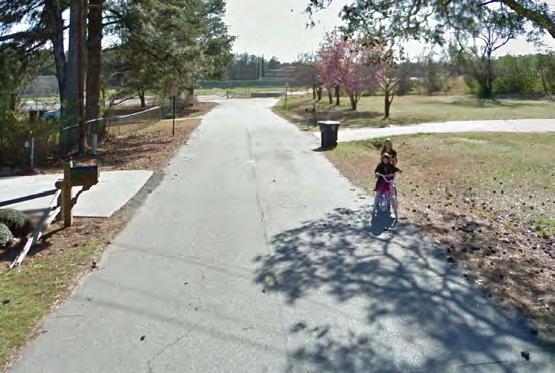
Strategic Regional Position
Douglasville is at a crossroads. It is right on the Norfolk Southern west line, giving it important freight access. It also lies on I-20 only 20 minutes drive west of downtown Atlanta, and only 30 minutes drive northwest of Hartsfield-Jackson International Airport, the busiest airport in the world. Sitting at these crossroads is Douglasville, a burgeoning city that is perfectly positioned.
Image source: Google Earth
STRENGTHS & ASSETS
Douglasville has many great assets that attract people to the area - a beautiful historic downtown area, the most visited state park in Georgia a world-class amusement park - all of which make Douglasville experience unique.
Sweetwater Creek State Park
These beautiful 2,549 acres of preserved land along Sweetwater Creek provide an important place for recreation for citizens of Atlanta and Douglasville alike.
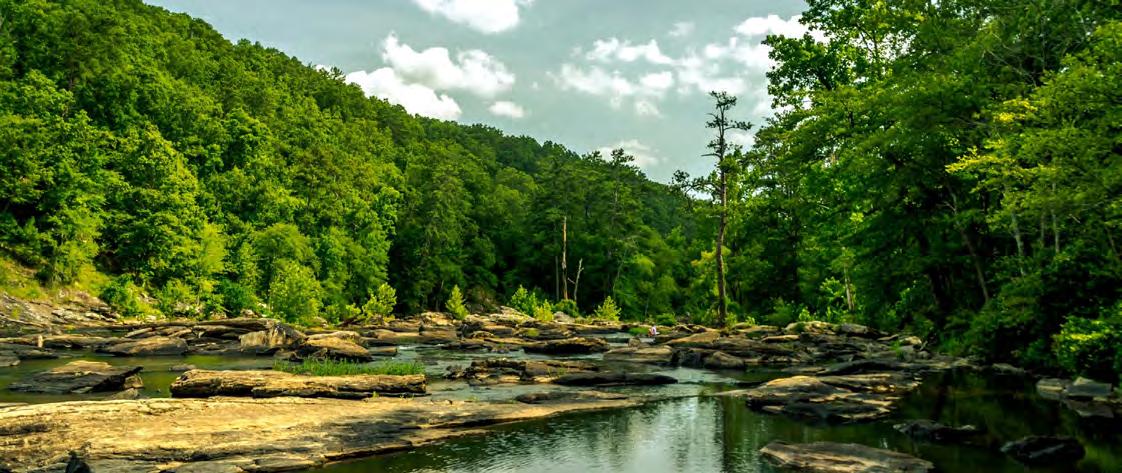
West Pines Golf Club
With a 4.3/5.0 rating and 93.1% of people saying they would recommend this course to a friend (according to GolfAdvisor.com), West Pines Golf Club is a wonderful place to play the great sport of golf.

Image source: westpinesgc.com
Image source: cntraveler.com

OPPORTUNITY: REGIONAL POSITION
CITY OF DOUGLASVILLE

Only a half-hour drive west of the capitol of Georgia and the most-trafficked airport in the world, the City of Douglasville has an incredible strategic regional position. As the City moves forward, this strategic regional position should be utilized to spur economic development and attract a diversity of people and business.
The City of Atlanta is the cultural and economic center of the state of Georgia. Douglasville is uniquely positioned to take advantage of the diversity of people and economy in Atlanta. Sweetwater Creek State Park and Douglasville’s quiet, rural character can serve as attractors for citizens of Atlanta that are seeking a get-away that is nonetheless close to home.


Hartsfield-Jackson Atlanta International Airportis the most trafficked airport in the world. Millions of people travel through this airport every year from all around the world. Douglasville, lying only 30 minutes to the northwest, is poised to take advantage of this opportunity.
OPPORTUNITY: CONNECT WEST & EAST DOUGLASVILLE
Douglasville is split into two disparate parts. The west part of the city is anchored by the historic downtown and Arbor Place Mall. The east part of town is anchored by Sweetwater Creek State Park and the many logistic centers along Riverside Parkway. Today, mobility between these two parts of town is limited and is almost nonexistent for pedestrians and bicyclists. But there is oppotunity for the city and the county to work together to create facilities that allow people to travel safely and seamlessly from downtown Douglasville to Sweetwater Creek State Park.

With the addition of such a recreational loop, Douglasville will continue to progress as an attraction for people all across the Southeast. In fiscal year 2010, 191,096 people visited Sweetwater Creek State Park. The economic boost that Douglasville would see if just a portion of those people rode their bike to downtown would be quite noticeable.


By installing a trail that leads to Douglasville at such a highly trafficked state park, the City pique the interest of visitors, enticing them to return to Douglasville for their next trip. Such visitors bring great economic opportunity. Not only do they spend into the economy, but they will spread the word of Douglasville’s unique charm and recreational amenities, encouraging even more visitors.

OPPORTUNITY: THE NEW 92 BYPASS
Historically, State Route 92 has run right through downtown Douglasville. Initially, this was a great boon, bringing economic development to Douglasville. In recent years, however, both the City and GDOT agreed that routing this highly trafficked route through the downtown area discouraged walkability and slowed vehicular throughput. Douglasville had to contend with high congestion rates, lots of noise, and an environment hostile to pedestrians - the lifeblood of downtown. Travelers had to contend with two traffic lights, long queueing times, and frequent rail traffic interupptions. In order to remedy this problem, GDOT and the City partnered to build a bypass.

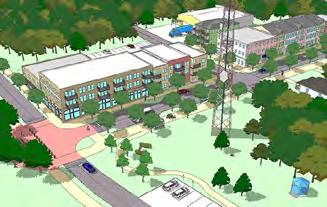


This is an incredible opportunity for Douglasville. Immediately upon the opening of the bypass, downtown Douglasville will see a dramatic decrease in the volume of motor vehicle through traffic. This will allow and encourage a downtown renaissance, where people of all ages and walks of life can feel comfortable hanging out downtown. What’s more, Fairburn Road and Dallas Highway will suddenly have far more lanes than needed, which will allow the City to completely redesign
these roads, as exemplified in the figure above. To that end, Douglasville has hired AECOM to provide a planning level scoping document for Fairburn Road Complete Street Conversion and hired APD and Toole Design Group for a planning study for Dallas Highway. Both efforts are focused on providing more multi-modal facilities, promoting pedestrian and cycling activity, and creating a new vision for redevelopment.
Rendering by: ADP & Toole Design, Dallas Highway LCI
Rendering by:
Rendering by: AECOM, Fairburn Road Compllete Street Concept
D CONSTRAINTS: NORFOLK SOUTHERN RAILROAD

Douglasville was founded on the west line of the Norfolk Southern Railroad. Each day, anywhere from 35 to 59 trains run through historic downtown at 60 miles an hour. This brings traffic along the current State Route 92 to a grinding halt, temporarily making downtown noisy and smoggy. As you can see below, there are only a few points at which you can cross the railroad. With the advent of the New 92, two of these crossings will be closed and only one opened, creating an even wider gap between available crossing opportunities.




EXISTING OR FUTURE CROSSING CROSSING TO BE REMOVED



The aerial at left depicts a close-up of the two main railroad crossings for downtown. Campbellton St reet (the right crossing) along the current State Route 92 alignment will be closed once the New 92 opens. The McCarley Street crossing (the left crossing) will remain open but will be moved 75’ to the left. Neither of these crossings has any pedestrian or bicycle facilities. This holds true for all of the crossings except the New 92, which will have a shared-use path running along it and underneath the railroad.

FAIRBURNRD
STRICKLAND ST
VETERAN’S MEMORIAL HWY
DALLAS HWY NEW2BYPASS
Aerial view of downtown railroad crossings at McCarley Street and Dallas Highway above. At right, view of the Dallas Highway crossing from the viewpoint shown above.
View of main downtown railroad crossing.
CONSTRAINTS: INTERSTATE-20

The next big innovation in transportation was the Interstate Highway System. Built in 1957, I-20 was one of the first interstates built as part of President Eisenhower’s National System of Interstate and Defense Highways Act passed in 1956. It connects Texas to South Carolina. Although critical for the economy of Douglasville and for motor vehicle passage to and from Atlanta, I-20 nonetheless presents a huge barrier to mobility. There are only five points that you can cross over the highway. The shortest distance between two adjacent crossings is over half a mile




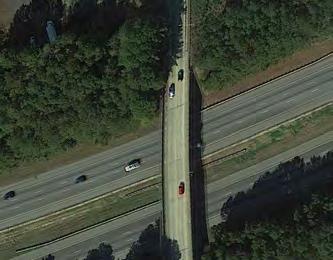


The aerials and on-the-ground views of these crossings depicted here make it clear that these crossings are relatively inhospitable for any mode other than the automobile. Only two of these crossings currently have pedestrian facilities, and none have bicycle facilities. Furthermore, the two bridges that have pedestrian facilities are almost two miles apart, which is much farther than the average walking trip.
Another complication is that two of the bridges, Bill Arp Road and Fairburn Road, are along state routes. Douglasville will have more control over bridges along local roads, but the City will have to negotiate any changes to bridges along state routes with GDOT.
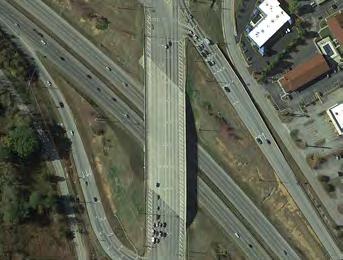
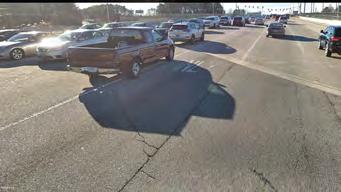

Aerial and view of Bright Star Road I-20 Bridge.
Aerial and view of Fairburn Road I-20 Bridge.
? WHY WALK AND BIKE?
WHY WALK & BIKE?
SAFETY
Active transportation facilities allow people of all ages and abilities to use streets safely.


ECONOMY
Robust active transportation facilities boost a city’s economy and increase real estate value.


People that regularly walk and bike are healthier than those who don’t.

FIGURE 6: Three reasons for supporting active transportation.
ACTIVE TRANSPORTATION IS SAFER
Driving can be dangerous. According to the NHTSA, 37,000 people were killed, and another 2,746,000 people were injured in motor vehicle crashes in 2017 in the U.S. Almost 1 in every 5 (20%) of the people killed were either walking or biking, yet only 12% of road users are walking or biking. According to the CDC, as referenced below, motor vehicle crashes are the leading cause of death for children and adolescents.
THIS SHOULD NOT HAPPEN.
Providing infrastructure which is specifically suited to cyclists and pedestrians can encourage more people to walk and ride their bikes for both commuting and recreational purposes. More people walking and biking places gets more people out of vehicles. Not only is this space-efficient, decreasing the number of cars on the road, thereby decreasing traffic, but it also raises the overall awareness that people may be walking or biking on a road. Those driving vehicles become more accustomed to checking for cyclists and stopping for pedestrians, while pedestrian- and bicycle-specific infrastructure serves as a visual cue to everyone that these types of users may be on the road.
Ten leading causes of child and adolescent death, 2016
Over 37,000 people are killed in crashes each year in the U.S.


Source: N Engl J Med. 2018; 379(25):2468-75
Note: Based on data from the Centers for Disease Control and Prevention’s Wide-ranging Online Data for Epidemiologic Research System.
Data Source: National Highway Traffic Safety Administration (NHTSA)
FIGURE 7: Traffic fatalities per year.
FIGURE 8: Leading causes of adolescent death 2016.
The faster vehicles are traveling, the more stressful walking is for pedestrians and the more likely a pedestrian-vehicle collision will result in a pedestrian fatality. The ability of a driver to stop in time for a pedestrian crossing the street significantly decreases as the vehicle’s speed increases.
SPEED KILLS.
The relationships among vehicle speeds, stopping distances, and the likelihood of pedestrian fatalities are shown below.

From 2014 to 2016, pedestrian fatalities increased by 22%

10: Relationship between speed and likelihood of pedestrian fatality.
Source: Tefft, B. C. (2013). Impact speed and a pedestrian’s risk of severe injury or death. Accident Analysis & Prevention, 50, 871-878. The 2018 seventh edition of A Policy on Geometric Design of Highways and Streets (The AASHTO “Green Book”) Note: Stopping distances include the distance it typically takes to react and the distance required for the vehicle to stop.
Data Source: Governor’s Highway Safety Association (GHSA)
FIGURE 9: Increase in pedestrian fatalities from 2014 to 2016.
FIGURE
The annual cost of owning and operating a motor vehicle is almost $9,000 (assuming 15,000 miles that the car is driven per year). That is $9,000 fewer dollars per driver pumped into the local economy. This cost also disproportionately affects people that are in poverty - $9,000 is well over a third of the annual income at the poverty line.
DRIVING A CAR IS COSTLY
That’s only the cost to the individual - the cost to society of car dependency is even higher. The Victoria Transport Policy Institute estimates that shifting from driving to walking saves society at large $0.25 per vehicle mile reduced. FHWA states that the average driver travels 13,000 miles per year. For illustration, take the City of Douglasville with its ~15,000 drivers. That’s a total of 195,000,000 annual miles traveled. If just 20% of those trips were taken by foot, the city would see a savings of $9.75 million per year in intangible benefits as expressed in the infographic below.

and




If 20% trips were taken by foot or bike...
15,000 x 13,000 x $0.25 x








M Drivers in DouglasvilleMiles driven per year Proportion of short trips 1 mile or less
Societal cost per mile of driving
Data Source: Gössling, Stefan, et al. “The social cost of automobility, cycling and walking in the European Union.” Ecological economics 158 (2019): 65-74. AND 2009 National Household Travel Survey. 1/13 1/5 1/35
12: Annualized cost of driving to society at large.
per year
be
FIGURE 11: Annualized cost of transportation to an individual.
FIGURE
Car dependency comes with a host of economic costs, while walkability and bikeability come with a host of economic benefits. For example, the CEO’s for Cities report on walkability states that for each point increase in the walkability score of a piece of real estate, the value of that land increases by $500 to $3,000.
WALKING & BIKING BOOSTS THE ECONOMY
When space is given to pedestrians and cyclists, what often accompanies this is a loss of parking. Although business owners may worry that less parking will result in a loss of business and customers, numerous studies indicate quite the opposite. A study of 78 businesses in metropolitan Portland, OR, found that pedestrians and cyclists are actually “competitive consumers”, meaning that they spend just as much, and oftentimes more, than their vehicular counterpart. Cyclists tend to spend less per trip, but take trips more frequently, often patronizing smaller businesses, such as restaurants, bars, and convenience stores. This further activates a space because more people are walking/cycling around, making trips often, and visiting businesses. This creates an opportunity for not only more customers, but also a more diverse customer base.
SMALLER PARKING, MORE VALUE
Car parking generates 19¢ of retail revenue per hour per square foot.
Bike parking generates 69¢ of retail revenue per hour per square foot.




Rent increase of multi-family space in walkable urban places
Retail rent increase of office space in walkable urban places
+105% +121% +61%
Retail rent per occupied sq. foot in walkable urban places

19¢ 69¢ 19¢ 19¢
MORE BIKING, MORE CUSTOMERS
When bicycle accomodations were installed on Valencia Street in San Francisco, 65% of merchants reported that increased levels of biking and walking improved business. Only 4% reported that the installation hurt sales.
FIGURE 13: Real estate ivalue ncreases resulting from increased walkability.
FIGURE 14: Bike accommodations and associated increases in
ACTIVE TRANSPORTATION IS HEALTHIER
The U.S. Department of Health and Human Services states that people need exercise to be happy and healthy. Physical activity is a key to maintaining good health throughout the journey of life. What better way to get daily exercise than by commuting or running errands on foot or on a bike?
PHYSICAL ACTIVITY IS THE “BEST BUY” IN PUBLIC HEALTH
Even just a single session of physical activity improves a person’s sleep quality and cognition and reduces depressive symptoms and blood pressure. Consistent physical activity has added benefits such as improved overall functionality, reduction in many diseases and conditions, and maintaining a healthy weight. Incorporating walking and biking into commuting habits is a great way to consistently engage in physical activity. After all, if people go to work every day anyway, a good way to utilize this time is by actively commuting. This makes the limited time people have in a day active and productive. Being active does not have to mean going to the gym or on a run.

SHARPEN YOUR FOCUS

BOOST YOUR MOOD
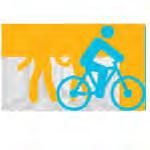

IMPROVE YOUR SLEEP
BENEFITS OF PHYSICAL ACTIVITY

REDUCE YOUR STRESS
Type 2
by up to 30%

All-cause Mortality by up to 30% Depression by up to 30%


Breast Cancer by up to 20%
Colon Cancer by up to 30%

Regular physical activity reduces your risk of

FIGURE 15: Benefits of physical activity.
Data Source: Loh, T. H., Leinberger, C. B., & Chafetz, J. (2019). Foot Traffic Ahead: Ranking Walkable Urbanism in America’s Largest Metros 2019.



Cardiovascular Disease by up to 35%
Hip Fractures by up to 63%
Dementia by up to 30%




Adults should aim for at least...
150 minutes of
Moderate Intensity Activity
across the week
Adults should aim for at least...
75 minutes of
across the week

1 1
1 in 4 ADULTS
1 in 10 1 in 5

Proportion of U.S. adults ages 18 years or older who met the guidelines.
1 in 3

HIGH SCHOOL STUDENTS
Vigorous Intensity Activity OR HOW TO ACHIEVE THE GOAL?

Proportion of U.S. high school students who met the guidelines. of the weekly recommended 150 minutes of moderate intensity mile of walking each day 1 mile 1 mile mile of biking each day of the weekly recommended 75 minutes of vigorous intensity activity
2/3 1/2
FIGURE 16: Physical activity guidelines.
Data Source: Physical activity guidelines for americans, 2nd Edition.

THE PROCESS
THE PROCESS
Analyze Network Connectivity Review Previous Plans 1
Identify Important Destinations
Understand Road Conditions
Assess Level of Traffic Stress
Inventory Existing Infrastructure
Review Previous Plans
Map Previously Proposed Networks
EXISTING CONDITIONS NETWORK ANALYSIS
2
3
Organize a Framework: Loops
Identify Gaps to Fill
Consolidate Gaps into Projects
Prioritize the Projects
Assess Before & After Connectivity
FIGURE 17: The process for the connectivity analysis.
EXISTING CONDITIONS

Identify Important Destinations
The first step is to determine the places that people want to get to and where they are coming from. This will inform all of the decisions that come afterwards.
Pages 44-57
Understand Road Conditions
We must assess the existing state of the roads that we will be studying in order to get a clear picture of what is lacking and what can be improved.
Pages 58-79


!!Analyze Level of Traffic Stress
Next we analyze the level of stress that people would experience by walking or biking in the road. With a simple binary system of comfortable or stressful, we can identify streets that are ready to be activated.
Pages 80-85
Inventory Existing Infrastructure
Next we inventory the existing pedestrian and bicycle infrastructure. This gives us a clear picture of what has already been done and what needs to be upgraded.
Pages 86-95


Identify Connection Opportunities
Finally we explore the natural features that make Douglasville beautiful, searching for connection opportunities we would otherwise miss by focusing solely on the roadway network.
Pages 96-105
NETWORK ANALYSIS
Review Previous Plans
To begin analyzing the network, it is best to start by understanding the analyses that have come before. In this section, we review 20 previous plans commissioned by the City of Douglasville to gain an understanding of the overall vision. We also pull out the pedestrian and bicycle recommendations from each plan and map them.
Pages 110-147
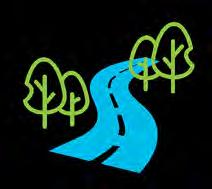
Map Previously Proposed Networks


Then we take all of the pedestrian and bike infrastructure that has been proposed in all of the reviewed plans and blend them. These maps represent the composite vision for pedestrian and bike infrastructure that has been built over the past 30 years in Douglasville.
Pages 148-157
Analyze Network Connectivity
Finally, through an innovative process developed for this plan, we analyze the connectivity of the network in a variety of different ways. Heatmaps are produced that depict at a glance the areas in Douglasville that are well-connected, which allows us to target the corridors that will be impactful to the citizens of Douglasville.
Pages 158-187


Organize a Framework: Loops
Robust transportation consist of loops at varying scales. We propose a framework for recommendations that aims to create such loops in Douglasville.
Pages 192-203
Identify Gaps to Fill
With the connective corridors and the gaps in the transportation network mapped, we identify the gaps the need to be filled in order to achieve connectivity.
Pages 204-217
Consolidate Gaps into Projects
Using all of the information that we have amassed, we consolidate the gaps that need to be filled into122 projects that should be implemented in Douglasville to achieve a more active future.
Pages 218-245
Prioritize the Projects
Projects will be prioritized according to a variety of factors. The goal is to identify the projects that will do the most for the City’s dollar.
Pages 246-291
1

2 3
Assess Before & After Connectivity
Finally, we take the final condition network and analyze its connectivity in the same way we analyzed the existing network. This makes it clear that implementing our recommendations will positively impact connectivity.
Pages 292-305


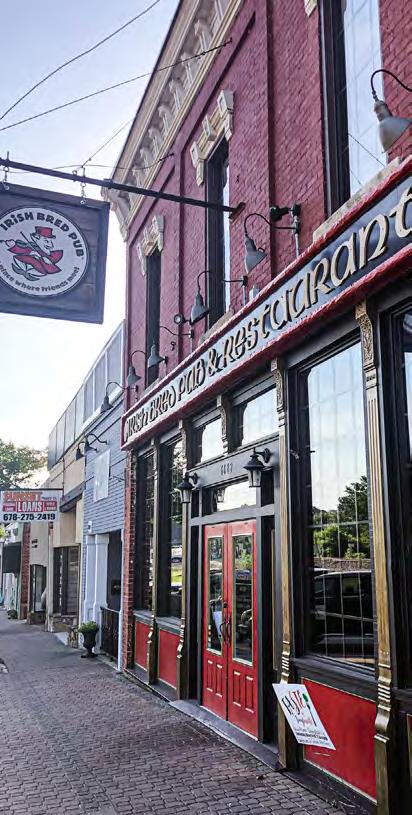


THE PROCESS PART I
EXISTING CONDITIONS
1.0 Existing Conditions Overview 42-43
1.1 Where do people need to go? ...................................... 44-45 Population and Job Density ...................................... 46-49 Destinations of Interest ............................................... 50-57


1.2 Road Characteristics 58-63 Citywide Road Characteristics ................................. 64-73 Downtown Road Characteristics ............................. 74-79
1.3 Level of Stress Analysis ................................................... 80-85
1.4 Existing Infrastructure ...................................................... 86-87 Existing Pedestrian Infrastructure .............................. 88-91 Existing Bicycle Infrastructure .................................... 92-95
1.5 Connection Opportunities 96-105

1.0 EXISTING CONDITIONS OVERVIEW
The first step of this Connectivity Plan is to understand the conditions that exist in Douglasville today. In this chapter, we take inventory of all the things that matter for connectivity.
We begin by discussing the destinations that people need or want to get to. We survey where people live, because people’s homes are arguably the most important place in any network. Then we survey where people work and go to school, those being the two destinations that people go to almost every day. Finally, we survey the common destinations that people wish to go, places like parks, post offices, and banks.
STEP
What
STEP 2
are the characteristics of the roads that connect these places?

Next, we survey the existing bicycle and pedestrian infrastructure. We have a series of maps detailing existing sidewalks and bicycle infrastructure, as well as where pedestrian and bicycle facilities are missing. This step is critical as we move forward to understand where gaps exist and need to be filled.
STEP 4
What natural features provide connection opportunities?


1
What places are important to people that need to be connected?
With those places in mind that people want to go, we begin surveying the existing road conditions. We are interested in three characteristics: the volume of through traffic, the number of lanes, and the posted speed limit. These characteristics will provide a sense of how comfortable each of these roads is for people who choose not to be in a car.

STEP 3
What pedestrian & bicycle facilities already exist in Douglasville today?
Finally, we explore the natural features of Douglasville to look for connection opportunities. Features such as streams, equal elevation ridgelines, and powerline easements have untapped potential to provide connections that cannot be achieved by looking at the road network alone. Furthermore, we will zoom out to the regional scale to get a sense of how Douglasville fits into the greater Metro Atlanta active transportation system.
FIGURE 18: Steps in the existing conditions inventory.


COMMERCIAL


WORKPLACE & SCHOOL





RESIDENTIAL


INSTITUTION SERVICE

GREEN SPACE
FIGURE 19: Relationship between destinations.
WHERE DO PEOPLE NEED TO GO?
1.1 WHERE DO PEOPLE NEED TO GO?
In order to study the connectivity of a city, one must begin with what needs to be connected. We believe that three places are fundamentally important to people: the home, the workplace, the school, and other common daily destinations.
Home
Every trip starts from the home. As such, residences are critically important to the connectivity of a transportation network. One needs to be able to start at point A and get all the way to point B along comfortable infrastructure.
Workplace & School
The second most important place for a transportation network is the workplace and school. The typical worker will make two trips involving work per day, meaning 10 trips over the course of the week. For those workers to make trips to work by foot or by bike, there must be infrastructure that continuously and comfortably connects to school and the workplace.
START!
Destinations
The third most important places for successful transportation networks are scattered about town in the variety of places that people use on a daily basis. These are places like the post office, the bank, or the park - places that people don’t necessarily use every day like home or work but are nonetheless important for leading a healthy and interesting life.
FIGURE 20: Destinations of interest to people.
POPULATION DENSITY - WEST DOUGLASVILLE

LOCATION KEY MAP
All along Chicago Avenue from the north side of town to West Pines Golf Club are many burgeoning single-family residential communities.
The Arbor Parkway area houses a great number of people in Douglasville. With good, yet quiet, through-roads and great access to retail, this area will be important to provide connectivity.

High Low
Many people live in the area surrounding the New 92 bypass to the north of the railroad , and this number will only increase once the bypass is open.
The Chapel Hills Golf Club Community at the far south edge of town houses many people.

FIGURE 21: West Douglasville population density.
JOB DENSITY - WEST DOUGLASVILLE

LOCATION KEY MAP
Downtown Douglasville, with its variety of shops, restaurants, and government institutions, is the third largest job center in West Douglasville.
Anchored by Arbor Place Mall, the south side of Douglasville has lots of retail stores and accompanying jobs.

Wellstar Douglas Hospital and the many specialized practice offices that reside in the same area represent many of the jobs in Douglasville.

FIGURE 22: West Douglasville job density.
POPULATION DENSITY - EAST DOUGLASVILLE

LOCATION KEY MAP
The Kensington Park housing development, at the northwestern edge of the Sweetwater Creek, will only house more people as houses are bought.
Sweetwater Creek Apartment Homes is a multi-family housing development that resides along the banks of the creek.

This development along Riverside Parkway, also called Tributary, is equally important to be connected to Sweetwater Creek State Park.
The Tributary development, one of only two housing developments that currently exist along Riverside Parkway, has many people that enjoy its well-gridded street network.
High Low

FIGURE 23: East Douglasville population density.
JOB DENSITY - EAST DOUGLASVILLE

Many businesses exist in this loop along State Route 6 just south of I-20.

LOCATION KEY MAP High Low
Many shipping warehouses exist along Riverside Parkway because of its strategic logistical position.

FIGURE 24: East Douglasville job density.



DESTINATIONS OF INTEREST







WALMART
MERCER UNIVERSITY
CLASSIC PAINTBALL


COBB COUNTY
BLAIRSBRIDGERD


SHAWNEE LAKE
DOUGLASVILLE POLICE DEPT
MIDWAY VILLAGE SHOPPING CENTER
INGLES



RIVERSIDEPKWY
FULTON COUNTY
AMERICAN RED CROSS
























































































































































































































































































































LEGEND
NS RAILROAD ROADS

















SCHOOLS GROCERY INSTITUTIONS ATTRACTIONS
RETAIL STORE DOWNTOWN




















































































































































































































































































DOWNTOWN DOUGLASVILLE

NS







DESTINATIONS OF INTEREST

































RETAIL













































































































































































































































































FUTURE TOWN GREEN
The former County jail site, sitting derelict at the northwestern corner of downtown, will be demolished and rebuilt into the gem in Douglasville’s crown. The Future Town Green will create a gathering space for the citizens of Douglasville to come and relax, listen to concerts, and generally recreate.


O’NEAL
PLAZA
WORTHAN PARK
This park is an asset to the surrounding community. One of only two pocket parks in the downtown area, and positioned at the gateway to the north side of town, Worthan Park will be an important piece of the future of the old SR 92 corridors.
This pedestrian plaza is a glimpse into Douglasville’s future. Ripe with attention to detail and beautiful features, O’Neal Plaza is the first step in a people-oriented renaissance for downtown.


CONFERENCE CENTER
Nestled amongst the City’s governmental buildings and the parking deck, Douglasville’s new conference center is the perfect gathering place for business to take off.
OLD COURTHOUSE MUSEUM
This historic site is a key part of the original delineation of Douglasville’s city limits. According to the original charter: “The center shall be a point directly opposite the court house in said town, on the Georgia Western Railroad, thence running along the center of said road each way three-fourths of a mile, and extending one half mile each way from the center of said road, the form of said territory to be an oblong square.” The old courthouse has been re-purposed into a museum about Douglasville’s storied past.

OLD COTTON MILL
Built in 1897, the cotton mill was a huge economic driver for the young city of Douglasville. In recent years it stopped producing and had been abandoned up until it burned down in a fire in 2012. The City is currently cleaning up the debris in preparation for what comes next...

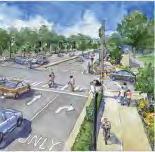
NEW SR 92
MILL VILLAGE PARK
The Mill Village Park is a success story in neighborhood pocket parks. Sitting on three acres in downtown’s Mill Village area, this park sports an outdoor basketball court, a gathering pavilion, a playground, barbecue grills, and picnic tables. It is the perfect spot for family gatherings in the downtown area.
Currently, State Route 92 runs right through the heart of downtown Douglasville. This has proven to be a problem from both the City’s and GDOT’s perspective, so they agreed to build a bypass for S.R. 92. As part of this project, GDOT installed a multi-use path along the roadway to make the New 92 a multi-modal highway that would help with the micro-connectivity of Douglasville.


CULTURAL ARTS
TASTE OF DOUGLASVILLE
Taste of Douglasville is the City’s most popular event annually. The event showcases local restaurants and businesses and includes performances on the O’Neal Plaza Stage. Admission is free and a ticket to taste is only $1.
COUNCIL
The Cultural Arts Council located in downtown Douglasville facilitates events which foster the enjoyment of and the participation in the arts among residents of and visitors to Douglasville. The Council offers a myriad of classes including drawing, printmaking, and photography, as well as offering art camps and other family-oriented art events.




















DOWNTOWN DOUGLASVILLE

NS RAILROAD ROADS









DESTINATIONS OF INTEREST

INSTITUTIONS

ATTRACTIONS










RETAIL STORE























































































































































































































































































ROAD CHARACTERISTICS




1.2 ROAD CHARACTERISTICS
With those places in mind that people want to go, we’ll begin surveying the existing road conditions. We are interested in three characteristics: the volume of traffic moving through, the number of lanes, and the posted speed limit.
VOLUME
The volume of cars, measured in Average Annual Daily Traffic (AADT), gives us an idea of how many cars drive on the specific road.



ROAD CHARACTERISTICS INDICATE LEVEL OF STRESS
POSTED SPEED LIMIT
The speed limit and the design speed of the road are closely related and they help determine the typical speed of cars expected along the road.

NUMBER OF LANES
The more lanes on a road, the more uncomfortable it feels for people on foot or on bike.
The first part of this section will provide a brief overview of the road types that will be surveyed. What follows is a selection of roads in Douglasville along with the characteristics of those road types. Finally, this information is distilled into “Level of Stress” maps that designate identified corridors as either comfortable or uncomfortable for a typical adult on foot or on a bike.
FIGURE 25: Important road characteristics.

LOCAL ROADS
Most roads in Douglasville maintain a rural, local character. This is one of Douglasville’s greatest strengths - quiet, slow, and beautiful streets are the lifeblood of any town with rural settings The streets that follow this typology include but are not limited to:
• Parker Street
• Melrose Street
• Johnson Street
• Pinecrest Drive
• Colquitt Street
• Duncan Street
• Estelle Street
• Parkway Circle
• Clark Street
• Park Street
• Haynes Street
• Upshaw Lane
• Price Avenue
• Adair Street
• Duncan Street
• Katherine Street
• Maxwell Street
• Dorsett St
• Connally Drive
• Cooper Street
• Hagin Street
• Courltand Street
• Mozley Street
• Front Street
• Grady Street
• James Street
• Spring Street
• Bowden Street
Streets such as these are an asset waiting to be utilized. Their quiet character, low traffic volumes, and low traffic speeds allow people to walk and ride their bikes in the road. These are called yield roads, wherein all user types share the road equally at slow speed. By recognizing these streets as an asset and connecting them across larger, more hostile thoroughfares, Douglasville can accelerate the push towards active transportation.



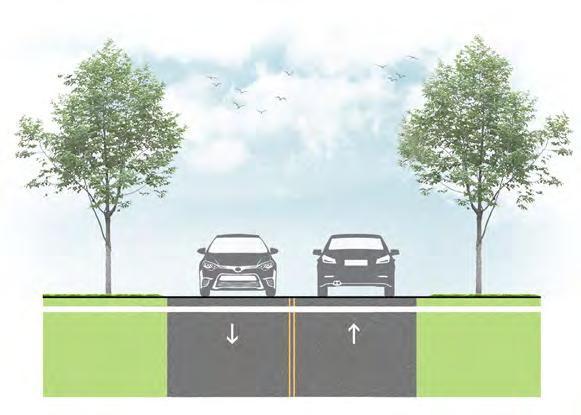


These streets are two standard travel lanes, one in each direction, with no paved shoulder and varying ROW. Buildings are typically set back from the road by at least 100’, if there are buildings along the road at all. Often, only undeveloped woodland fronts these roads.
Protecting the character of these roads is crucial to Douglasville’s future success. If left unchecked, development could turn these quiet rural roads into larger, noisier, and less hospitable thoroughfares. By guiding development to maintain the rural character and adding pedestrian and bicycle facilities, these rural roads will become a reliable network for active transportation users.
PARKER STREET
COLQUITT STREET
MELROSE STREET
PINECREST DRIVE
JOHNSON STREET
FIGURE 26: Most common Douglasville street cross section.

COLLECTOR ROADS


Many major collectors such as Stewart Mill Road and Slater Mill Road (pictured here at right) are still two lanes and rural in character, but they exhibit higher traffic volumes and speeds. Mixing modes of traffic along these roads is not advisable. But again, it is paramount that the rural, winding, and naturally beautiful character of these roads is preserved and enhanced in any transportation recommendations. Fortunately, most of these roads have wide rights-of-way, which makes them perfect for shared-use paths that follow the road at a comfortable distance. Major collectors identified include:
• Stewart Mill Road
• Slater Mill Road
• W Stewart Mill Road
• Pope Road
• Timber Ridge Road
• Bright Star Road
• Cave Springs Road
• Timber Ridge Drive
Neighborhood collector streets such as Grace Lake Drive and Creekwood Drive (pictured here at left) form the backbone of the transportation system for the neighborhoods in Douglasville. Relative to larger thoroughfares, these roads maintain lower traffic volumes and speeds. Preserving this aspect of such roads is the priority. Any recommendations along neighborhood collectors will involve enhancing this aspect through techniques that slow drivers down and signal to pedestrians and cyclists that they are welcome to use the road. These streets include:
• Grace Lake Drive
• Creekwood Drive
• Parkway Circle
• Parkway South
• Huey Road
• Chapel Crossing Road
• Warren Road
• Colquitt Street
• Big B Road


GRACE LAKE DRIVE
CREEKWOOD DRIVE
STEWART MILL ROAD
SLATER MILL ROAD

SERVICE ROADS
As a city with a rural setting, Douglasville has many former roads and informal trails that present a great opportunity to be repurposed into trails. These rights-of-way, such as Gurley Road (pictured at right) which leads out from Hunter Park, are already cleared and gravel has been laid, which makes it primed and ready for a greenway trail through the woods. By taking advantage of these opportunities that are dotted around Douglasville, the City can accelerate the construction of its active transportation network. Furthermore, these natural gems will play off Douglasville’s existing natural beauty by allowing people to get outside and travel through the woods.


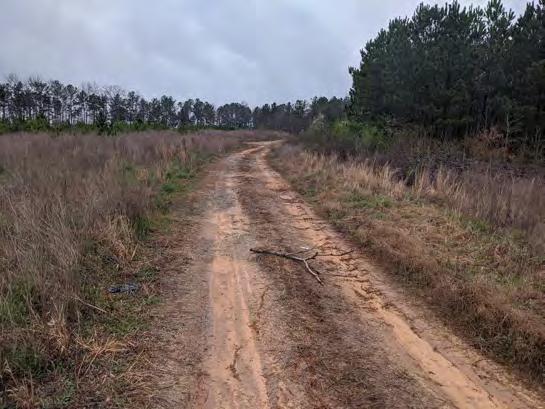


GURLEY ROAD
OLD DORRIS ROAD
OLD CONCOURSE PARKWAY
TRAIL NEAR BRIGHT STAR ROAD
OLD DALLAS ROAD

ARTERIALS AND LARGER ROADS
The remaining roads in Douglasville are larger roads that have more than two lanes. Typically these roads are thoroughfares meant to transition from the traffic volumes typically seen on the highway to the lower speeds and volumes that are expected on Douglasville’s local roads. These roads are also often found in areas with high business density, such as in and around the Arbor Place Mall area. Such roads are characterized by many lanes, high traffic volumes, and oftentimes sparse active transportation facilities.


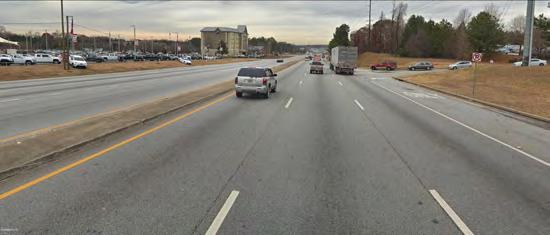


DOUGLAS BOULEVARD
BRIGHT STAR CONNECTOR
THORNTON ROAD
FAIRBURN ROAD
BILL ARP ROAD










DETAILED

FAIRBURNRD
This is a map of the corridors that will be depicted in the following pages. Each corridor will be described by the cross section, the number of lanes, the AADT, and a picture. AADT is measured by counting the volume of traffic on a road over a period of time, extrapolating that volume to the total volume over a whole year, and then dividing that yearly volume over 365 days. AADT is a rough measure of volume, and does not necessarily capture nuances such as the difference between regular volume and peakhour volume.







OUTSIDE CITY LIMITS
STATE
NS RAILROAD
INTERSTATE ROADS
DETAILED ROAD CONDITIONS

KEY MAP OF ROAD CONDITIONS






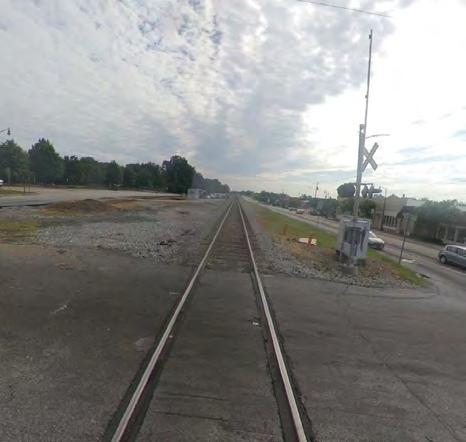









OUTSIDE CITY LIMITS
STATE
NS RAILROAD
INTERSTATE ROADS
DETAILED ROAD CONDITIONS

KEY MAP OF ROAD CONDITIONS














OUTSIDE CITY LIMITS
STATE
NS RAILROAD
INTERSTATE ROADS
DETAILED ROAD CONDITIONS

KEY MAP OF ROAD CONDITIONS








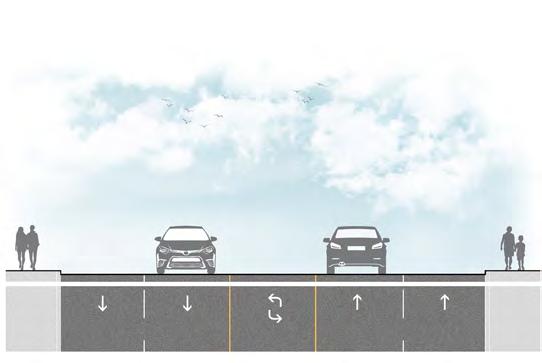



















LEGEND
OUTSIDE CITY LIMITS
STATE PARK
NS RAILROAD
INTERSTATE ROADS
DETAILED ROAD CONDITIONS

KEY MAP OF ROAD CONDITIONS







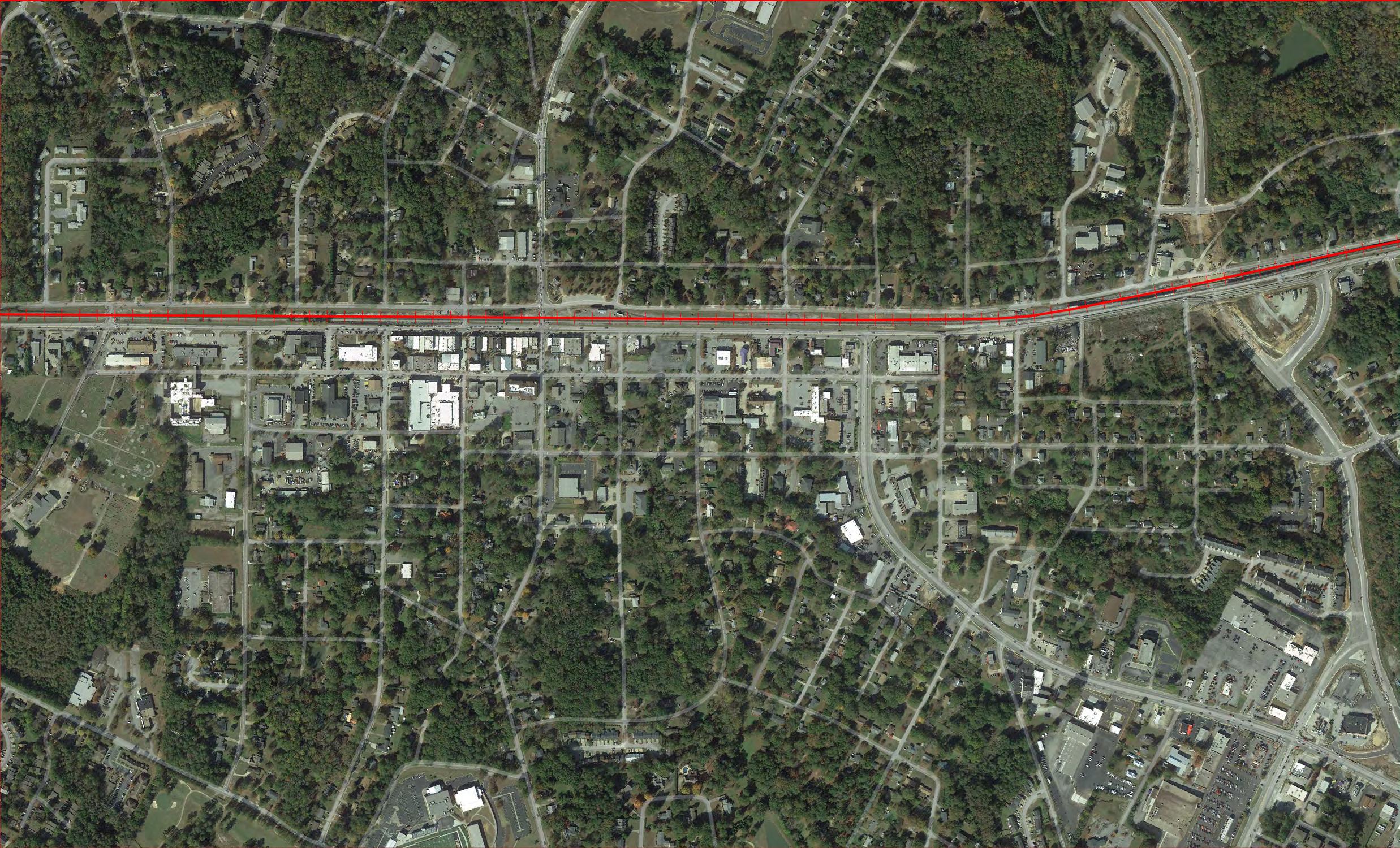



COLQUITTST
This is a map of the downtown corridors that will be depicted in the following pages. Each corridor will be described by the cross section, the number of lanes, the AADT, and a picture. AADT is measured by counting the volume of traffic on a road over a period of time, extrapolating that volume to the total volume over a whole year, and then dividing that yearly volume over 365 days. AADT is a rough measure of volume, and does not necessarily capture nuances such as the difference between regular volume and peak hour volume.



KEYMAP OF ROAD CONDITIONS



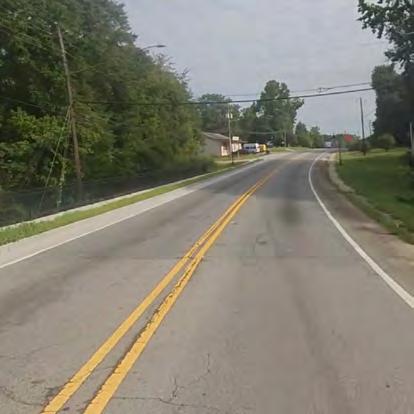

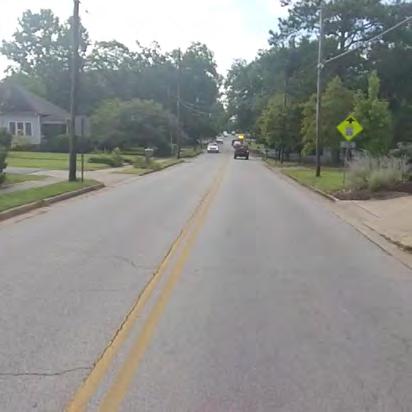










KEYMAP OF ROAD CONDITIONS





SPRINGSTREET







LEVEL OF STRESS ANALYSIS !!
1.3 LEVEL OF STRESS ANALYSIS
Traditional analyses of Level of Traffic Stress (LTS) take into account a variety of variables to partition streets into four different categories. LTS 1 is considered the most comfortable for any and all users. These are facilities such as wide cycle tracks and shareduse paths. LTS 4 is considered virtually untraversible for anybody. These are high volume, high speed thoroughfares that have no bike facilities and are generally very hostile to people outside of motor vehicles. The two levels in between are shades of grey. This traditional analysis fails in that it attempts to describe a qualitative phenomenon (comfort) by assessing quantitative metrics (traffic volume & speed, facility type).
Instead, we took a simpler approach. We had our bicycle expert ride the streets in Douglasville and assess them on a binary scale - would an adult bicycle novice feel comfortable riding on this road or not? This yields a useful map that depicts the islands of lowstress connectivity that are separated by higher-stress roadways. These low-stress streets exist all throughout Douglasville in the form of quiet, local neighborhood roads. By targeting high-stress roads for infrastructure improvements, we can augment the existing system to quickly reach a fully connected network.
UNCOMFORTABLE
DENOTED IN RED ON FOLLOWING MAPS


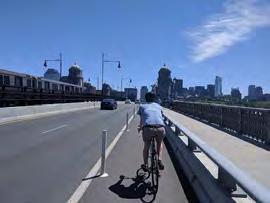
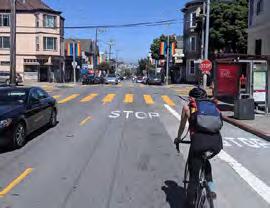
The roads depicted above are generally uncomfortable for active transportation. Typically, these roads are characterized by mixed conditions with lots of fast motor traffic. Sometimes the addition of a facility does not lower the stress level. In the top right image, a 5’ bike lane with bollards technically qualifies as a comfortable, protected bike facility. However, for reasons that are difficult to quantify, it is highly uncomfortable to ride here.

FIGURE 27: Typical map produced from Level of Stress Analysis.
Data Source: FHWA Multimodal Connectivity Performance Measures. Notice that there are “islands” of low-stress connectivity that are bisected by higherstress thoroughfares. By targeting those thoroughfares, we can connect islands of low-stress, which will yield a more connected network for the effort.
COMFORTABLE
DENOTED IN GREEN ON FOLLOWING MAPS




By contrast, the roads depicted above are generally comfortable for active transportation. The top left and right facilities are so comfortable that people could walk along them. The bottom two images are counterintuitively comfortable. Technically the volume (for the left image) and speeds (for the right image) indicate a high-stress level, but experience finds that these roads are incredibly comfortable and beautiful to ride upon.

EXISTING LOW STRESS CORRIDORS
CITY OF DOUGLASVILLE
LEGEND




DALLAS HWY




CAMPBELLTONST
CHICAGOAVE ROSE AVE NEW92
BLVD

FAIRBURNRD

DOUGLAS
CHAPEL HILLRD BILLARPRD
Typical Traffic Stress analyses designate each corridor into one of four levels. These levels correspond with the user types that were identified at the beginning of this document. Our analysis is different in that there are only two levels of traffic stresswould the average adult feel comfortable riding on the road or not? The corridors depicted in green on this map are corridors that present characteristics where the average adult would feel comfortable riding a bike on the road.
*NOTE: Stress level based on expert assessment.

BRIDGERD BLAIRS THORNTONRD





COBB COUNTY
FULTON COUNTY
RIVERSIDE PKWY

CITY OF DOUGLASVILLE
- LEVEL OF STRESS CONDITIONS

CHICAGOAVE

CAMPBELLTONST DALLAS



FAIRBURNRD





DOUGLAS BLVD
CHAPEL HILLRD BILLARPRD
The corridors in red on this map are generally inhospitable to people walking or biking on the road in their existing condition. *NOTE: This map does NOT take into account any existing facilities. These designations only refer to the level of stress that pedestrians and cyclists would experience if they walked or biked in mixed-traffic with motor vehicles. NOTE: Stress level based on expert assessment.


BRIDGERD BLAIRS
THORNTONRD




COBB COUNTY
FULTON COUNTY
RIVERSIDE PKWY
EXISTING INFRASTRUCTURE
1.4 EXISTING INFRASTRUCTURE
Next, we take inventory of all the different pedestrian and bicycle infrastructure that exists in Douglasville today. This includes sidewalks, bike lanes, sidepaths, multi-use paths, trails, etc. For sidewalks, we will also assess where sidewalks exist and where they are missing.
The maps on the following pages depict the sidewalk network and the bicycle facility network that exist on the ground today. Following are a few main takeaways.
PEDESTRIAN
Historic downtown is the only area that is reliably connected (with a few exceptions, such as Spring Street). Elsewhere, coverage is intermittent. There are many corridors that were recommended to have sidewalk infrastructure on both sides in the LCI plans, but ended up receiving sidewalks on only one side of the street due to funding constraints. Campbellton Street is an example of this.
There are some places in Douglasville where a sidewalk abruptly ends or where enough people have walked in the grass to wear a “goat path” or “desire line.” These areas are prime targets for new walking infrastructure.
Other roads, such as Hospital Drive at right, have sidewalks that end abruptly. These spots are also important targets to follow through with complete connectivity.
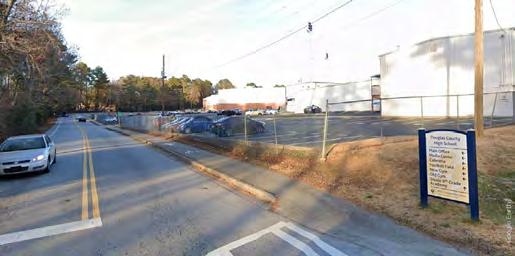


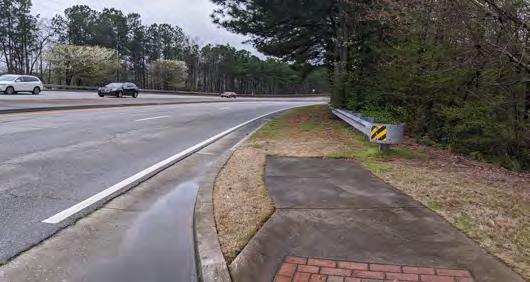
BICYCLE
There are only two bicycle facilities existing in the City of Douglasville – one is on Selman Drive near Douglas County High School, and the other is along the extent of Riverside Parkway between SR 92 and SR 6.
The Selman Drive bicycle facility is often referred to as a Multi-Use Path, but it does not technically meet these requirements. For the length along Selman Drive, the facility is a bike lane, with one short segment on one side being a sidewalk. The bicycle marker is fading in most places. The segment on Selman Avenue (seen at left) meets the definition of a raised bike lane moreso than a shared-use path. It does not exist on the west side of the road.
Riverside Parkway can be considered dangerous for the casual bicycle rider. Although these enhanced bike lanes check the boxes (painted green in conflict zones, wellsigned, 5’ min width), the facility exists unprotected on a high-volume, high-speed thoroughfare. Although a step in the right direction, this facility has the potential for an upgrade.
Riverside Parkway has bike lanes all along its length, but vehicular speeds and truck volumes are too high for a comfortable ride.
Selman Avenue/Drive has bike lanes and one raised bike lane on the Douglas County High School side of the road.
The downtown area is almost fully connected with sidewalks. Many of these sidewalks, such as above on Church Street, are raised.
Elsewhere, such as above on Hospital Dr, sidewalk connections are spotty and often end abruptly.

EXISTING SIDEWALK INFRASTRUCTURE
CITY OF DOUGLASVILLE

DALLAS HWY
CHICAGOAVE



CAMPBELLTONST
ROSE AVE


FAIRBURNRD


CITY LIMITS
STATE PARK
NS RAILROAD
INTERSTATE
CITY ROADS LEGEND
COUNTY ROADS
EXISTING SIDEWALK


DOUGLAS BLVD
CHAPEL HILLRD
BILLARPRD


BRIDGERD BLAIRS
THORNTONRD




FULTON COUNTY
RIVERSIDE PKWY

SIDEWALK GAP INVENTORY
CITY OF DOUGLASVILLE
CHICAGOAVE ROSE AVE


LEGEND

CITY LIMITS
STATE
INTERSTATE
COUNTY ROADS
CITY ROADS




EXISTING SIDEWALKS
MISSING SIDEWALKS
CAMPBELLTONST

FAIRBURNRD


DOUGLAS BLVD
CHAPEL HILLRD
BILLARPRD
The red lines here indicate missing sidewalks along the corridors that were surveyed during the course of this study. These red lines are not necessarily gaps that are recommended to be filled - they are only existing gaps in the existing sidewalk network.


BRIDGERD BLAIRS
THORNTONRD




COBB COUNTY
FULTON COUNTY
RIVERSIDE PKWY


EXISTING BICYCLE NETWORK
CITY OF DOUGLASVILLE

DALLAS HWY
CHICAGOAVE

BILLARPRD




CITY LIMITS
STATE PARK
NS RAILROAD
INTERSTATE
CITY ROADS LEGEND
COUNTY ROADS
ROSE AVE NEW92

CAMPBELLTONST
DOUGLAS BLVD

FAIRBURNRD
CHAPEL HILLRD


BRIDGERD BLAIRS
THORNTONRD



FULTON COUNTY
RIVERSIDE PKWY

BICYCLE LEVEL OF STRESS NETWORK
CITY OF DOUGLASVILLE
LEGEND

CHICAGOAVE


CITY LIMITS


CAMPBELLTONST DALLAS HWY



FAIRBURNRD
EXISTING BICYCLE FACILITY
LOW-STRESS CORRIDORS
HIGH-STRESS CORRIDORS
INTERSTATE


DOUGLAS BLVD
CHAPEL HILLRD BILLARPRD
Because bicycles are designated as vehicles in the State of Georgia, it is appropriate to include the level of stress of the road system in the assessment of existing infrastructure. The existing facilities along Selman Drive and Riverside Parkway are depicted here over the original high-stress designations to indicate that the infrastructure lowers the stress of that roadway to a permissible level.

BRIDGERD BLAIRS
THORNTONRD





COBB COUNTY
FULTON COUNTY
RIVERSIDE PKWY
CONNECTION OPPORTUNITIES


1.5 CONNECTION OPPORTUNITIES
The final stop in our survey of Douglasville’s existing conditions is a look at the opportunities that can be utilized.
The first opportunity is the many streams and rivers that run through Douglasville. Sweetwater Creek is the most important of these, but there are many others such as Little Anneewakee Creek that provide the perfect opportunity for greenways that allow people to enjoy the natural beauty of these important assets.
RIDGELINES


The second opportunity lies in the ridgelines of Douglasville. It is important to take advantage of roads that provide little grade change because they make it much easier for the average person to ride their bike. The rolling hills of the Georgia piedmont can be daunting for even the most seasoned cyclist.
The third opportunity is the corridors provided by powerline easements. These corridors through rural forestland are natural candidates for trails, especially mountain bike trails. They criss cross Douglas County in such a high number that they could be instrumental in transforming Douglasville into a pilgrimage destination for mountain bikers all over the nation.
REGONAL CONNECTI

E A SEM NTS

The final connection opportunity is derived from the Atlanta Regional Commission’s vision for a regional trail network. Douglasville is positioned perfectly to take advantage of this future system, with a trail that leads from downtown Atlanta and the airport to Lithia Springs and through downtown Douglasville before getting continuing to Villa Rica.
FIGURE 28: Four types of connection opportunities.



CITY OF DOUGLASVILLE

DALLAS HWY
CHICAGOAVE ROSE AVE



CAMPBELLTONST



FAIRBURNRD

CITY LIMITS
STATE PARK
INTERSTATE
CITY ROADS LEGEND
COUNTY ROADS
DOUGLAS BLVD
CHAPEL HILLRD BILLARPRD


BRIDGERD BLAIRS
THORNTONRD




FULTON COUNTY
RIVERSIDE PKWY



CITY OF DOUGLASVILLE

DALLAS HWY
CHICAGOAVE

BILLARPRD



CITY LIMITS
STATE PARK
NS RAILROAD
INTERSTATE
COUNTY ROADS
CITY ROADS

ROSE AVE NEW92

CAMPBELLTONST
DOUGLAS BLVD

FAIRBURNRD
MINOR RIDGELINES
MAJOR
CHAPEL HILLRD


BRIDGERD BLAIRS
THORNTONRD




FULTON COUNTY
RIVERSIDE PKWY




CHICAGOAVE






CAMPBELLTONST

FAIRBURNRD
DOUGLAS BLVD
CHAPEL


BRIDGERD BLAIRS
THORNTONRD




FULTON COUNTY
RIVERSIDE PKWY



REGIONAL CONNECTION OPPORTUNITIES
CITY OF DOUGLASVILLE
This map depicts the framework for the Atlanta regional trail system as outlined in the Atlanta Regional Commission’s (ARC) supplement to the Walk.Bike.Thrive! plan entitled “Envisioning a Regional Trail Network”. Recommendations for pedestrian and bicycle infrastructure in the City of Douglasville will take these future regional connections into account. In particular, it will be important to recommend facilities that extend up north into Paulding County to connect to the Silver Comet Trail, and also facilities that extend south down to the Chattahoochee Hill Country Regional Trail. Such facilities would connect Douglasville to the greater regional network and allow for further economy-boosting connectivity that the City seeks.
The connection leading from the Camp Creek Greenway west through Lithia Springs and eventually to Villa Rica (just north of Douglasville) is unspecified in ARC’s plan. There is opportunity here for the City of Douglasville to team up with Villa Rica, Lithia Springs, and Douglas County to create a vision and proposed alignment for this future trail. Such a path will provide people from all three cities the opportunity to go on day trips to their sister cities as well as ride seamlessly to Atlanta, and even one day to the airport.




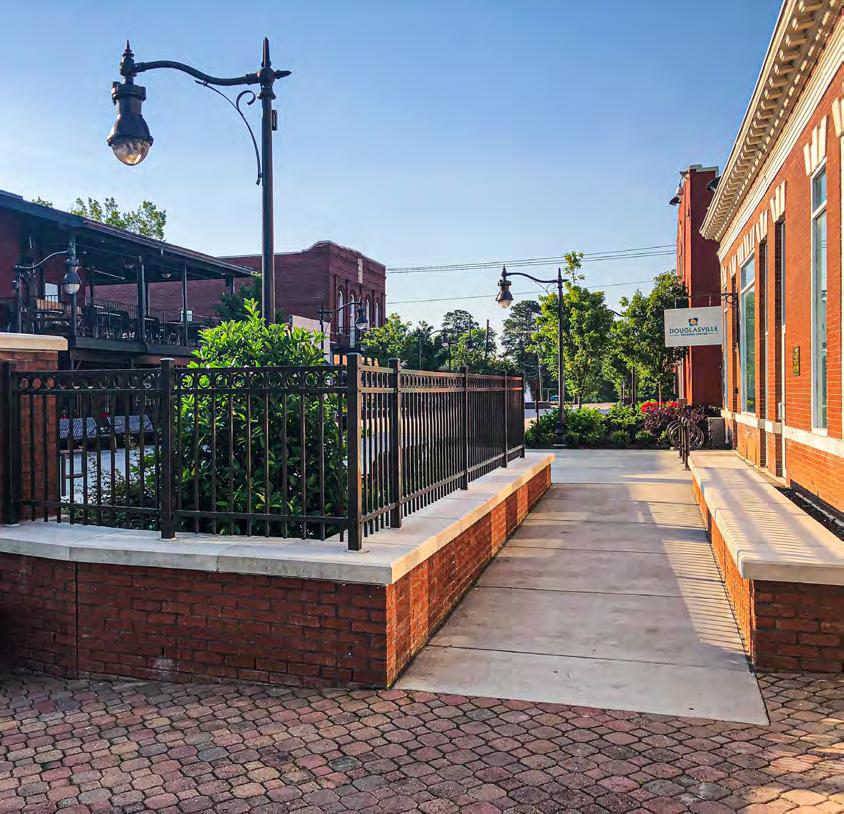
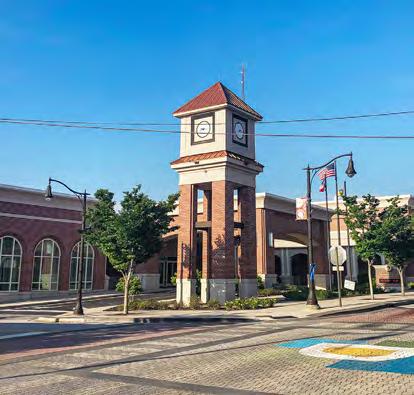
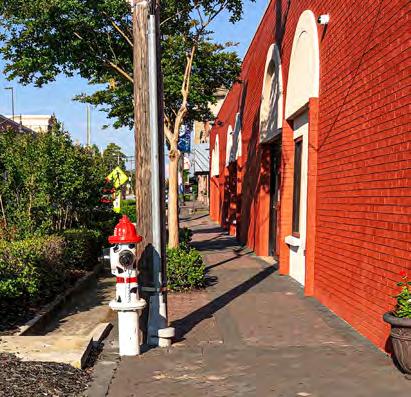


THE PROCESS PART II
NETWORK ANALYSIS
2.0 Network Analysis Overview 108-109
2.1 Review of Previous Plans ............................................ 110-147
2.2 Blended Network Maps .............................................. 148-149
Blend of Proposed Ped Networks .............................. 150-151
Blend of Proposed Bike Networks 152-153
Previously Proposed Off-Street Facilities ................... 154-155
Frequency of Proposed Corridors ............................. 156-157
2.3 Connectivity Heatmapping ....................................... 158-161
Pedestrian Connectivity Heatmaps .......................... 162-175
Bicycle Connectivity Heatmaps ................................ 176-185
Initial Priority Corridors ................................................. 186-187


Supplemental LCI Study
http://issuu.pdf-downloader.com/print.php?documentId=190124194357-7a9b30a61c79fa7e387a4edee6e4a8c7&count=120
Once all of the previously proposed pedestrian and bike networks have been mapped, we can overlay them into one map. In a certain sense, this map is a representation of the vision for pedestrian and bicycle connectivity that has been built up by a variety of consultants over the course of 30 years. Such a network acts as a springboard for the recommendations of this plan.
In addition to a blended network, we also count the number of times each corridor has been recommended in the past. Corridors along which pedestrian and bicycle improvements have been recommended multiple times are obvious choices for active transportation infrastructure projects.
Finally, from the blended map we pull out all of the offstreet connections that have been recommended in the past. Douglasville could be a city full of greenways and trails that would attract recreational visitors from all over the state.

The Highway 92 LCI Study recommends over 50 intersection, sidewalk, streetscape, trail, transit, and street network projects. While each project is important to the overall development concept for Highway 92, practical considerations require that each project must be phased in over time.
In 2008, the County successfully applied for a Supplemental LCI grant to develop a plan for bringing the Highway 92 LCI projects closer to implementation. The Highway 92 Supplemental LCI Study carefully considers the merits of each













Recommended LCI Vision for Highway 92
After assessing the subjective aspect of the networks through the lens of past planning efforts, the next step is to turn an objective eye to analyze the connectivity of the network. We employ a novel connectivity heatmapping methodology that counts the number of potential routes that utilize a certain segment of street from a variety of different destinations. A series of connectivity heatmaps displays this information, and highlights street segments that are highly connective and segments that are lacking connectivity.
At the end of this chapter, we will have an understanding of many different indices of connectivity, such as:
• Corridors that people are most likely to use
• Corridors that have been mentioned multiple times
• A system for Douglasville if the most ambitious projects from past plans were implemented
After studying the City from a variety of different angles and with a host of different tools, we see where Douglasville is and where Douglasville wants to be. With this knowledge under our belt, we can move forward into the recommendation stage fully apprised of the sort of future that Douglasville is striving for.
REVIEW OF PREVIOUS PLANS
2.1 REVIEW OF PREVIOUS PLANS
There have been dozens of planning efforts throughout the past 30 years in Douglasville and Douglas County. AECOM reviewed these documents and extracted the information relevant to bicycle and pedestrian infrastructure to create a series of previous plan proposed network maps on the following pages through page 155. The documents studied are the following:






















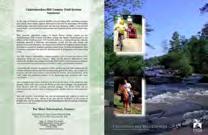









BICYCLE & PEDESTRIAN PLAN - SHORT TERM DOUGLAS COUNTY, 1993

This plan lays out an extensive county wide system. Over 40 projects are listed and detailed, including expected preliminary engineering, right-of-way, and construction costs. There are both short-term and long-term projects in this plan.
The short-term part of this plan is mapped out at right. Most of the projects recommended in the short-term part of the plan exist in and around the city limits of Douglasville. It lays out a comprehensive system of shared-use paths and trails for the part of Douglasville north of Sweetwater Creek State Park. This system extends up north to Lithia Springs.

STUDY AREA
INTERSTATE
SIDEWALKS
SHARED-USE PATH
NON-SPECIFIC CONNECTION
BIKE LANES

INTERSTATE
STATE

BIKE ROUTES/SHARROWS
SHARED-USE PATHS
NON-SPECIFIC CONNECTION

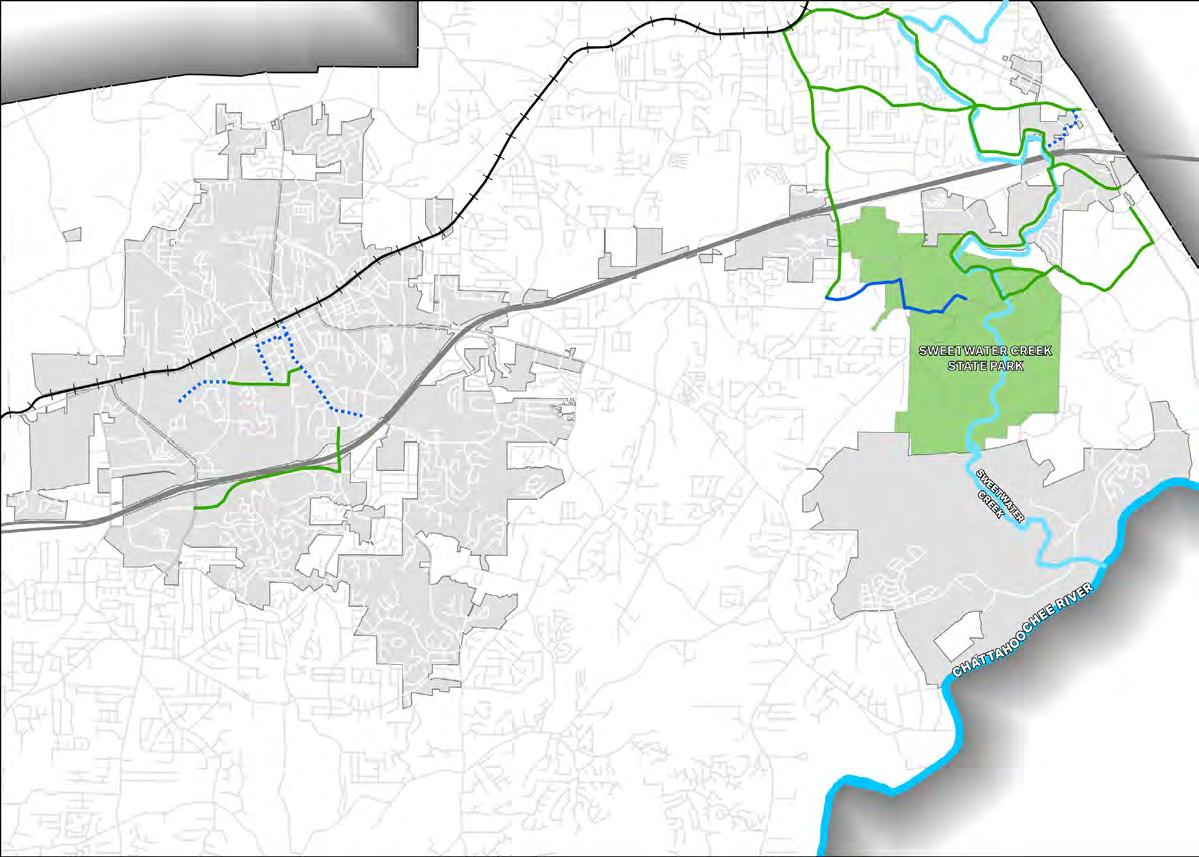

DOUGLAS BLVD
DOUGLAS
BICYCLE & PEDESTRIAN PLAN - LONG TERM DOUGLAS COUNTY, 1993

The long-term network is mapped out at right. Whereas the short-term plan remained close to the city limits, the long-term projects range all over the county. A wide-ranging system of bike lanes is recommended that connects from one end of Douglas County to another. Sidewalks are also recommended throughout the county, especially connecting to schools outside of the city limits.

STUDY AREA
STATE
INTERSTATE
SIDEWALKS
SHARED-USE PATH
NON-SPECIFIC CONNECTION
BIKE LANES

STUDY AREA
STATE

INTERSTATE
BIKE ROUTES/SHARROWS
SHARED-USE PATHS
NON-SPECIFIC CONNECTION



DOUGLAS
LIVABLE CENTERS INITIATIVE STUDY
CITY OF DOUGLASVILLE, 2001
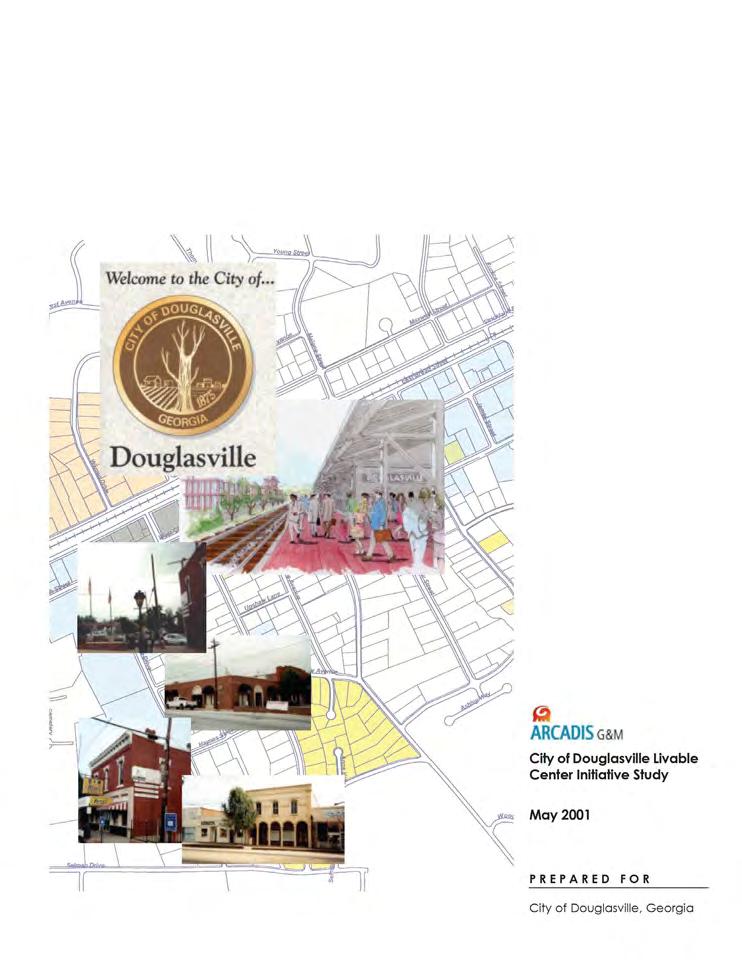
Douglasville’s first Livable Centers Initiative report presented a sweeping vision for the future of Douglasville. In addition to a pedestrian and bicycle network, the plan calls for a commuter rail station for a passenger train that goes to and from Atlanta, identifies important character areas throughout the city, and lays out a comprehensive list of policy changes that would encourage development and growth. This plan calls for a complete sidewalk network through the city, listing out dozens of specific areas that require sidewalks in order to achive this vision. It also recommends a greenway that connects Hospital Drive to the downtown area.

STUDY AREA
STATE
INTERSTATE
SIDEWALKS
SHARED-USE PATH
NON-SPECIFIC CONNECTION
BIKE LANES

STUDY AREA
STATE

INTERSTATE
BIKE ROUTES/SHARROWS
SHARED-USE PATHS
NON-SPECIFIC CONNECTION



SIDEWALK/BICYCLE/MULTI-USE PATH
PLAN
CITY OF DOUGLASVILLE, 2005

The City of Douglasville’s official Sidewalk/Bicycle/Multi-Use Path plan was adopted in 2005. Like the 2001 LCI, it calls for a complete sidewalk system to service all of Douglasville’s citizens. The sidewalks that existed at the time of adoption are mapped, providing a window into the former level of pedestrian network completeness.
Notable recommendations on this map include:
• Prestley Mill bike path - scenic route would provide much needed EastWest connectivity for bicycles
• Riverside Parkway bike path - another scenic route that provides connectivity for the eastern part of Douglasville and to Sweetwater Creek
• Sweetwater Creek trails - trails along Sweetwater Creek itself would provide people in eastern Douglasville a path to get into the park.

STUDY AREA
SIDEWALKS
SHARED-USE PATH
NON-SPECIFIC CONNECTION
BIKE LANES

STUDY AREA
STATE

INTERSTATE
BIKE ROUTES/SHARROWS
SHARED-USE PATHS
NON-SPECIFIC CONNECTION












PRESTLEY MILL ROAD CORRIDOR STUDY







































































This plan is an in-depth study of the Prestley Mill Road corridor, an important East-West connector. The study recommended two roundabouts at key intersections and a shared-use path along the length of Prestley Mill Road. This study makes it clear that this corridor is vital to connectivity in this area; without it, pedestrians and cyclists will have, at best, a patchwork way of moving from the eastern edge of Douglasville into the downtown area.

STUDY AREA
STATE
INTERSTATE
SIDEWALKS
SHARED-USE PATH
NON-SPECIFIC CONNECTION
BIKE LANES

STUDY AREA
STATE

INTERSTATE
BIKE ROUTES/SHARROWS
SHARED-USE PATHS
NON-SPECIFIC CONNECTION

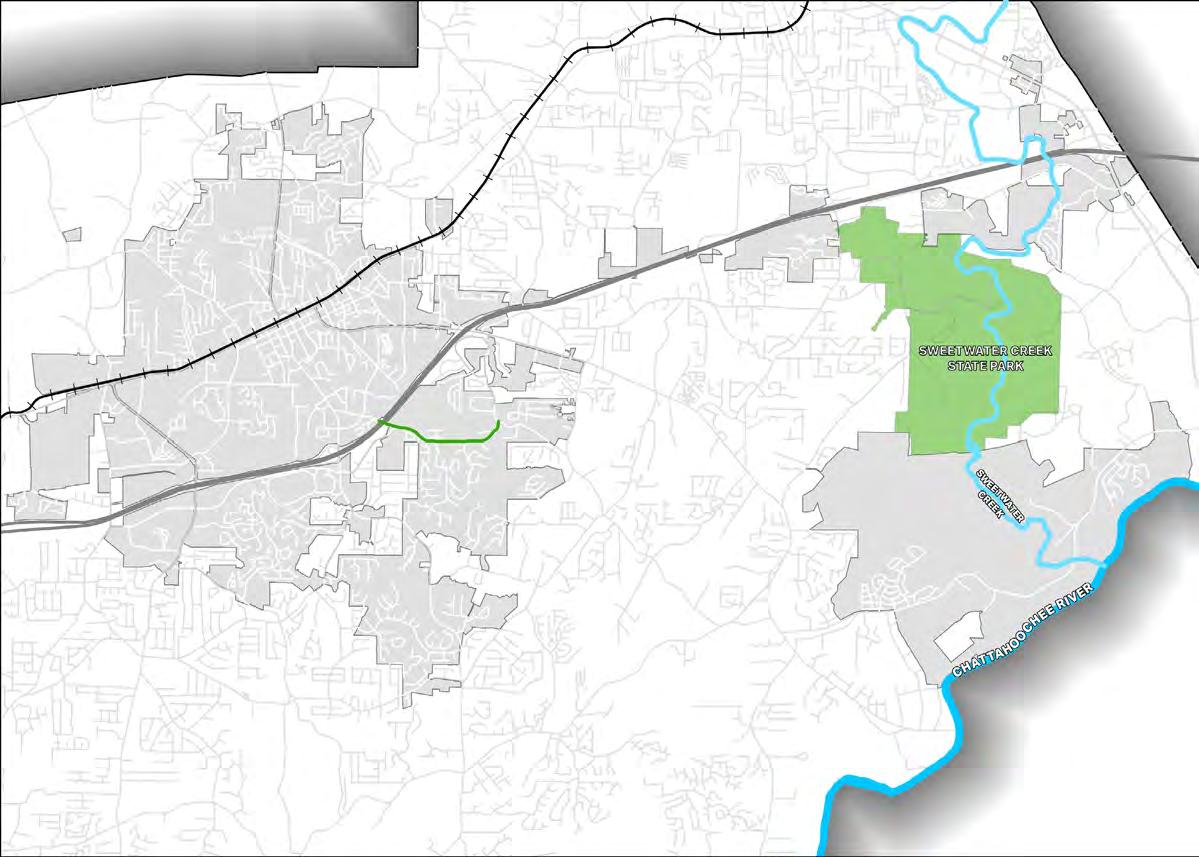

COMPREHENSIVE TRANSPORTATION PLAN DOUGLAS COUNTY, 2008

This plan takes a comprehensive account of transportation in Douglas County. It assesses traffic conditions and recommends a whole host of roadway improvement projects, targeting capacity and intersection throughput. It also recommends a robust system of pedestrian and bicycle facilities to augment the roadway system. This plan has a strong Safe Routes to School chapter, making specific mention of sidewalk connectivity in the areas surrounding schools.
The City commissioned Jacobs to conduct a supplementary Comprehensive Transportation Plan. This supplement builds off of the County’s comprehensive plan, adding roadway projects that are specifically geared towards the City of Douglasville. There are no specific pedestrian or bicycle recommendations in the City supplement.

STUDY AREA
STATE
SIDEWALKS
SHARED-USE PATH
NON-SPECIFIC CONNECTION
BIKE LANES

STUDY AREA
STATE

INTERSTATE
BIKE ROUTES/SHARROWS
SHARED-USE PATHS
NON-SPECIFIC CONNECTION

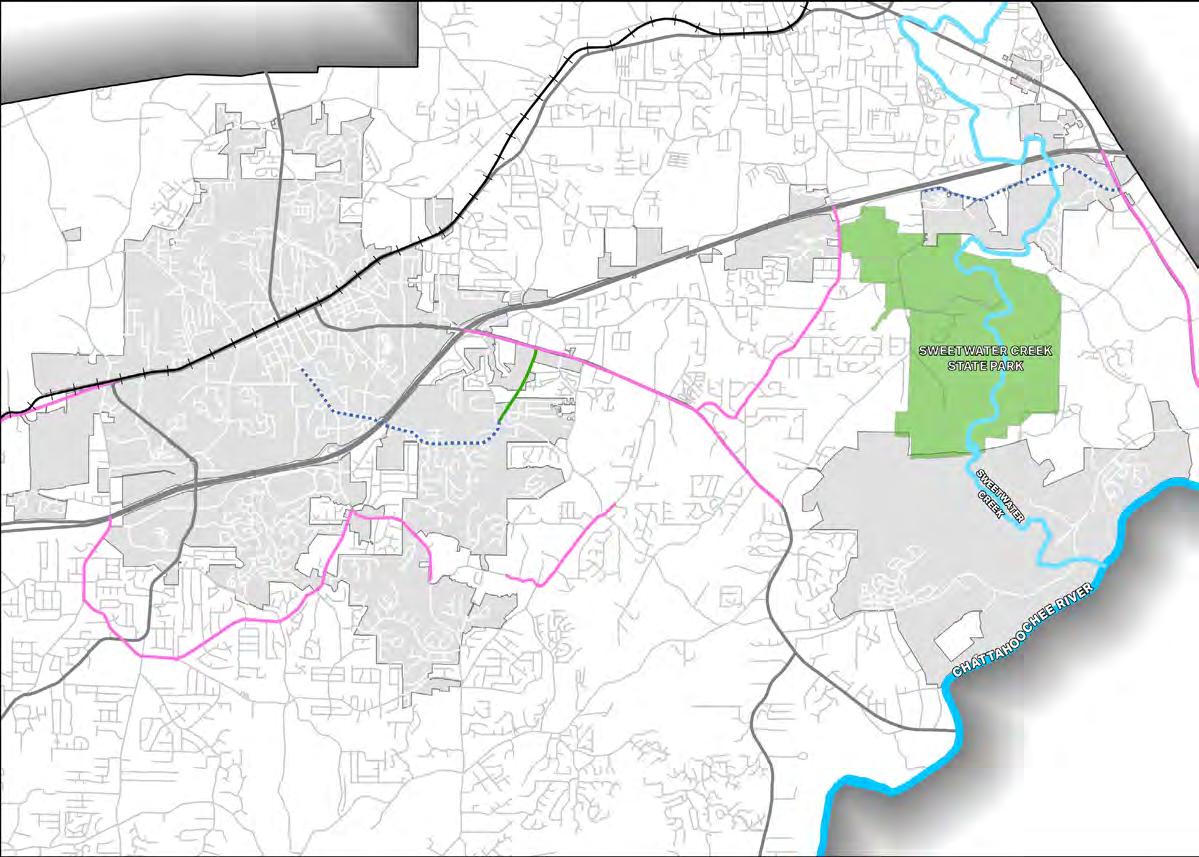

HIGHWAY 92 LCI STUDY DOUGLAS COUNTY, 2009


JUNE 2009
Prepared for: Douglas County Department of Planning and Zoning by:

The County also commissioned a Livable Centers Initiative plan, targeting the area just east of Douglasville. It lays out a vision for the area surrounding State Route 92 as it strikes out of the City of Douglasville, focusing on the intersections of SR 92 with the other roads in the area to spur nodal development. The plan details a robust network of shared-use paths that criss-cross throughout this area, permitting people of all ages and abilities to move throughout the Livable Center on foot or by bike.

STUDY AREA
INTERSTATE
SIDEWALKS
SHARED-USE PATH
NON-SPECIFIC CONNECTION
BIKE LANES

INTERSTATE
STATE

BIKE ROUTES/SHARROWS
SHARED-USE PATHS
NON-SPECIFIC CONNECTION



LIVABLE CENTERS INITIATIVE STUDY 10-YEAR UPDATE
CITY OF DOUGLASVILLE, 2011
DRAFT
City of Douglasville Livable Centers Initiative Study
10-Year Update
May 31, 2011
Prepared for: City of Douglasville
Prepared by:
Tunnell-Spangler-Walsh & Associates
Croy Engineering Marketek, Inc.









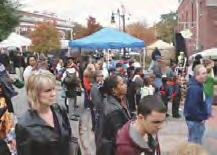



Ten years after the first Livable Centers Initiative Study, the City commissioned an updated plan. With an expanded study area, this plan aims to assess the completion of the previous LCI and outline a path moving forward. Many of the pedestrian and bicycle projects from the previous reports were scaled back due to funding constraints. Generally, sidewalks that were recommended on both sides of the road in the 2001 study were pared back to just one side of the road in this study. Furthermore, the commuter train platform was removed from the vision because of pushback from the public regarding the old train station’s history of segregation. However, this plan does expand on some aspects of the first plan. This is where Dallas Highway is first mentioned as a priority moving forward, a vision that has blossomed into a multi-modal corridor in later plans.

STUDY AREA
SIDEWALKS
SHARED-USE PATH
NON-SPECIFIC CONNECTION
BIKE LANES

STUDY AREA
STATE

INTERSTATE
BIKE ROUTES/SHARROWS
SHARED-USE PATHS
NON-SPECIFIC CONNECTION



HIGHWAY 92 CORRIDOR STUDY
CITY OF DOUGLASVILLE, 2012

City of Douglasville
HIGHWAY 92 CORRIDOR STUDY
October 2012
Prepared for: City of Douglasville
Prepared by: Tunnell-Spangler-Walsh & Associates Croy Engineering
Not to be confused with the County’s Highway 92 Livable Centers Initiative study, this plan lays out a vision for Highway 92 within the city limits. The goal is for the New 92 to avoid being just another highway by augmenting it with active transportation facilities. A shared-use path along the New 92 is the backbone of the system, with bike lanes and new roadway expanding outwards. Furthermore, it details streetscape standards for the area that will enhance the aesthetics and livability of the surrounding area.

STUDY AREA
SIDEWALKS
SHARED-USE PATH
NON-SPECIFIC CONNECTION
BIKE LANES

STUDY AREA
STATE

INTERSTATE
BIKE ROUTES/SHARROWS
SHARED-USE PATHS
NON-SPECIFIC CONNECTION

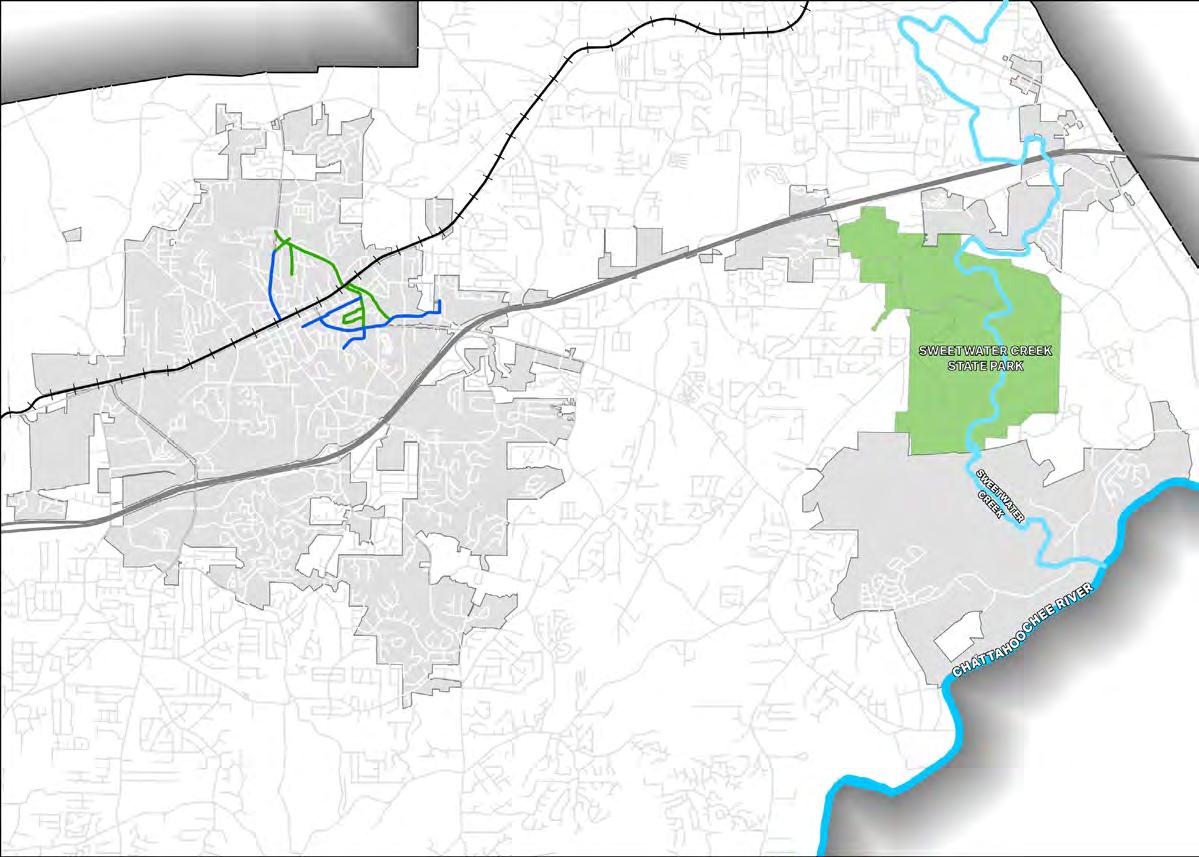

I-20 AT BRIGHT STAR ROAD TRANSPORTATION STUDY
CITY OF DOUGLASVILLE, 2015
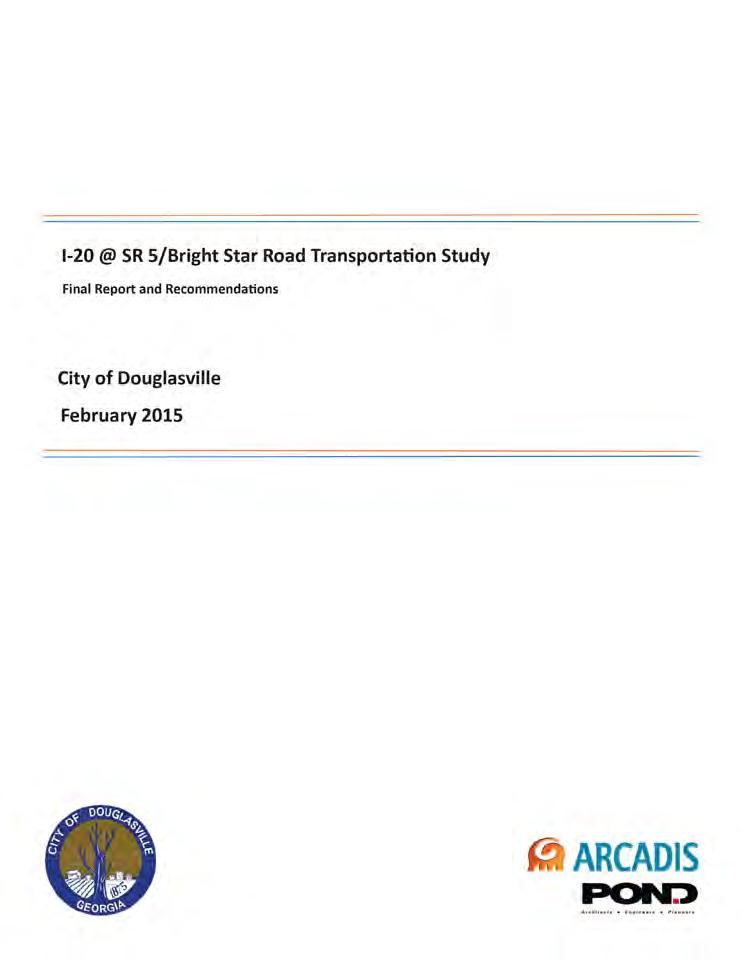
This plan explores the southwest area of Douglasville surrounding Bright Star Road as it crosses over I-20. Although specifically scoped to assess traffic conditions and provide recommendations to increase capacity and circulation for motor vehicles, the plan does recommend a robust system throughout this area. The highlight among these pedestrian and bicycle recommendations is the system proposed for the neighborhoods just south of the Arbor Place Mall. This system was the springboard for the Arbor Place loop mentioned in the Introduction of this report. It provides good circulation for active transportation for this vital commercial and residential area. Furthermore, this study touches upon many other corridors that would greatly benefit from active transportation, such as Campbellton Street and Prestley Mill Road.

STUDY AREA
INTERSTATE
SIDEWALKS
SHARED-USE PATH
NON-SPECIFIC CONNECTION
BIKE LANES

STUDY AREA
STATE

INTERSTATE
BIKE ROUTES/SHARROWS
SHARED-USE PATHS
NON-SPECIFIC CONNECTION



DOUGLAS BLVD
DOUGLAS
LIVABLE CENTERS INITIATIVE 5-YEAR UPDATE
CITY OF DOUGLASVILLE, 2016

The Livable Centers Initiative study was revisited once more in 2016 to assess the progress-to-date since the ten-year update. Many of the projects from the previous studies were built or were deemed no longer relevant and removed for this study. It still recommends a robust system of sidewalks and bike paths for the downtown area.

STUDY AREA
SIDEWALKS
SHARED-USE PATH
NON-SPECIFIC CONNECTION
BIKE LANES

STUDY AREA
STATE

INTERSTATE
BIKE ROUTES/SHARROWS
SHARED-USE PATHS
NON-SPECIFIC CONNECTION



DOWNTOWN MASTER PLAN & 10-YEAR STRATEGIC PLAN CITY OF DOUGLASVILLE, 2017

DOUGLASVILLE

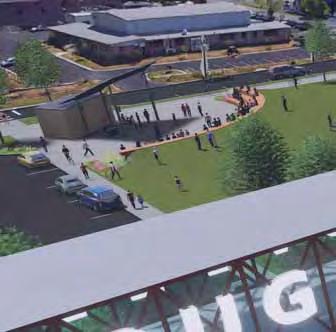






This plan to revitalize downtown Douglasville lays out an ambitious vision for the future. Centered around a flagship redevelopment of the former jail into a beautiful Town Green as seen above, this plan is the roadmap as Douglasville moves forward. A downtown network for bikes called the “Bike Loop” is recommended, which consists of a series of cycle tracks and multi-use paths that will allow bikes to move safely throughout downtown.

STUDY AREA
STATE
INTERSTATE
SIDEWALKS
SHARED-USE PATH
NON-SPECIFIC CONNECTION
BIKE LANES
BIKE ROUTES/SHARROWS

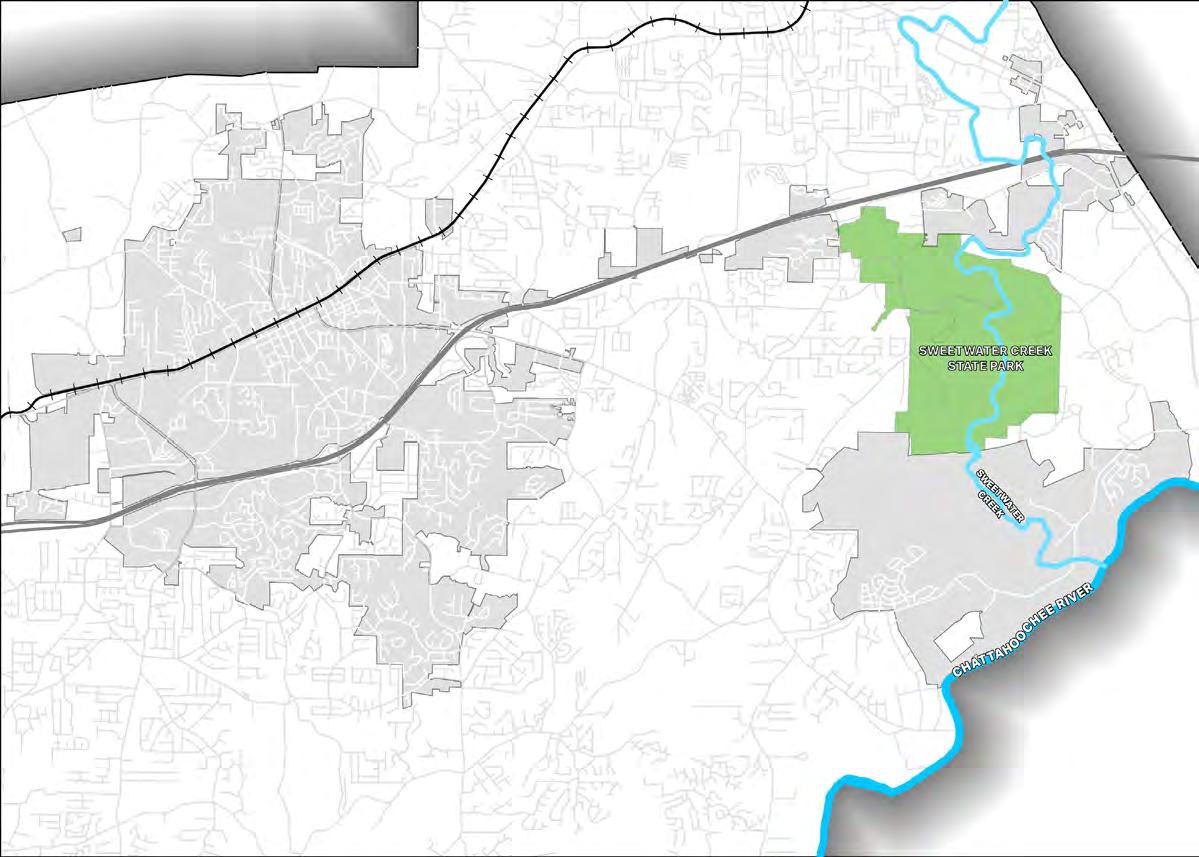
STATE
SHARED-USE PATHS
NON-SPECIFIC CONNECTION



SWEETWATER CREEK MASTER PLAN - CONCEPT A DOUGLAS COUNTY, 2017
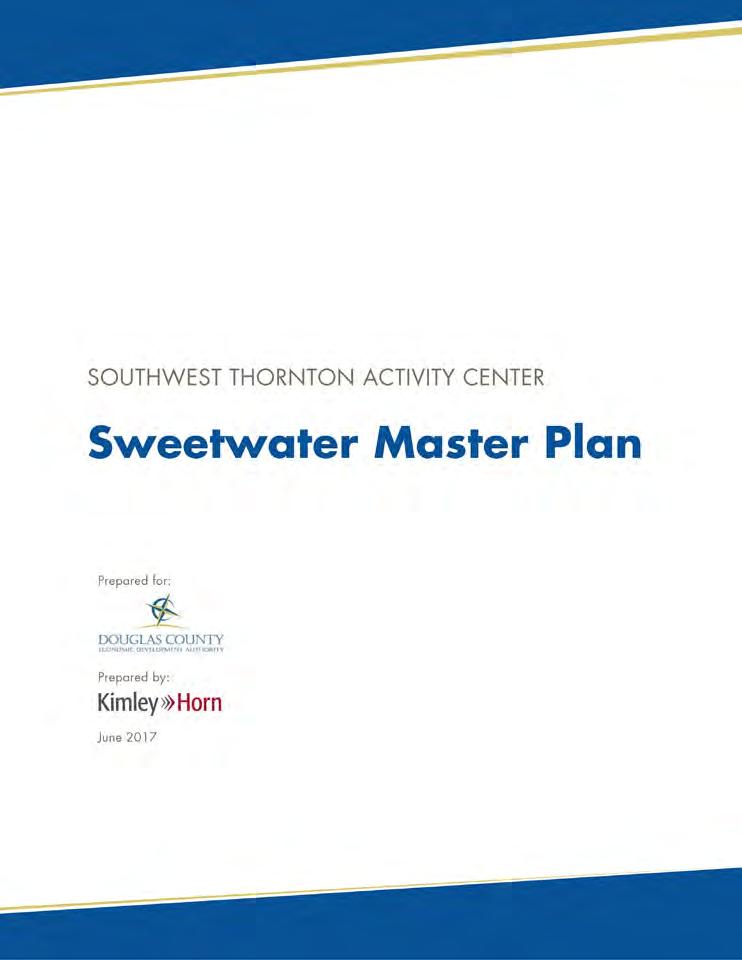
This plan, commissioned by Douglas County, seeks to guide development in the area surrounding Sweetwater Creek State Park. It is largely a land use plan that prescribes policy to guide development and proposes roadway alterations to improve access for the trucking industry. Part of this plan details a greenway system just east of Sweetwater Creek State Park. This would provide connectivity for active transportation users from Blairs Bridge Road to Riverside Parkway and would connect into the park. Two concepts are presented - Concept A is mapped at right.

STUDY AREA
STATE
INTERSTATE
SIDEWALKS
SHARED-USE PATH
NON-SPECIFIC CONNECTION
BIKE LANES

STUDY AREA
STATE

INTERSTATE
BIKE ROUTES/SHARROWS
SHARED-USE PATHS
NON-SPECIFIC CONNECTION



SWEETWATER MASTER PLAN - CONCEPT B DOUGLAS COUNTY, 2017

This plan, commissioned by Douglas County, seeks to guide development in the area surrounding Sweetwater Creek Park. It is largely a land use plan that prescribes policy to guide development and proposes roadway alterations to improve access for the trucking industry. Part of this plan details a greenway system just east of Sweetwater Creek State Park. This would provide connectivity for active transportation users from Blairs Bridge Road to Riverside Parkway and would connect into the park. Two concepts are presented - Concept B is mapped at right.

STUDY AREA
STATE
INTERSTATE
SIDEWALKS
SHARED-USE PATH
NON-SPECIFIC CONNECTION
BIKE LANES

INTERSTATE
STATE

BIKE ROUTES/SHARROWS
SHARED-USE PATHS
NON-SPECIFIC CONNECTION



COMPREHENSIVE PARKS & RECREATION MASTER PLAN
CITY OF DOUGLASVILLE, 2018


This plan assesses the sate of Douglasville’s parks. It lists all the amenities at each of the parks, recommendations for future installations, pinpoints funding sources, and outlines a vision for connectivity amongst the parks. Although not specific in its recommendations, the active transportation connectivity that is outlined herein would be a robust system that people could use to get wherever they wish to go, not just to and from the parks.

STUDY AREA
STATE
INTERSTATE
SIDEWALKS
SHARED-USE PATH
NON-SPECIFIC CONNECTION
BIKE LANES
BIKE ROUTES/SHARROWS
SHARED-USE PATHS
NON-SPECIFIC CONNECTION

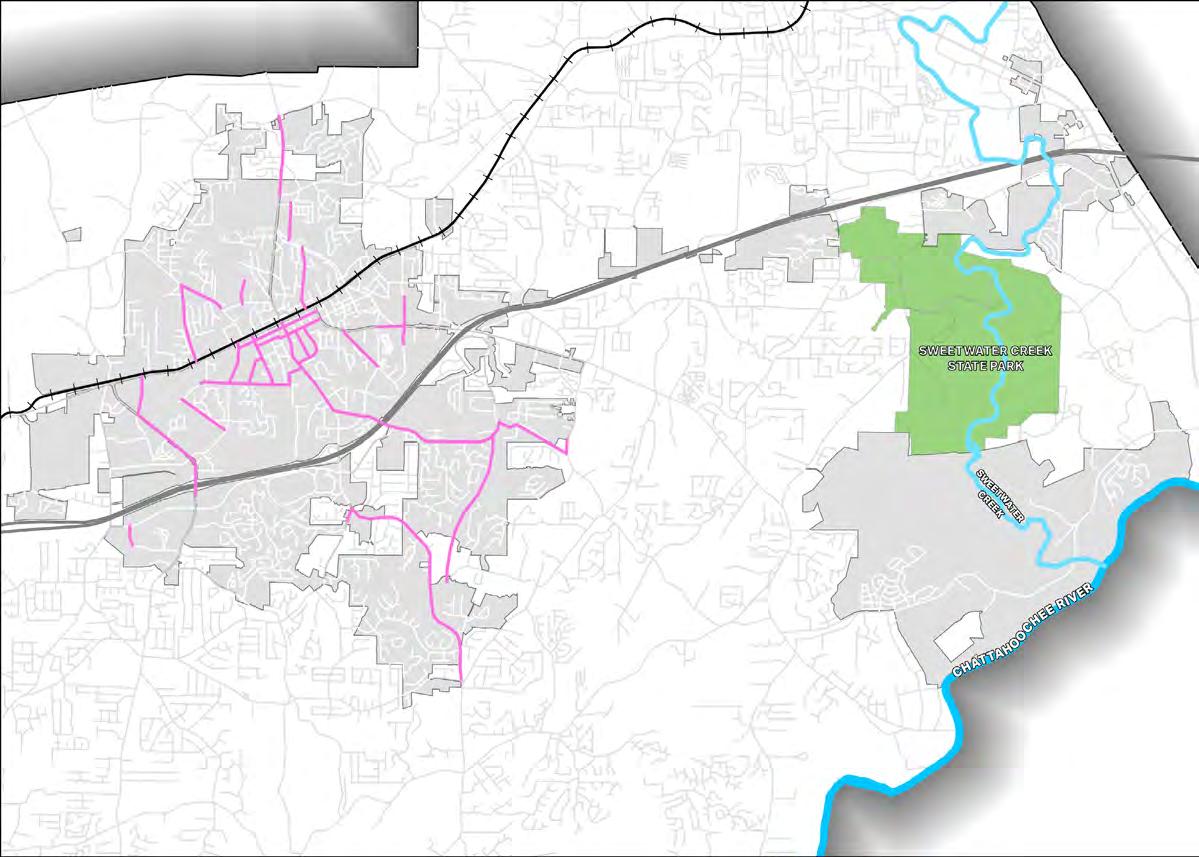



NORTHSIDE REDEVELOPMENT PLAN
CITY OF DOUGLASVILLE, 2018
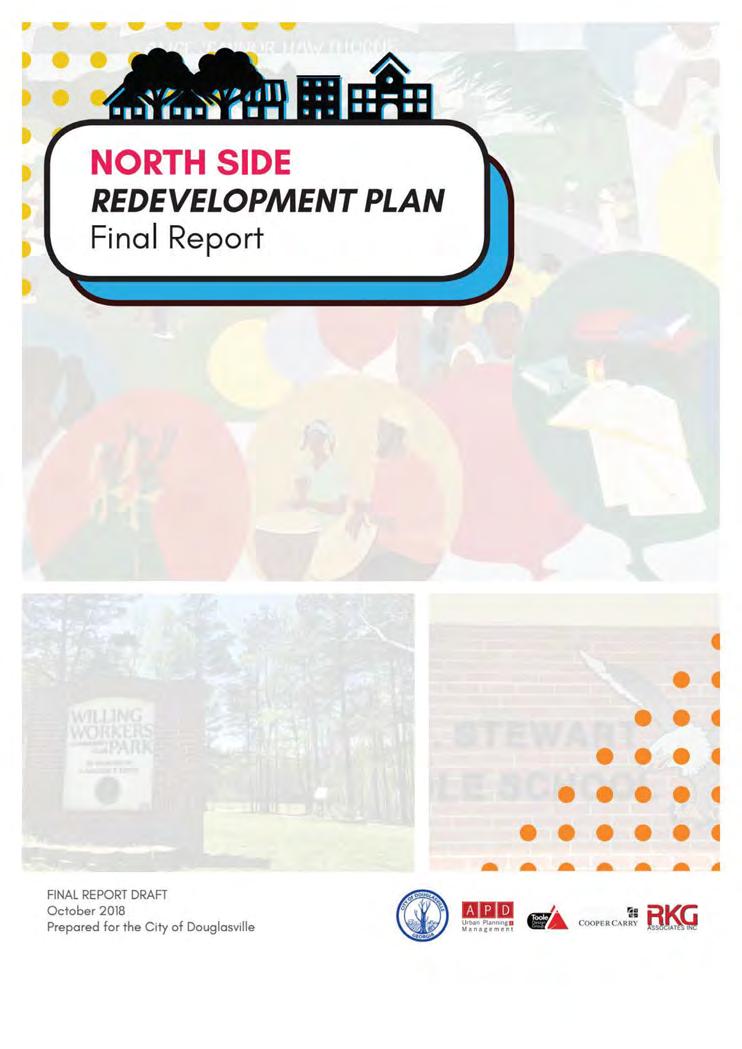
This plan focuses on the area of Douglasville north of the Norfolk-Southern railroad tracks through downtown. It lists catalyst projects that are intended to revitalize the north downtown area and spur development at these nodes. In terms of pedestrian and bicycle infrastructure, it recommends a network of connections throughout the area, largely consisting of trails and multi-use paths. The flagship infrastructure recommendation is a shared-use path along Dallas Highway that would serve as the backbone for the entire area. The next plan, the Dallas Highway LCI, deals entirely with this project.
SIDEWALKS
SHARED-USE PATH
NON-SPECIFIC CONNECTION

BIKE LANES
BIKE ROUTES/SHARROWS
SHARED-USE PATHS NON-SPECIFIC CONNECTION

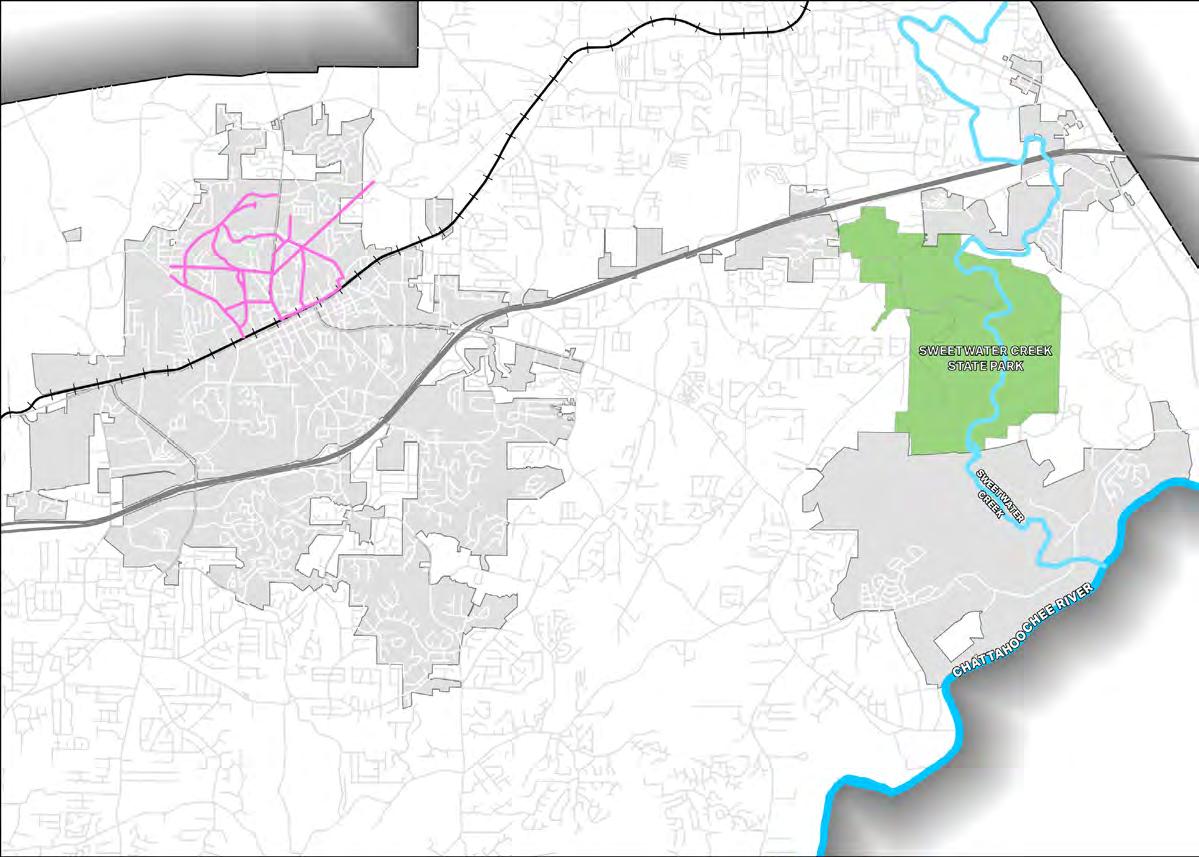



DALLAS HIGHWAY LIVABLE CENTERS INITIATIVE CITY OF DOUGLASVILLE, 2019

This plan provides a vision for a complete Dallas Highway that would serve as the backbone for transportation and redevelopment on the north side of town. In addition to the shared-use path along the length of Dallas Highway on into the New 92 shared-use path, this plan also recommends a couple of roundabouts at key intersections and a multimodal hub where Dallas Highway meets the Norfolk Southern railroad.

STUDY AREA
STATE
INTERSTATE
SIDEWALKS
SHARED-USE PATH
NON-SPECIFIC CONNECTION
BIKE LANES
BIKE ROUTES/SHARROWS
SHARED-USE PATHS
NON-SPECIFIC CONNECTION



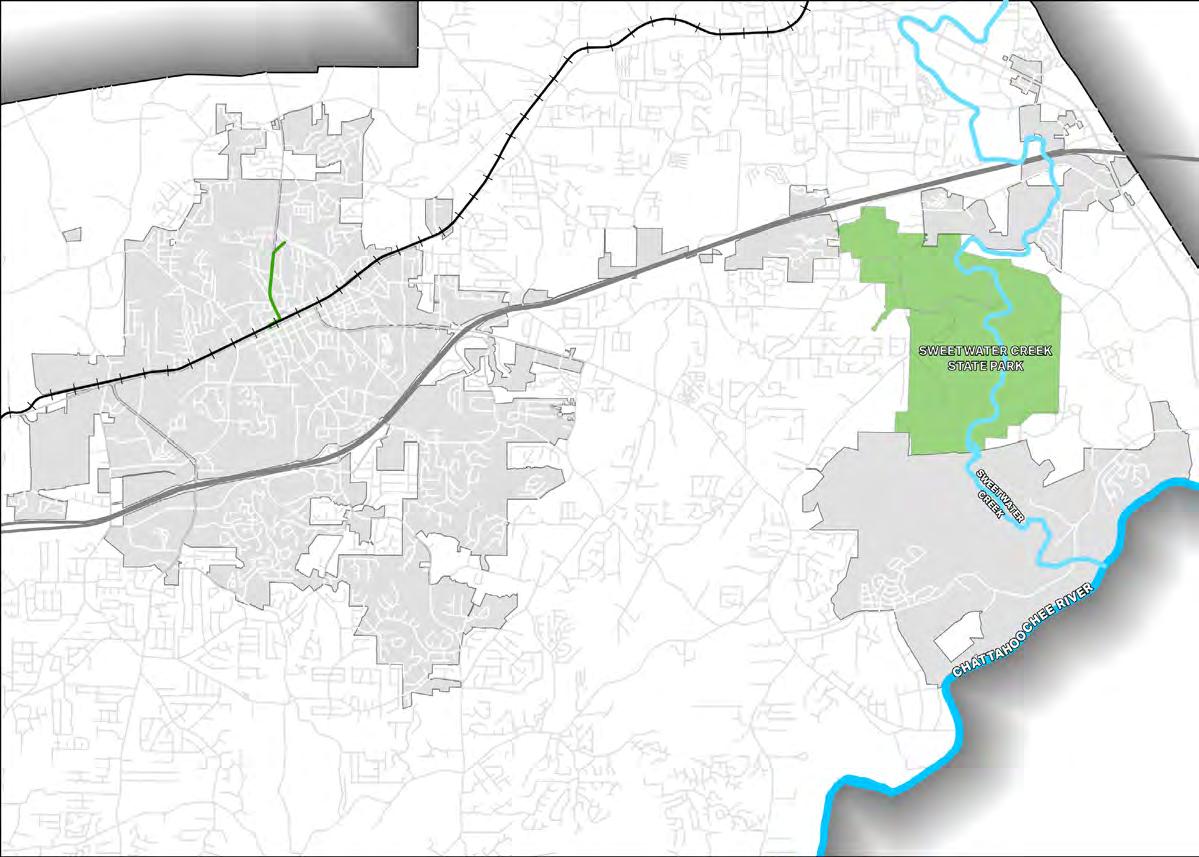

CHATTAHOOCHEE HILL COUNTRY REGIONAL GREENWAY TRAIL DOUGLAS COUNTY, ONGOING


The Chattahoochee Hill Country Trail is a planned 100-mile trail that would follow the Chattahoochee River, going through many Georgia counties along its way. Douglas County has commissioned AECOM to conduct preliminary engineering for a segment of this trail that leads from Boundary Waters Park (south of the current extent of the map at right) all the way up and along the east side of Sweetwater Creek State park, terminating at the northeastern end of the park. This segment has been split into three phases. As of this report’s writing, the alignment for all three phases has been chosen and preliminary design work for the first phase (the southernmost leg from Boundary Waters Park to State Route 92) is underway.

STUDY AREA
INTERSTATE
SIDEWALKS
SHARED-USE PATH
NON-SPECIFIC CONNECTION
BIKE LANES

STUDY AREA
STATE

INTERSTATE
BIKE ROUTES/SHARROWS
SHARED-USE PATHS
NON-SPECIFIC CONNECTION



PREVIOUS PLAN BLENDED NETWORKS

2.2 PREVIOUS PLAN BLENDED NETWORKS
After analyzing each of these plans for pedestrian and bicycle connectivity separately, the recommendations from all of the plans were layered to create the maps on the following pages. These maps represent the City of Douglasville’s vision of becoming a city that embraces pedestrians and bicyclists into its fully connected active transportation system.


FIGURE 28: Blended network maps.


BLEND OF PREVIOUSLY PROPOSED PED NETWORKS
CITY OF DOUGLASVILLE
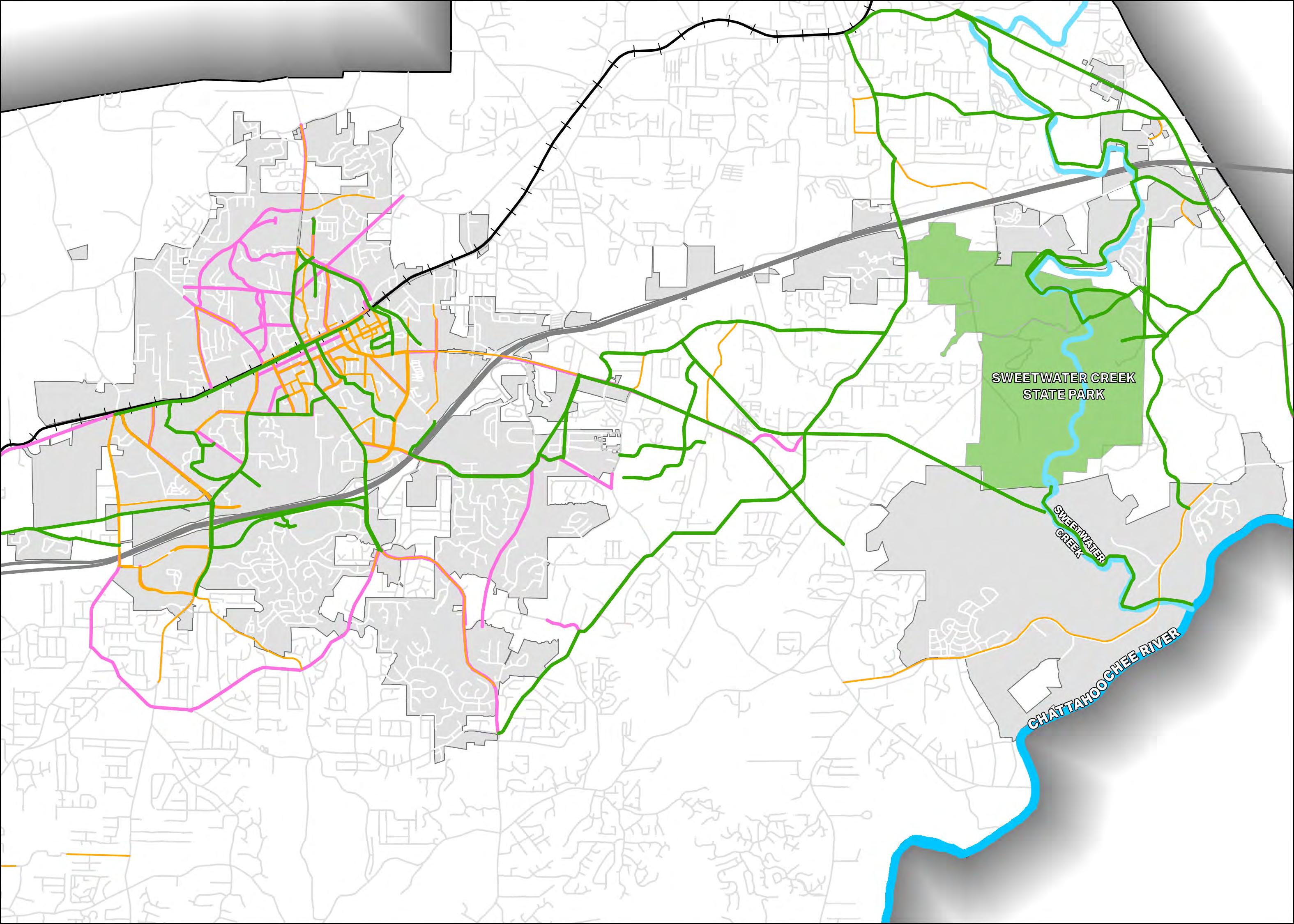




CAMPBELLTONST DALLAS



LEGEND

CITY LIMITS
STATE
INTERSTATE
COUNTY ROADS
CITY ROADS
SIDEWALKS
SHARED-USE PATH
NONSPECIFIC CONNECTION
FAIRBURNRD
DOUGLAS
CHAPEL HILLRD BILLARPRD


BRIDGERD BLAIRS
THORNTONRD




FULTON COUNTY
RIVERSIDE PKWY



LEGEND
BLEND OF PREVIOUSLY PROPOSED BIKE NETWORKS
CITY OF DOUGLASVILLE

CHICAGOAVE


CITY LIMITS
STATE PARK
NS RAILROAD
INTERSTATE
COUNTY ROADS
CITY ROADS


CAMPBELLTONST DALLAS HWY



EXISTING BIKE LANES
BIKE LANES
BIKE ROUTES/SHARROWS
SHARED-USE PATHS
NON-SPECIFIC CONNECTION
FAIRBURNRD
DOUGLAS BLVD
CHAPEL HILLRD BILLARPRD


BRIDGERD BLAIRS
THORNTONRD




FULTON COUNTY
RIVERSIDE PKWY


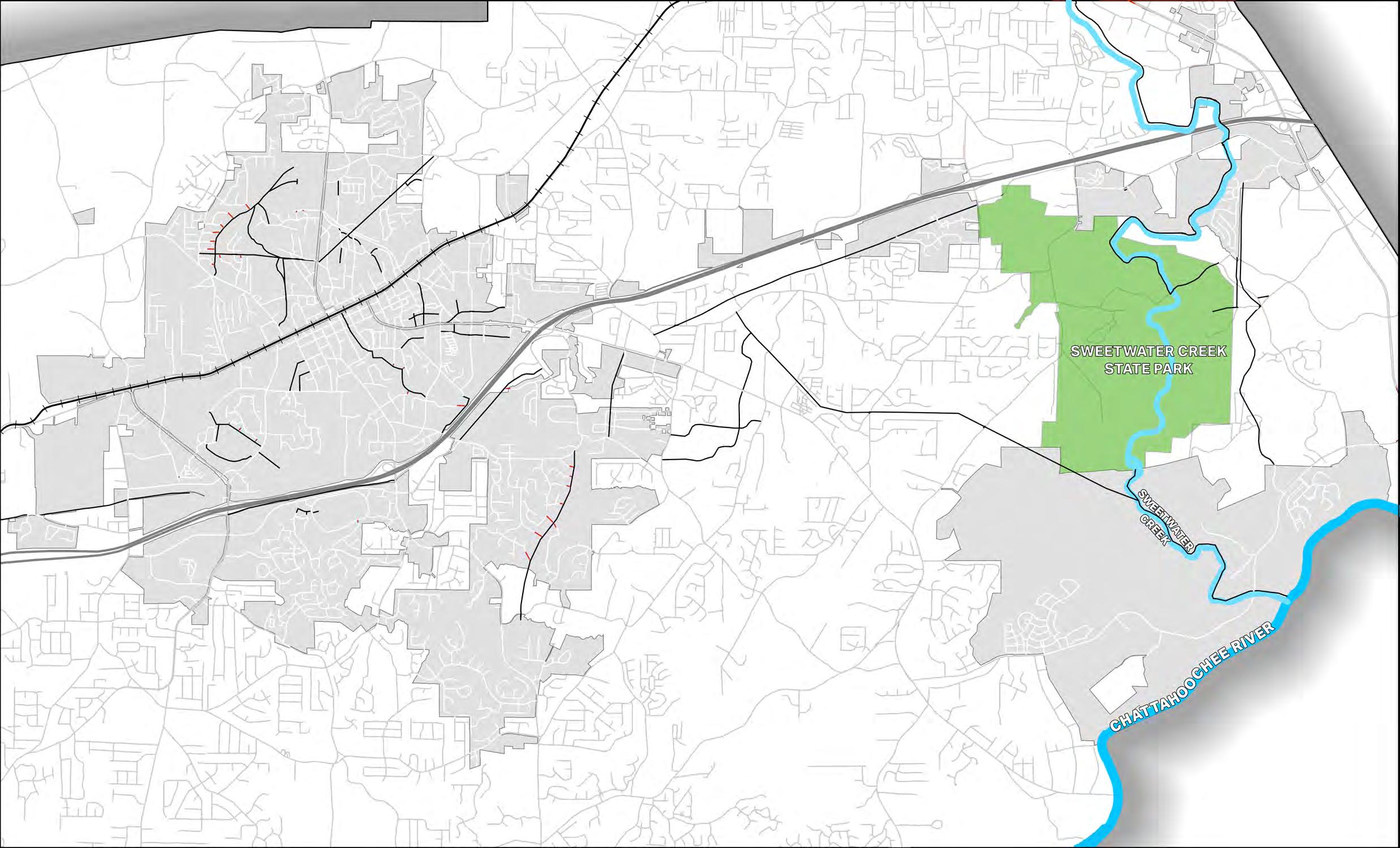
CITY OF DOUGLASVILLE

DALLAS HWY
CHICAGOAVE ROSE AVE

CAMPBELLTONST
DOUGLAS BLVD






FAIRBURNRD
CHAPEL HILLRD BILLARPRD


BRIDGERD BLAIRS
THORNTONRD




FULTON COUNTY
RIVERSIDE PKWY


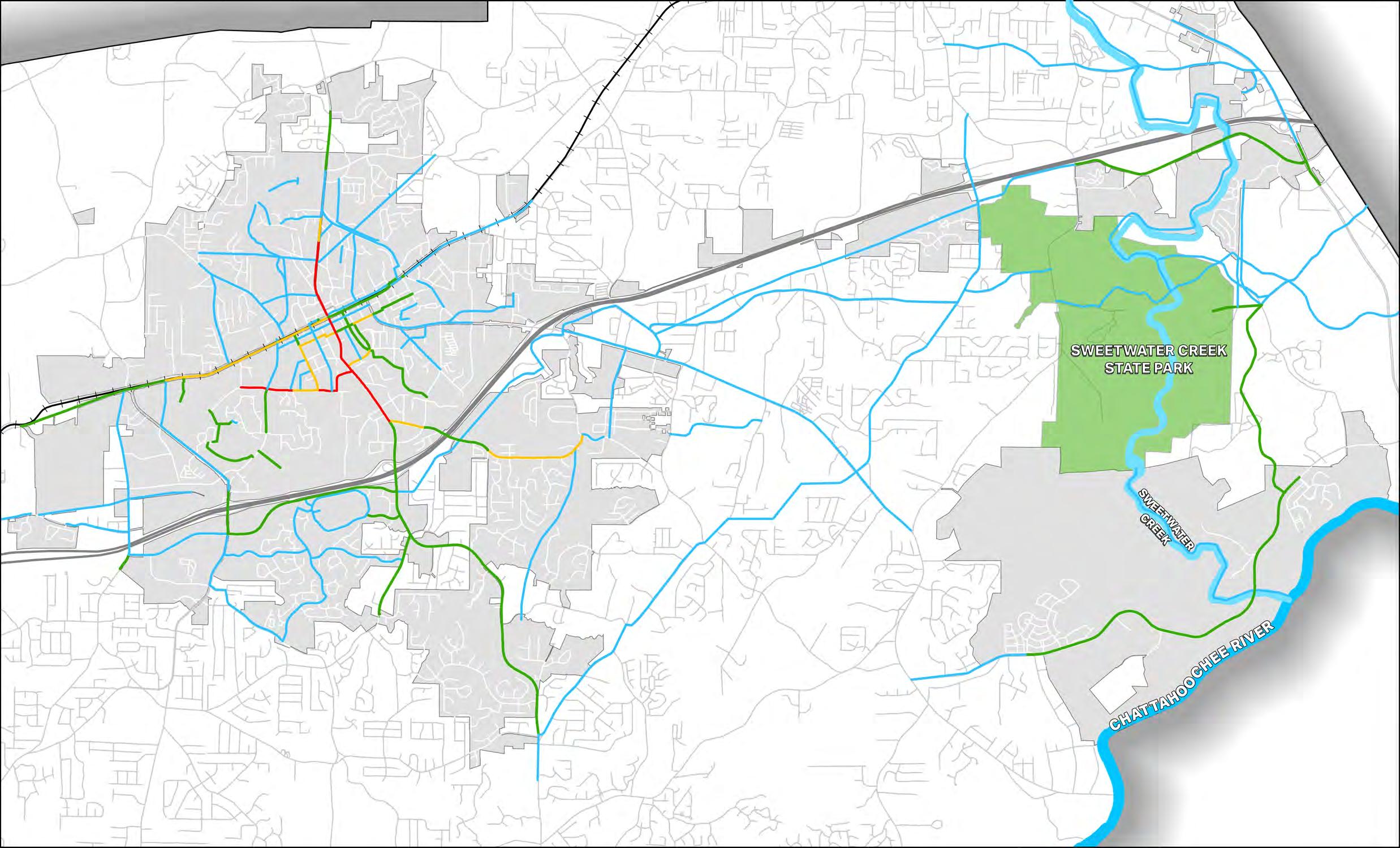
LEGEND
FREQUENCY OF PREVIOUSLY PROPOSED CORRIDORS
CITY OF DOUGLASVILLE

DALLAS HWY
CHICAGOAVE

BILLARPRD
ROSE AVE NEW92



CITY LIMITS
STATE PARK
NS RAILROAD
INTERSTATE
COUNTY ROADS
CITY ROADS



FAIRBURNRD CAMPBELLTONST
DOUGLAS BLVD
RECOMMENDED IN 7-8 PLANS
RECOMMENDED IN 5-6 PLANS
RECOMMENDED IN 3-4 PLANS
RECOMMENED IN 1-2 PLANS
CHAPEL HILLRD


BRIDGERD BLAIRS
THORNTONRD




FULTON COUNTY
RIVERSIDE PKWY
CONNECTIVITY HEATMAPS
2.3 CONNECTIVITY HEATMAPS
Once our team had a complete understanding of both existing conditions and previous plans, we began to analyze the networks to determine where connectivity is most needed. Traditionally, transportation planners would draw a radius on a map or aerial representing a certain distance one could walk from point A to point B (one-half mile for this discussion). This, of course, would not take into account any physical barriers that might be encountered that could dramatically increase a halfmile walk.


We took a more novel approach. Enter the travelshed. This method of creating a “half-mile walking radius” involves mapping out the area that you could get to by walking a half-mile along the network at hand. The edge of the red-shaded area above represents the distance you could reach by walking a half-mile along the street network. The red-shaded area itself represents all of the routes you could take to get to the edge. Travelsheds provide us a better sense of the permeability of the network than a traditional radius.
FIGURE 29: Travelshed explanation.
HEATMAPPING METHODOLOGY
Then we take it a step further. Let’s say that we live right near Mill Village Park (the square outlined in red at the right side of the map). I want to take my child to school and then later get over to the museum. Which roads are important for this three step trip?

We can build travelsheds for each of these destinations and overlap them, which will give us a “heatmap” of connectivity. Starting with 1 at right, we build a travelshed from the first destionation. Then we build a travelshed from the museum (image 2) and another originating from the school. Once we overlap these three travelsheds, we can clearly see that the streets in the darkest red area in the middle are connected between all three of these places. This may be obvious when dealing with only three locations, but when you are dealing with hundreds of destinations and thousands of residential parcels, it is a powerful tool for identifying the streets that link critical aspects of the network.



FIGURE 30: Overlapping travelshed heatmapping methodology.
STEWART MIDDLE SCHOOL
MILL VILLAGE PARK
DOUGLASVILLE MUSEUM
Finally, we count the number of travelsheds that overlaps each segment, resulting in a map similar to the one below. This map is a simple representation - we aggregate thousands of these travelsheds from a variety of different locations and at different scales to gain an understanding of Douglasville’s connectivity.

We ran this analysis methodology in a variety of different ways, as outlined in the table at right. There are three networks that we studied:
• Existing Street Network along street centerlines
• Existing Pedestrian Network along pedestrian infrastructure centerlines
• Existing Bicycle Network along bicycle infrastructure centerlines
For each of these networks, we created travelsheds from three different origins:
• General - Intersections of streets
• Residential - Parcels of Residences
• Destinational - Parcels of Destinations
The travelsheds were three different distances:
• Quarter-mile (typical walking trip)
• Half-mile (typical walking or biking trip)
• One-mile (typical biking trip)
Walking travelsheds were studied at only the quarter-mile and half-mile distances; biking travelsheds were studied at only the half-mile and one-mile distances; and the street network was studied for all three distances for comparison.
TRAVELSHED ORIGIN
GENERAL DESTINATIONAL RESIDENTIAL
HALF-MILE
QUARTER-MILE HALF-MILE QUARTER-MILE HALF-MILE QUARTER-MILE
HALF-MILE
FIGURE 31: Connectivity heatmap methodology.
FIGURE 32: Different types of heatmaps.
GENERAL SIDEWALK CONNECTIVITY - QUARTER MILE
QUARTER-MILE travelsheds were created originating from intersections along the street network (top map) and along the SIDEWALK network (bottom map). For each segment of every road, the number of overlapping travelsheds was counted. This results in the GENERAL connectivity heat maps at right. Redder lines indicate that more travelsheds pass over that segment of street. Bluer lines indicate that relatively few travelsheds passed over that segment of street. The map below is the difference between the two maps at right. This highlights areas that are highly connected for streets but lacking connectivity for pedestrians.
POTENTIAL TARGETS
At the scale of quarter mile-travelsheds, the most intrinsically well-connected place in Douglasville is the Tributary development with its densely packed streets. Besides that, there are many short segments of road near downtown that are lacking in connectivity. In the map below, Rose Avenue along the cemetery and Chicago Avenue near the intersection with Cedar Mountain Road stand out. These are two critical pieces of missing sidewalk.
LEGEND

TRAVELSHED ORIGIN
CONNECTIVITY


ROSEAVE

LEGEND
CONNECTIVITY

LEGEND
CONNECTIVITY


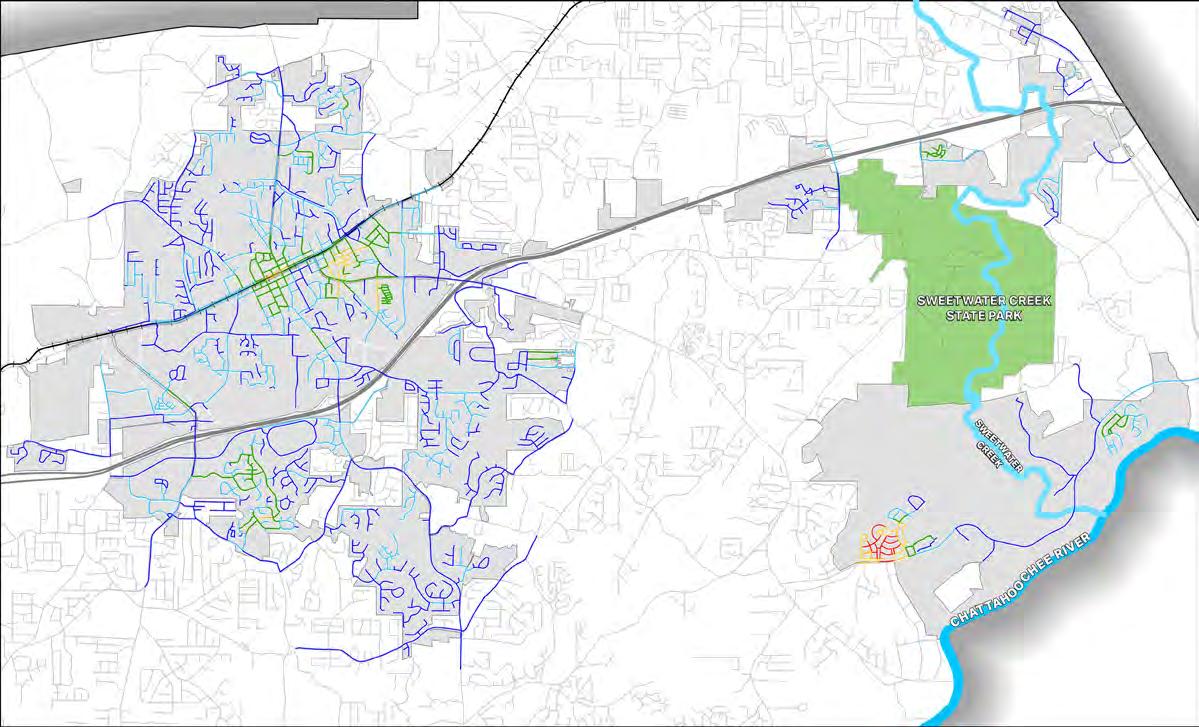

GENERAL SIDEWALK CONNECTIVITY - HALF MILE
HALF-MILE travelsheds were created originating from intersections along the street network (top map) and along the SIDEWALK network (bottom map). For each segment of every road, the number of overlapping travelsheds was counted. This results in the GENERAL connectivity heat maps at right. Redder lines indicate that more travelsheds pass over that segment of street. Bluer lines indicate that relatively few travelsheds passed over that segment of street. The map below is the difference between the two maps at right. This highlights areas that are highly connected for streets but lacking connectivity for pedestrians.
POTENTIAL TARGETS
Streets that are missing sidewalks in the downtown area become much more prominent when the travelshed length increases to a half mile. Adair Street and Spring Street are the most prominent. Additionally, Ellis Street stands out as needing sidewalks, as does Creekwood Drive in the Arbor Place neighborhoods area. Finally, Old Lower River Road is important for children walking to school from Tributary.
LEGEND
TRAVELSHED ORIGIN




LEGEND
CONNECTIVITY

LEGEND
CONNECTIVITY


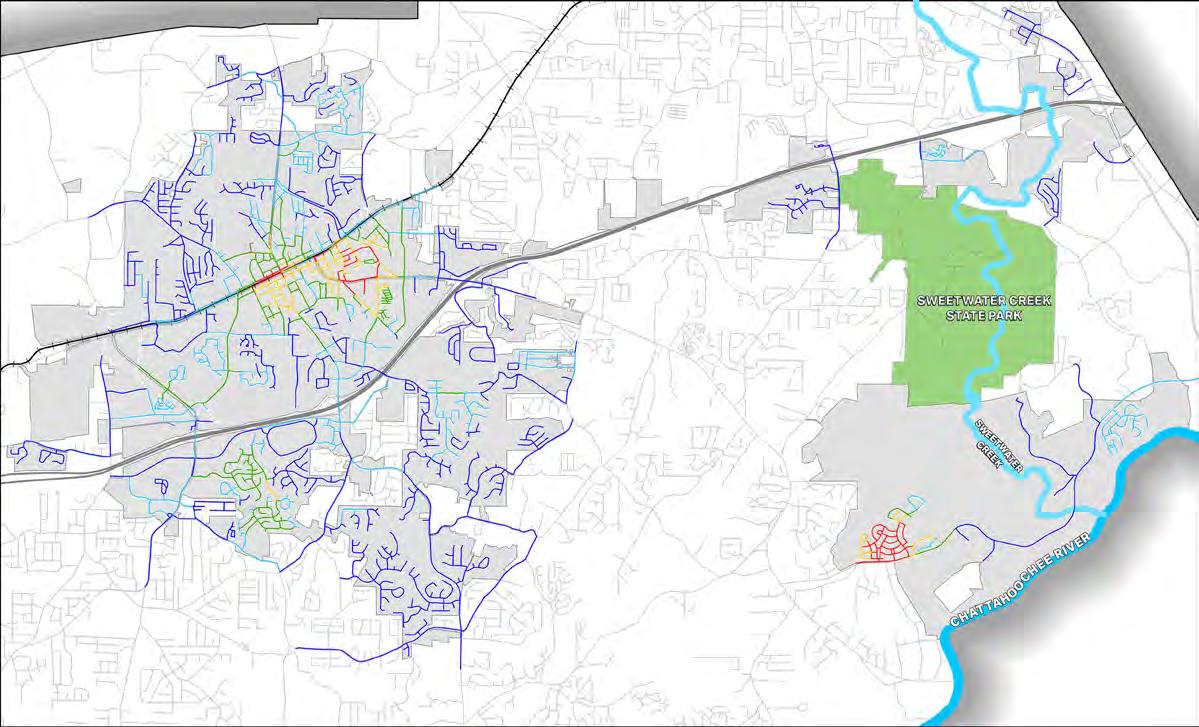

RESIDENTIAL SIDEWALK CONNECTIVITY - QUARTER MILE
QUARTER-MILE travelsheds were created originating from residential parcels along the street network (top map) and along the SIDEWALK network (bottom map). For each segment of every road, the number of overlapping travelsheds was counted. This results in the RESIDENTIAL connectivity heat maps at right. Redder lines indicate that more travelsheds pass over that segment of street. Bluer lines indicate that relatively few travelsheds passed over that segment of street. The map below is the difference between the two maps at right. This highlights areas that are highly connected for streets but lacking connectivity for pedestrians.
POTENTIAL TARGETS
Potential connectivity moves outward from the downtown area when travelsheds originate from residential parcels. In the map below we can see that the southernmost part of Chapel Hill Road is “hot”. Sidewalks are greatly needed in this area to serve the large number of people living in the neighborhoods along Chapel Crossing Road. Chicago Avenue is highlighted once more, signalling the need to complete the sidewalk there. Meanwhile, Riverside Parkway at the western terminus of the City is also bright red, indicating need there.
LEGEND

TRAVELSHED ORIGIN
CONNECTIVITY



LEGEND
CONNECTIVITY

LEGEND
CONNECTIVITY




HALF-MILE travelsheds were created originating from residential parcels along the street network (top map) and along the SIDEWALK network (bottom map). For each segment of every road, the number of overlapping travelsheds was counted. This results in the RESIDENTIAL connectivity heat maps at right. Redder lines indicate that more travelsheds pass over that segment of street. Bluer lines indicate that relatively few travelsheds passed over that segment of street.The map below is the difference between the two maps at right. This highlights areas that are highly connected for streets but lacking connectivity for pedestrians.
POTENTIAL TARGETS
At the half-mile level, all three of the maps of travelsheds from residences are hot in the downtown area. The differential map below being red in the same area indicates that there is a lack of connectivity along many of the streets that lead into the downtown area, which results in fewer pedestrian travelsheds that reach downtown. This strengthens the case for the connections surrounding downtown that were identified in the previous set of maps.
LEGEND
TRAVELSHED ORIGIN




LEGEND
CONNECTIVITY

LEGEND
CONNECTIVITY




DESTINATION SIDEWALK CONNECTIVITY - QUARTER MILE
QUARTER-MILE travelsheds were created originating from destinations of interest along the street network (top map) and along the SIDEWALK network (bottom map). For each segment of every road, the number of overlapping travelsheds was counted. This results in the DESTINATIONAL connectivity heat maps at right. Redder lines indicate that more travelsheds pass over that segment of street. Bluer lines indicate that relatively few travelsheds passed over that segment of street. The map below is the difference between the two maps at right. This highlights areas that are highly connected for streets but lacking connectivity for pedestrians.
POTENTIAL TARGETS
As you can see in the destinational street connectivity map at right, the downtown area, the Arbor Place Mall area, and the Hospital Drive area are full of destinations of interest. Hospital Drive is well connected with sidewalks, but some areas in the downtown core and along Douglas Boulevard in the Arbor Place Mall area are lacking connectivity. These will be important roads for sidewalks to connect people to places.
TRAVELSHED ORIGIN

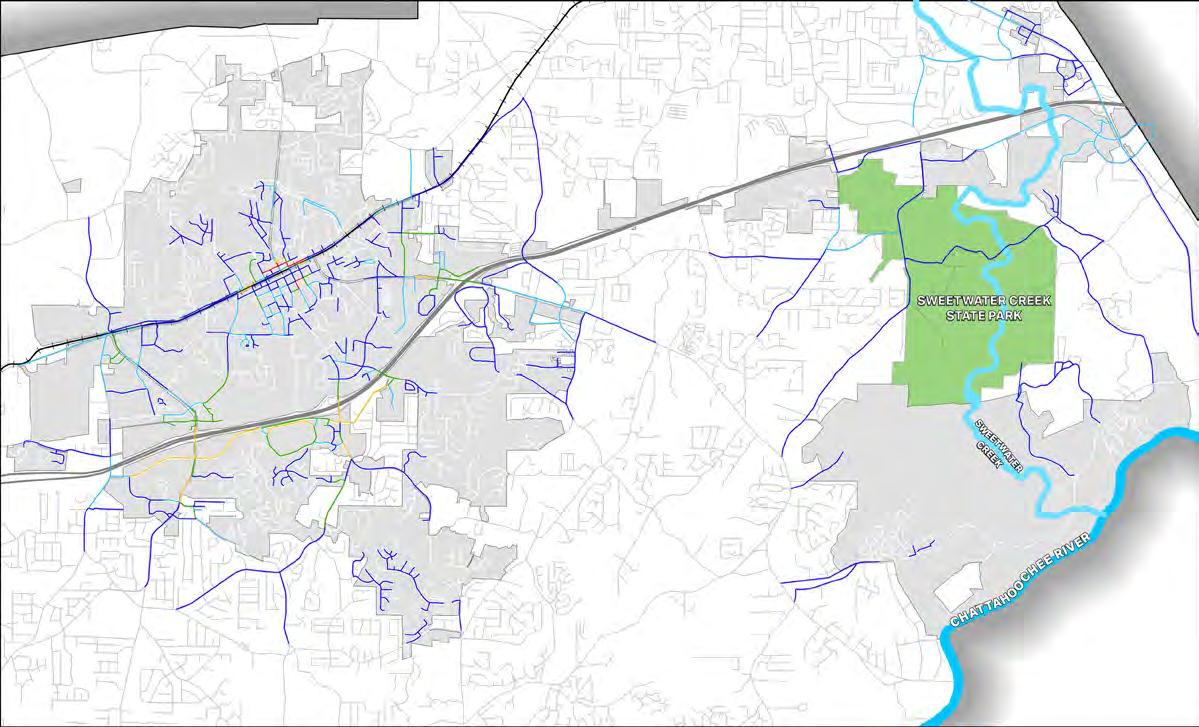


LEGEND
CONNECTIVITY
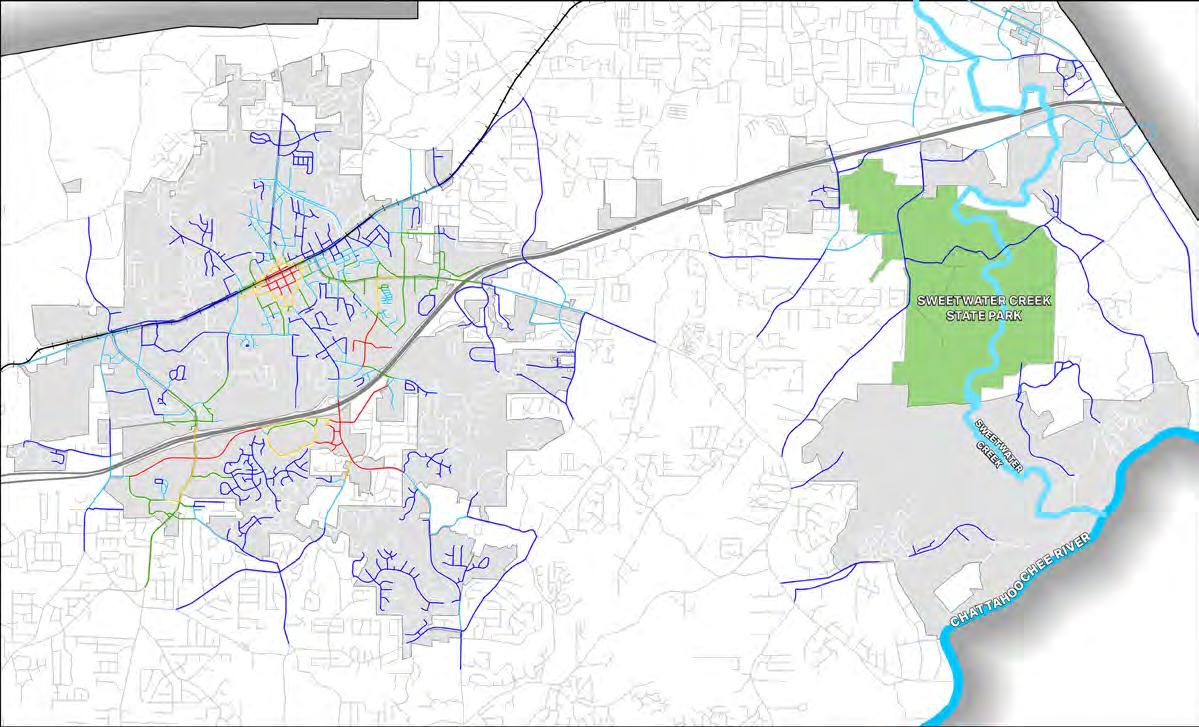
LEGEND
CONNECTIVITY


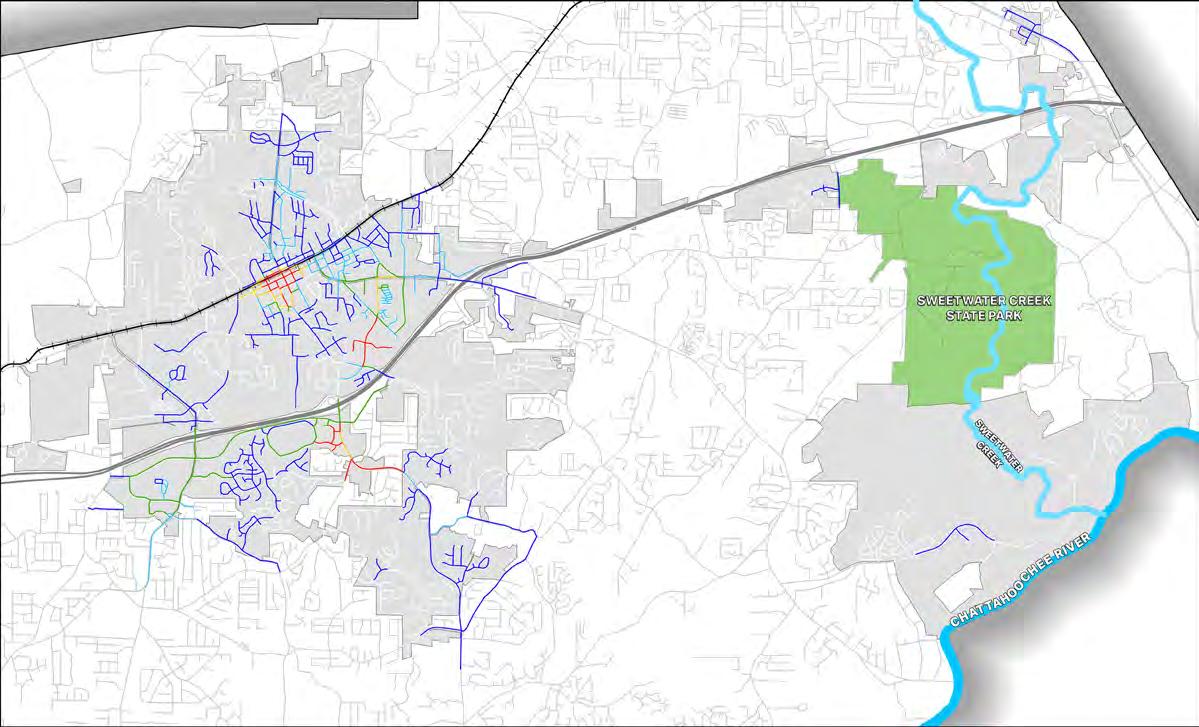

DESTINATION SIDEWALK CONNECTIVITY - HALF MILE
HALF-MILE travelsheds were created originating from destinations of interest along the street network (top map) and along the SIDEWALK network (bottom map). For each segment of every road, the number of overlapping travelsheds was counted. This results in the DESTINATIONAL connectivity heat maps at right. Redder lines indicate that more travelsheds pass over that segment of street. Bluer lines indicate that relatively few travelsheds passed over that segment of street.The map below is the difference between the two maps at right. This highlights areas that are highly connected for streets but lacking connectivity for pedestrians.
POTENTIAL TARGETS
When the length of the travelshed increases to a halfmile, the street connectivity map becomes more red, but the sidewalk connectivity map remains largely unchanged. The result is that other ares where the sidewalks are lacking in connectivity is highlighted in the differential map. Below, the area north of the Norfolk Southern railroad heats up. There is little sidewalk connectivity across the tracks. Other important roads requiring connectivity are Stewart Mill Road and the west part of Douglas Boulevard near the park and ride.
LEGEND
TRAVELSHED ORIGIN




LEGEND
CONNECTIVITY

LEGEND
CONNECTIVITY




GENERAL BICYCLE CONNECTIVITY - HALF MILE
HALF-MILE travelsheds were created originating from intersections along the street network (top map) and along the BICYCLE network (bottom map). For each segment of every road, the number of overlapping travelsheds was counted. This results in the GENERAL connectivity heat maps at right. Redder lines indicate that more travelsheds pass over that segment of street. Bluer lines indicate that relatively few travelsheds passed over that segment of street. The map below is the difference between the two maps at right. This highlights areas that are highly connected for streets but lacking connectivity for pedestrians.
POTENTIAL TARGETS
For bicycle connectivity, the area surrounding downtown is lacking in connectivity. This is why the downtown is hot for bicycles, but not quite as hot as it is for cars. Furthermore, one segment along Fairburn Road right around the Dorris Road and Hospital Drive intersections is severely lacking in connectivity. The center of the Arbor Place neighborhoods along Parkway South is also lacking in connectivity. This is the center of the Arbor Place neighborhoods, and as such will be critical for any connectivity.
LEGEND

TRAVELSHED ORIGIN
CONNECTIVITY



LEGEND
CONNECTIVITY

LEGEND
CONNECTIVITY


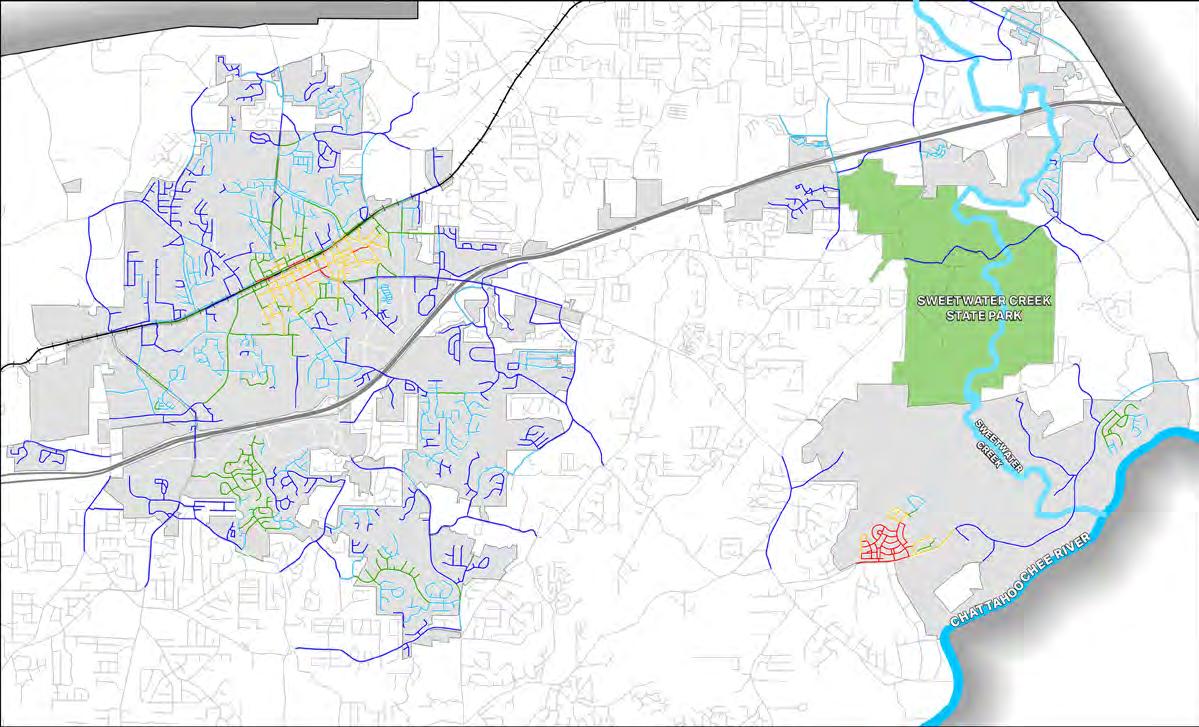

GENERAL
BICYCLE CONNECTIVITY - ONE MILE
ONE-MILE travelsheds were created originating from intersections along the street network (top map) and along the BICYCLE network (bottom map). For each segment of every road, the number of overlapping travelsheds was counted. This results in the GENERAL connectivity heat maps at right. Redder lines indicate that more travelsheds pass over that segment of street. Bluer lines indicate that relatively few travelsheds passed over that segment of street. The map below is the difference between the two maps at right. This highlights areas that are highly connected for streets but lacking connectivity for bicyclists.
POTENTIAL TARGETS
At the one-mile travelshed level, the downtown area is very hot on both maps. Here it is best to look at the area surrounding the red-hot area. Looking at the bicycle connectivity map, the heat of the downtown area quickly cools off once you move out of downtown, indicating again that bike connectivity leading up to downtown is lacking. This is reflected further in the differential heatmap below, where the outer fringes of downtown are lit up. Dallas Highway, Hospital Drive, Duralee Lane, and Chicago Avenue are the targets from these maps.
LEGEND

TRAVELSHED ORIGIN
CONNECTIVITY



LEGEND
CONNECTIVITY

LEGEND
CONNECTIVITY




RESIDENTIAL BICYCLE CONNECTIVITY - HALF MILE
HALF-MILE travelsheds were created originating from residential parcels along the street network (top map) and along the BICYCLE network (bottom map). For each segment of every road, the number of overlapping travelsheds was counted. This results in the RESIDENTIAL connectivity heat maps at right. Redder lines indicate that more travelsheds pass over that segment of street. Bluer lines indicate that relatively few travelsheds passed over that segment of street. The map below is the difference between the two maps at right. This highlights areas that are highly connected for streets but lacking connectivity for bicyclists.
POTENTIAL TARGETS
In Douglasville, residences tend towards the outer edges of the city limits. This results in the potential additional connectivity map below being red mostly in places like Malone Road, Chicago Avenue, Rose Avenue, Chapel Hill Road at the southern end, and Riverside Parkway near the Tributary development. These are critical areas for bicycle connectivity to fluorish, as these represent the potential starting points for a vast number of potential cyclists.
LEGEND

TRAVELSHED ORIGIN
CONNECTIVITY



LEGEND
CONNECTIVITY

LEGEND
CONNECTIVITY




RESIDENTIAL BICYCLE CONNECTIVITY - ONE MILE
ONE-MILE travelsheds were created originating from residential parcels along the street network (top map) and along the BICYCLE network (bottom map). For each segment of every road, the number of overlapping travelsheds was counted. This results in the RESIDENTIAL connectivity heat maps at right. Redder lines indicate that more travelsheds pass over that segment of street. Bluer lines indicate that relatively few travelsheds passed over that segment of street. The map below is the difference between the two maps at right. This highlights areas that are highly connected for streets but lacking connectivity for bicyclists.
POTENTIAL TARGETS
At the one mile level, heat becomes further concentrated in the downtown area. Interestingly, in the differential map, the north and west side of the railroad tracks indicate the most lacking ares for bicycle connectivity. Facilities along Strickland Street, Dallas Highway, and Chicago Avenue will be important. We can also see that Cedar Mountain Drive is lit up, as is Rose Avenue and Club Drive.
LEGEND
TRAVELSHED ORIGIN




LEGEND
CONNECTIVITY

LEGEND
CONNECTIVITY




DESTINATIONAL BICYCLE CONNECTIVITY - HALF MILE
HALF-MILE travelsheds were created originating from destinations of interest along the street network (top map) and along the BICYCLE network (bottom map). For each segment of every road, the number of overlapping travelsheds was counted. This results in the DESTINATIONAL connectivity heat maps at right. Redder lines indicate that more travelsheds pass over that segment of street. Bluer lines indicate that relatively few travelsheds passed over that segment of street. The map below is the difference between the two maps at right. This highlights areas that are highly connected for streets but lacking connectivity for bicyclists.
POTENTIAL TARGETS
Destinations in Douglasville are concentrated in the downtown area and in the Arbor Place Mall area. The downtown area is somewhat connected because there are many comfortable local streets for cyclists to ride, but this is not so in the Arbor Place Mall area. Douglas Boulevard, Bill Arp Road, and Chapel Hill Road are bright red - only the bravest cyclists would dare ride on such car-centric thoroughfares. Facilities will be important along these streets to facilitate active transportation to retail shopping and dining.
LEGEND
TRAVELSHED ORIGIN




LEGEND
CONNECTIVITY

LEGEND
CONNECTIVITY


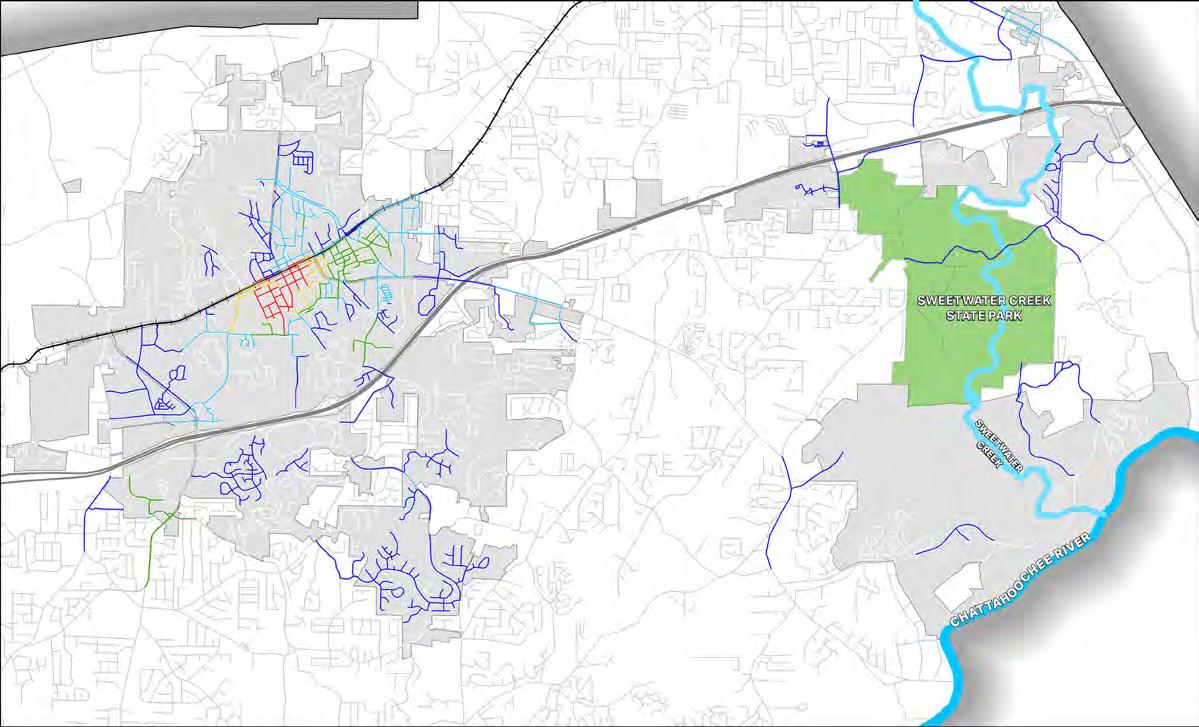

DESTINATIONAL BICYCLE CONNECTIVITY - ONE MILE
ONE-MILE travelsheds were created originating from destinations of interest along the street network (top map) and along the BICYCLE network (bottom map). For each segment of every road, the number of overlapping travelsheds was counted. This results in the DESTINATIONAL connectivity heat maps at right. Redder lines indicate that more travelsheds pass over that segment of street. Bluer lines indicate that relatively few travelsheds passed over that segment of street. The map below is the difference between the two maps at right. This highlights areas that are highly connected for streets but lacking connectivity for bicyclists.
POTENTIAL TARGETS TRAVELSHED
Once again, bicycle connectivity is hot in the downtown area and immediately cools off going into the north side. Meanwhile, potential connectivity needs have shifted slightly to highlight the south side of Campbellton Road, Duralee Lane, and Timber Ridge Road. Douglas Boulevard is also an obvious target, as is Fairburn Road near where the New SR 92 splits off.
LEGEND




LEGEND
CONNECTIVITY

LEGEND
CONNECTIVITY





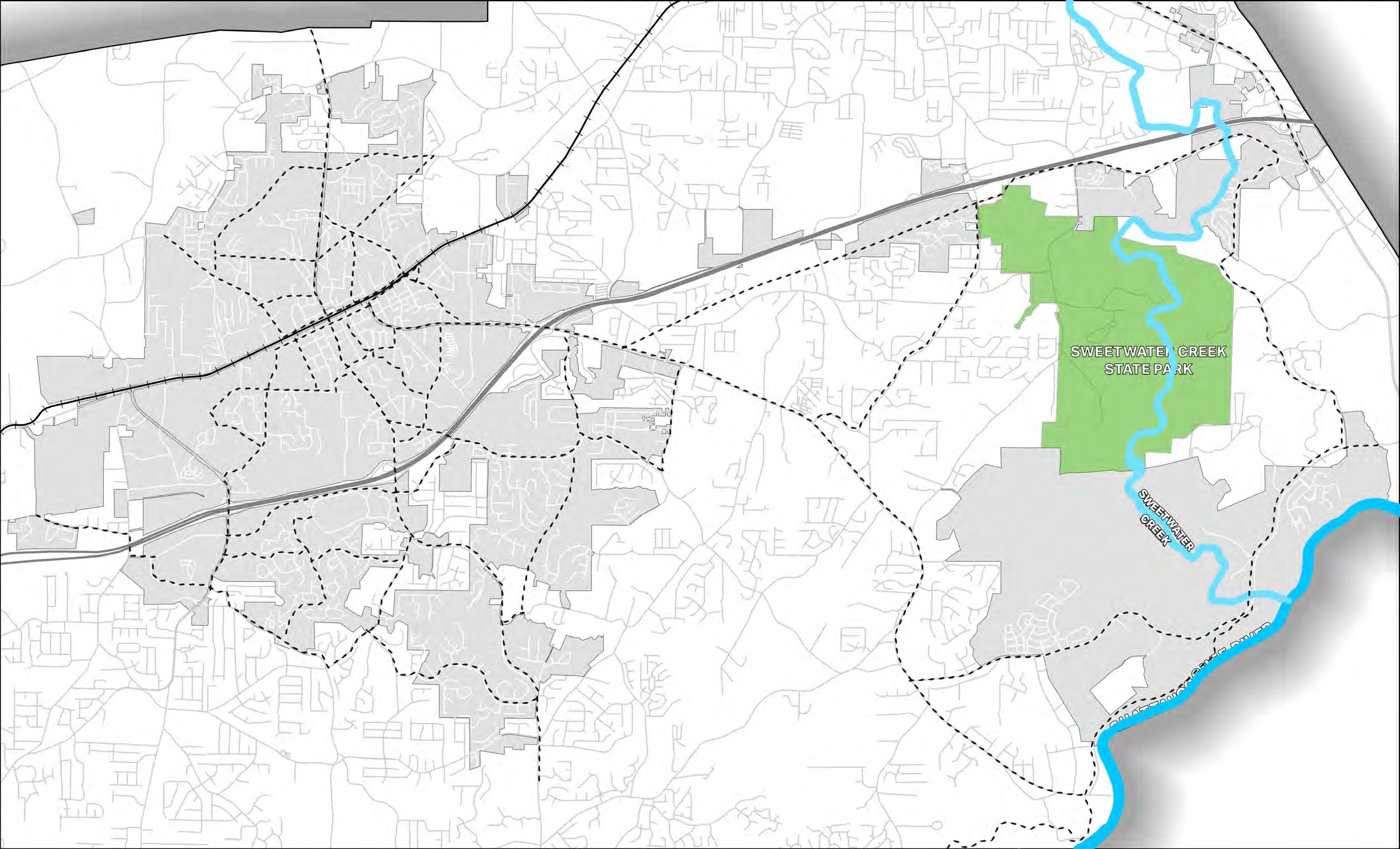



CHURCHST





This map depicts the initial priority corridors that resulted from the connectivity analysis in the preceding pages. The corridors outlined here will be critical to provide a solid foundation for active transportation in the City of Douglasville. In the next chapter, facilities will be recommended on each of these roads to complete the pedestrian and bicycle network. In the course of making recommendations, some of the connections identified here were altered or realigned or removed, and may not be reflected in the final recommendations.

BLAIRS BRIDGERD



NOTE: This plan is only scoped to study and make recommendations for the roads in Douglasville’s city limits. Initial Priority Corridors outside the limits are suggestions only.

COBB COUNTY
FULTON COUNTY
RIVERSIDE PKWY
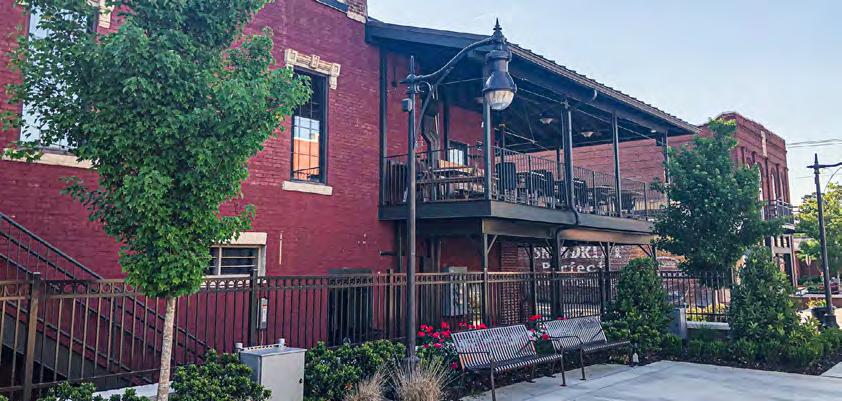



THE PROCESS PART III
RECOMMENDATIONS
3.0 Recommendations Overview 190-191
3.1 Organizing Framework: Loops ................................... 192-195
Greater Downtown ..................................................... 196-197
Arbor Place .................................................................. 198-199
Little Aneewakee 200-201
Sweetwater Creek ...................................................... 202-203
3.2 Gap Filling Maps ......................................................... 204-217
3.3 Recommendations Maps ........................................... 218-219
Overview of Infrastructure Types ............................... 220-221
Pedestrian Recommendations .................................. 222-233
Bicycle Recommendations ........................................ 234-245
3.4 Prioritized Projects 246-247
Scoring Methodology ................................................. 248-250
Top 30 Projects.............................................................251-285
3.5 Full Ranked Project List ............................................... 286-291
3.6 Before & After Heatmaps 292-293
Pedestrian .................................................................... 394-299
Bicycle .......................................................................... 300-305
3.0 RECOMMENDATIONS OVERVIEW
This chapter lays out the design team’s final recommendations to create a robust active transportation system in the City of Douglasville.
Organizing Framework: Loops
Before diving in for a closer look at the recommendations, it is important to understand the framework that the design team used. Our goal was to create fractal loops in the active transportation system. Flexibility and resiliency in transportation systems can be achieved through cultivating loops at various scales. With multiple loops weaving in and out of each other at a variety of scales, people can generally get where they need to go.
2
Gap Filling Maps
With an understanding of the macro-level framework, we can dive into the micro-level. After identifying the gaps in the Part I and the corridors that are connective in Part II, it is time to identify gaps in the network that need to be filled. In the gap filling maps, we map out the existing infrastructure, the infrastructure that is missing and needs to be built, and the infrastructure that needs to be upgraded.
4
Recommendations Maps
Once we’ve identified the gaps that need to be filled, the design team consolidated these gaps into a set of 122 projects that will create a reliable active transportation system for the City of Douglasville.
5
Prioritized Projects
Finally, we take the recommendations and run them through a rigorous prioritization process. The goal is to rank the projects from 1 to 122 on the basis of most impactful in pursuit of connectivity. The result is a stepby-step process to establish active transportation as a viable, useful, and joyful way to travel.

Before & After Heatmaps
At the end of this document, we will perform the same connectivity analysis that was conducted on the existing network in Part II. This time we will conduct the analysis on the final condition network to check our work. Once again, we take the difference between the before and the after to paint a picture of the impact that the following active transportation facility recommendations will have on the City of Douglasville’s connectivity.
ORGANIZING FRAMEWORK: LOOPS
3.1 ORGANIZING FRAMEWORK: LOOPS
The recommendations herein follow a general framework of cultivating loops in Douglasville’s transportation system. Active transportation loops provide a multitude of benefits for the surrounding community. First and foremost, they provide people throughout the city a corridor to get to and from their destinations safely and comfortably. Second, it is the perfect way to get people outside recreating - a loop permits people to get to the park, to go on long distance loop rides, and generally just get outside and exercise. Third, loops are the best way to break up the overall vision. They are discrete and actionable without being overwhelming. Most importantly, loops create marketing opportunities that can kick off incredible private sector investment.
FIGURE 33: Loops as an organizing framework.






INFRASTRUCTURE LEGEND


SHARED-USE
SIDEWALK
TWO-WAY
BIKE LANE




BOULEVARD/SHARROWS
GREENWAY/TRAIL






















FEATURES
OUTSIDE

PARKS


SCHOOLS
GROCERY
NS RAILROAD




















































RR CROSSING




































































































































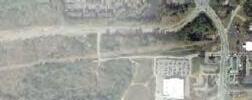





































































































































GREATER DOWNTOWN LOOP
The map at left depicts the Greater Downtown Area. Douglasville can mirror the success of the Atlanta Beltline and the Carrollton Greenbelt by making its own similar loop and branding it accordingly. This loop would provide people from all areas surrounding the downtown area to move freely throughout this part of Douglasville, accessing the hospital, the downtown area, and all of the schools and parks in this area. Having a loop system of this magnitude would bring in recreational tourists from all over Metro Atlanta.
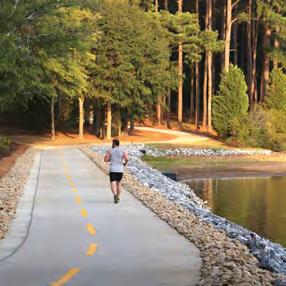

NORTHSIDE GREENWAY
Recommended in the Northside Redvelopment Plan, this trail would be a treasured asset for the surrounding communities. In addition to providing alternative transportation options, such an impactful trail would spur development and economic growth.
Image source: pathfoundation.org
CONCOURSE PARKWAY CYCLE TRACK
With two-lanes of motor vehicle traffic in each direction and no pedestrian or bicycle facilities, Concourse Parkway will greatly benefit from a cycle track. This will connect the Golf Club Trail with the Rose Avenue path to complete the Greater Downtown loop. It will also allow active transportation users to access Walmart and Sam’s Club, important consumer shopping destinations.
Image source: whatsnextatl.org


OLD DORRIS ROAD
This old road right-of-way runs right behind the Wellstar Douglas Hospital and ends at the multi-modal center. This is the perfect site for a trail - it connects to other modes of transportation, provides recreational opportunities for doctors and patients, and would run along an already cleared right-of-way that is owned by the City.
Image source: trailsandtravel.com
GOLF CLUB TRAIL
A trail connecting from Campbellton Street to Bill Arp Road to the west would be hugely connective for Douglasville. Without this trail, there is little east-west connectivity between Selman Drive and Douglas Blvd.
Image source: atlantatrails.com

ARBOR PLACE LOOP

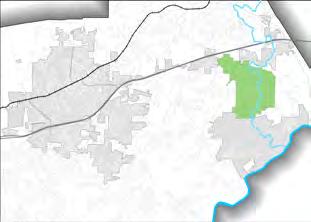
INFRASTRUCTURE LEGEND
SHARED-USE
SIDEWALK
TWO-WAY
BIKE LANE
BOULEVARD/SHARROWS
GREENWAY/TRAIL
FEATURES
OUTSIDE
SCHOOLS
NS


ARBOR PLACE AREA
The Arbor Place neighborhood is amongst the most populous neighborhoods in Douglasville. Furthermore, there are a great deal of businesses along Bill Arp Rd to the west and Chapel Hill Rd to the East. To top it all off, Arbor Place Mall sits at the north end of this area. An active transportation loop in this area would allow residents and shoppers alike to move in between their homes and their destinations on foot or on bike. This would have the added effect of reducing the traffic in this area, as people who live nearby, especially in the Arbor Place neighborhood, will be empowered to leave their cars behind as they travel to their shopping destination. One of the greatest benefits of a loop system in this area is that it will send a message to people that stop off in Douglasville’s shopping district that they have arrived in a place that cares about active transportation in their City.

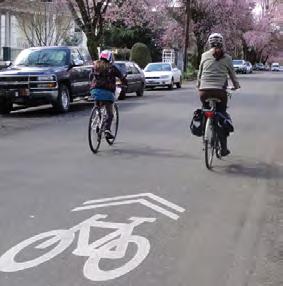
CAMPBELLTON STREET PATH
Campbellton Street has been identified as an important street in numerous City of Douglasville plans. It is a key corridor for providing north-south connectivity through the center of the City. A shared-use path here will create a solid foundation for future improvements to the active transportation network.
Image source: new.emory.edu
PINECREST DRIVE BIKE BOULEVARD
Creekwood Drive is one of the minor collectors for the Arbor Station community. It is important to maintain the neighborhood character of this area, protecting it from fast-moving thru-traffic seeking an east-west corridor. A bike boulevard would serve the dual-purpose of slowing and calming motor vehicle traffic while also allowing for pedestrians and cyclists to move freely and comfortably.
Image source: city.milwaukee.gov


ARBOR STATION GREENWAY
A key goal of this plan is to identify connectivity opportunities for children to get to school safely on foot or on bike. The stream that runs behind Arbor Station Elementary is perfect for this purpose. A greenway along it would connect the school into the neighborhood streets to allow for safe and seamless movement for students.
Image source: peachtreeresidential.com
PARK & RIDE GREENWAY
Arguably the best way to activate the Douglas County Park & Ride at the western end of the Arbor Place area is to provide multimodal transportation connections to it. The Stewart Greenway connects the Park & Ride to the stores in the Bill Arp Rd shopping area and up north across Interstate 20 along scenic paths into Hunter Park. We can encourage people to use Park & Rides is to make biking and walking from them more attractive than parking at their place of work.
Image source: ced.sog.unc.edu














PARKS






SCHOOLS GROCERY




OUTSIDE CITY LIMITS








NS RAILROAD
RR CROSSING
















































TIMBER RIDGERD.

































































































































































































INFRASTRUCTURE LEGEND















SHARED-USE PATH SIDEWALK









TWO-WAY CYCLE TRACK
BIKE LANE

BOULEVARD/SHARROWS
GREENWAY/TRAIL



INGLES
CHAPEL HILL RD.
PRESTLEY MILL RD.
LITTLE ANNEEWAKEE LOOP
The Little Aneewakee Area, centered around the Grace Lake community, is a highly connective active transportation loop. To the west lies the Arbor Place commercial district and several higher education institutions such as West Georgia Technical College. To the east is the longest greenway that we are proposing - Little Anneewakee Creek Greenway. It connects to Fowler Field Park and the Chapel Hill Golf Course community to the south. This loop would bring important active transportation connectivity to the many people living in and around this area, enabling them to partake in Douglasville’s natural beauty.
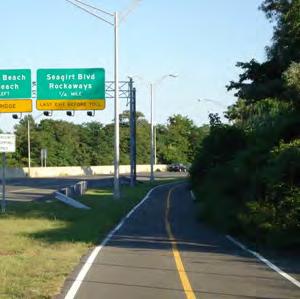

STATE ROUTE 92 PATH
Although this plan only recommends building a portion of the shared-use path along State Route 92, the full path from Douglasville to South Fulton County would be incredible for regional connectivity. S.R. 92 runs along a natural ridgeline, making it perfect for long-distance bicycle touring.
Image source: dot.ny.gov
LITTLE ANNEEWAKEE CREEK GREENWAY
Little Anneewakee Creek is the namesake for Douglasville’s main watershed. Water is a central feature in our lives, and natural resources such as these should be celebrated. What better way to celebrate this little creek than by integrating it into the active transportation system? A greenway here would allow people in the surrounding community to access Fowler Field and Chapel Hill schools to the south and the grocery store along State Route 92 to the north.
Image source: charlottenc.gov


PRESTLEY MILL ROAD PATH
This path is a critical east-west connection for the communities in the surrounding area. In addition, Prestley Mill Road is a very scenic route, which makes it perfect for a recreational pedestrian and bike path. To the west, it will connect with the multimodal center and eventually downtown Douglasville.
Image source: baybridgeinfo.org
CHAPEL HILL RD SHARED-USE PATH
There are three shared-use paths recommended along Chapel Hill Rd, indicating its importance to the City’s connectivity. Such a long path would act as the spine for the future transportation system, allowing people to get from the Chapel Hill schools down south to Fowler Field, to the grocery store, to the mall, and eventually to downtown Douglasville to the far north.
Image source: traillink.com
SWEETWATER CREEK LOOP
The map at right depicts the Sweetwater Creek Loop. This active transportation system will serve as the backbone for future residential developments. It provides for enjoyable recreational travel from the Tributary development up north to Preston Blvd while allowing access to Sweetwater Creek. Many of these roads are in the county, which is outside of the scope of this study. Such connections are depicted as suggestions only.

HOME DEPOT TRAIL
This trail would start at the northern edge of Sweetwater Creek State Park and follow the creek north to the I-20 overpass and lead north all the way to Thornton Rd. The point where Sweetwater Creek passes underneath I-20 is the path of least resistance for active transportation across the interstate.
Image source: FHWA Small Town and Rural Multimodal Networks Guide

REGIONAL GREENWAY TRAIL
The Chattahoochee Hill Country Regional Greenway Trail is a planned 100-mile trail that stretches through four Georgia counties: Carroll, Coweta, Douglas, and Fulton. The first segment of the trail is in planning and design. It will stretch from Boundary Waters Park (south of map extent) to the Northeast edge of Sweetwater Creek State Park.
Image source: enjoyburlington.com

RIVERSIDE PARKWAY PATH
Riverside Parkway is poised to become a gem of the Sweetwater Creek Area. This long and scenic route is the main east-west thoroughfare for this area of Douglasville. It carries a high proportion of truck traffic, making it perfect for a fully separated shared-use path.
Image source: nrtdatabase.org




















































































































RIVERSIDEPKWY
























































NS






























GAP-FILLING MAPS
3.2 GAP-FILLING MAPS
With an understanding of the overarching framework, we can dive into the recommendations. After analyzing network gaps and connective corridors in the first two parts of this study, we identify the gaps in the network that need to be filled to achieve a robust active transportation system. Once the gaps have been identified and sorted, we can consolidate them into actionable projects in the recommendations maps later on in this chapter.
FIGURE 34: Gaps in a transportation network.

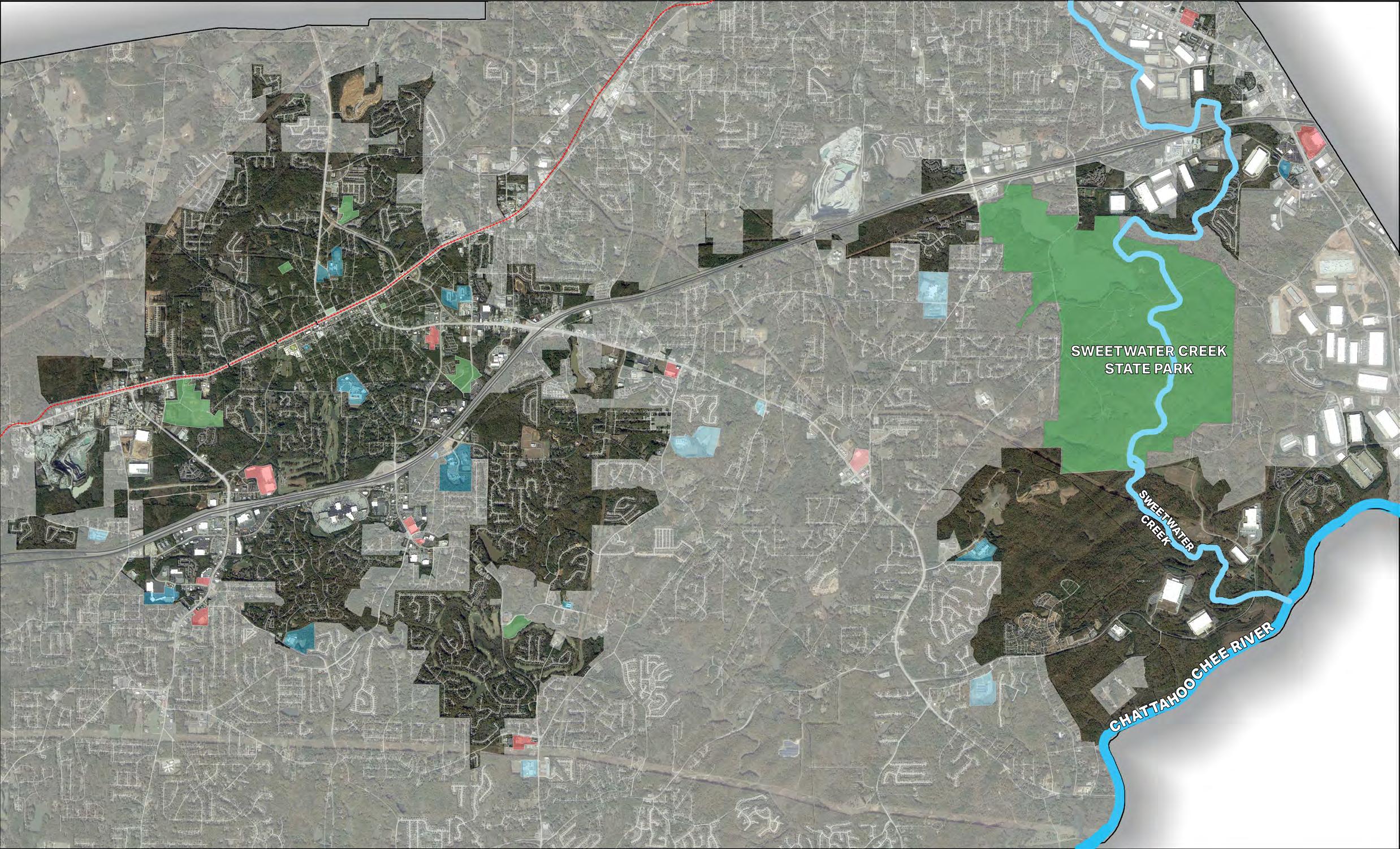
LEGEND
GAP FILLING MAP - LOCATION KEYMAP
CITY OF DOUGLASVILLE

GREATER DOWNTOWN PAGES 208-209
DOWNTOWN CORE PAGES 210-211
ROSE AVE


ARBOR PLACE AREA PAGES 212-213

OUTSIDE CITY LIMITS
PARKS
SCHOOLS
GROCERY
NS RAILROAD
INTERSTATE ROADS

LITTLE ANNEEWAKEE AREA PAGES 214-215


FAIRBURNRD
SWEETWATER CREEK AREA
PAGES 216-217





FULTON COUNTY
RIVERSIDE PKWY
INFRASTRUCTURE LEGEND


EXISTING
ADD
REMOVE EXISTING SIDEWALK
EXISTING/PROGRAMMED PATH
ADD
UPGRADE
ADD

SEEDOWNTOWNCORE MAPONPAGE218


INFRASTRUCTURE LEGEND


NO PROPOSED UPGRADE
EXISTING FACILITY TO REMAIN
REMOVE EXISTING FACILITY
UPGRADE SW TO SHARED-USE PATH
EXISTING/PROGRAMMED PATH
ADD NEW SHARED-USE PATH
ADD NEW ONE WAY CYCLE TRACK
ADD NEW TWO-WAY CYCLE TRACK
ADD NEW BIKE LANE
ADD NEW BOULEVARD/SHARROWS
ADD NEW GREENWAY/TRAIL
FEATURES
OUTSIDE CITY LIMITS PARKS SCHOOLS GROCERY NS RAILROAD RR CROSSING


INFRASTRUCTURE LEGEND
NO SIDEWALK, NO UPGRADE
EXISTING SIDEWALK TO REMAIN
REMOVE EXISTING SIDEWALK
ADD NEW SIDEWALK
UPGRADE SW TO SHARED-USE PATH
EXISTING/PROGRAMMED PATH
ADD NEW SHARED-USE PATH
ADD NEW GREENWAY/TRAIL
STEWART MIDDLE SCHOOL
PARKS SCHOOLS
GROCERY


DALLAS HWY. STRICKLANDST. VETERAN’SMEMORIALHWY.
NS RAILROAD
RR
HISTORIC
DOWNTOWN
FAIRBURNRD .
CHURCHST. CAMPBELLTON
DUNCANST


INFRASTRUCTURE LEGEND


NO PROPOSED UPGRADE
EXISTING FACILITY TO REMAIN
REMOVE EXISTING FACILITY
UPGRADE SW TO SHARED-USE PATH
EXISTING/PROGRAMMED PATH
ADD NEW SHARED-USE PATH
ADD NEW ONE WAY CYCLE TRACK
ADD NEW TWO-WAY CYCLE TRACK
ADD NEW BIKE LANE
ADD NEW BOULEVARD/SHARROWS
ADD NEW GREENWAY/TRAIL
STEWART MIDDLE SCHOOL
PARKS
SCHOOLS
GROCERY
DALLAS HWY. STRICKLANDST. VETERAN’SMEMORIALHWY.
NS RAILROAD
RR CROSSING
HISTORIC
DOWNTOWN
FAIRBURNRD .
CHURCHST.
CAMPBELLTON S T
DOUGLAS COUNTY HIGH SCHOOL FUTURE TOWN GREEN
SELMAN DR.



PEDESTRIAN GAP FILLING MAP
ARBOR PLACE AREA

INFRASTRUCTURE LEGEND
NO SIDEWALK, NO UPGRADE
EXISTING SIDEWALK TO REMAIN
REMOVE EXISTING SIDEWALK
ADD NEW SIDEWALK
UPGRADE SW TO SHARED-USE PATH
EXISTING/PROGRAMMED PATH
ADD NEW SHARED-USE PATH
ADD NEW GREENWAY/TRAIL
FEATURES
OUTSIDE CITY LIMITS
PARKS
SCHOOLS
GROCERY
NS RAILROAD
RR CROSSING



BICYCLE GAP FILLING MAP
ARBOR PLACE AREA

INFRASTRUCTURE LEGEND
NO PROPOSED UPGRADE
EXISTING FACILITY TO REMAIN
REMOVE EXISTING FACILITY
UPGRADE SW TO SHARED-USE PATH
EXISTING/PROGRAMMED PATH
ADD NEW SHARED-USE PATH
ADD NEW ONE WAY CYCLE TRACK
ADD NEW TWO-WAY CYCLE TRACK
ADD NEW BIKE LANE
ADD NEW BOULEVARD/SHARROWS
ADD NEW GREENWAY/TRAIL
FEATURES
OUTSIDE CITY LIMITS
PARKS
SCHOOLS
GROCERY
NS RAILROAD
RR CROSSING



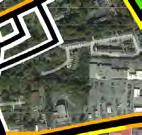
OUTSIDE
PARKS
SCHOOLS
GROCERY
NS


RR CROSSING





































PEDESTRIAN GAP





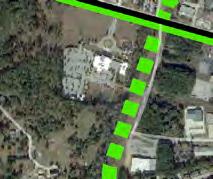













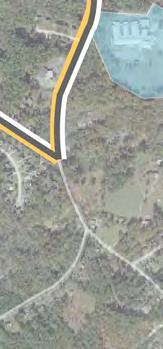


INFRASTRUCTURE LEGEND


UPGRADE

EXISTING/PROGRAMMED PATH
ADD
ADD
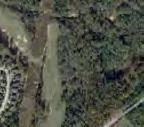



PRESTLEY MILL RD.


OUTSIDE

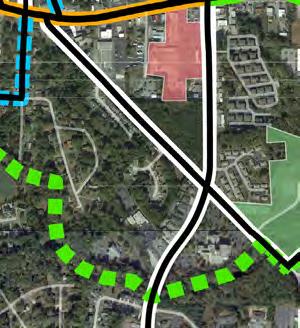

SCHOOLS
GROCERY
NS RAILROAD
RR CROSSING
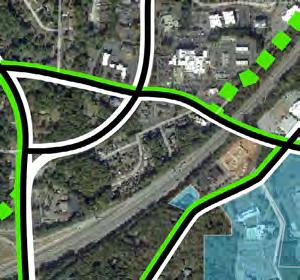
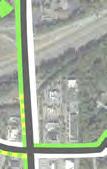










































INFRASTRUCTURE LEGEND
















EXISTING FACILITY TO REMAIN
REMOVE EXISTING FACILITY
UPGRADE SW TO SHARED-USE PATH
EXISTING/PROGRAMMED PATH
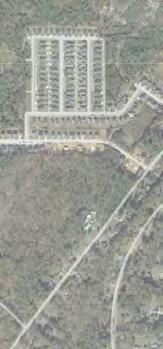
ADD NEW SHARED-USE PATH
ADD NEW ONE WAY CYCLE TRACK
ADD NEW TWO-WAY CYCLE TRACK


ADD NEW BIKE LANE
ADD NEW BOULEVARD/SHARROWS
ADD NEW GREENWAY/TRAIL


PRESTLEY MILL RD.




PEDESTRIAN GAP FILLING MAP




SWEETWATER CREEK AREA














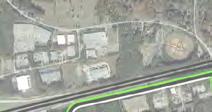





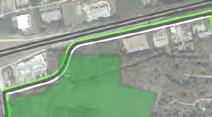







FEATURES

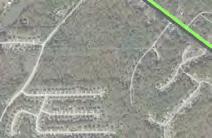


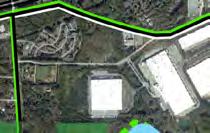
























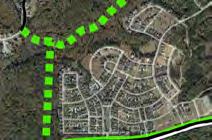












RIVERSIDEPKWY


INFRASTRUCTURE LEGEND
NO

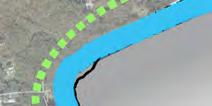





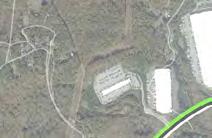








EXISTING SIDEWALK
ADD
REMOVE









EXISTING/PROGRAMMED PATH
ADD NEW SHARED-USE PATH



UPGRADE SW TO SHARED-USE PATH
ADD NEW GREENWAY/TRAIL






BICYCLE GAP FILLING MAP




SWEETWATER CREEK AREA












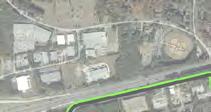



MONIER AVE. LEERD MT.VERNONRD.


STATEROUTE92










FEATURES





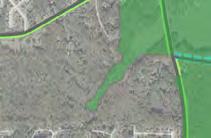
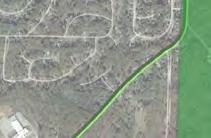

BLAIRSBRIDGERD




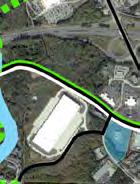







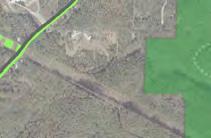
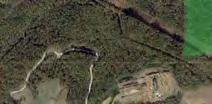

TRIBUTARYTRAIL



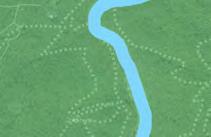
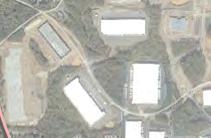









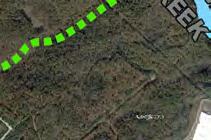



RIVERSIDEPKWY











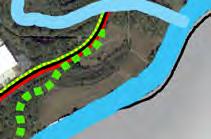




INFRASTRUCTURE LEGEND
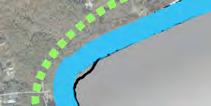


EXISTING FACILITY TO REMAIN
REMOVE EXISTING FACILITY
UPGRADE SW TO SHARED-USE PATH
EXISTING/PROGRAMMED PATH








ADD NEW SHARED-USE PATH

ADD NEW ONE WAY CYCLE TRACK
ADD NEW BIKE LANE
ADD



ADD NEW TWO-WAY CYCLE TRACK
ADD NEW BOULEVARD/SHARROWS


RECOMMENDATIONS MAPS
3.3 RECOMMENDATIONS MAPS
The maps on the following pages represent the design team’s recommendations to achieve a completely connected active transportation network in the City of Douglasville. Once the gaps were identified in the existing conditions phase and the priority corridors were chosen in the network analysis effort, the design team used their experience to consolidate the gaps into specific, actionable projects that would have a positive impact on active transportation connectivity.
These maps represent the final vision for the future of active transportation in the City of Douglasville.

NOTE: These recommendations are planning level only. Project centerlines are approximate in nature. Preliminary engineering work should be performed to assess feasibility. Furthermore, rightof-way was not considered in the course of making these recommendations because the design team lacked survey to make such assessments.
FIGURE 35: Future vision of downtown.
OVERVIEW OF INFRASTRUCTURE TYPES
Before diving into the recommendations, it is important to understand the different types of facilities that will be recommended. The cross sections below are to illustrate the typical condition - they are approximate and not to scale. Detailed preliminary engineering is required for the corridor under consideration before any cross section is selected. In the maps that follow, each project is labeled with a project code (that corresponds to one of these infrastructure types) and a number that corresponds to that specific project. The project codes are detailed next to the name of the infrastructure type.
Sidewalks................................SW
5’ to 10’ wide concrete paths intended for exclusive pedestrian use. These enable people of all ages to walk wherever they need to go. It is critical that these sidewalks meet ADA guidelines so that people of all ages and abilites can make it to their destination on a fully connected facility. These are the most commonly recommended facility because at the end of the day, everyone is a pedestrian.


Shared-Use Paths.......................SUP
These minimum 10’ concrete paths are intended for use by pedestrians and bicyclists. Shared-Use Paths are great infrastructure improvements because they provide pedestrians and bicyclists a facility that is completely separated from vehicular traffic. Such improvements are perfect for conditions with high vehicular speeds, two lane thoroughfares, and wide rights-of-way. Such corridors are numerous throughout Douglasville, which is why Shared-Use Paths are the second most recommended infrastructure addition.
Greenways/Trails.....................................TR
Greenways and Trails are similar to Shared-Use Paths except that they do not follow street rights-of-way. Instead, they tend to run through more natural places, such as through the woods or along rivers and streams. Greenways are treasured additions to any city’s transportation system. Not only do they provide much needed active transportation connectivity, but their beautiful vistas and quiet areas provide citizens much needed outdoor recreation. Furthermore, greenways such as the Atlanta Beltline, the Carrollton Greenbelt, and Alpharetta’s Big Creek Greenway make it clear that infrastructure can play a big role in economic development.

Sidewalk 5’ min
Greenway/ Trail 10’ min

Complete Streets.....CS
These streets are designed with all potential users in mind. That includes cars, pedestrians, and cyclists, but should also include users such as bus riders and even unorthodox modes of transportation such as skateboards and scooters. Streets such as these are often the Main Street of the city, and act as the seat for the local economy.
Cycle Tracks...............................................CT
A cycle track is essentially a bike lane that is separated from traffic. This separation can be achieved with as little as a 2’ striped buffer and plastic bollards, but more permanent separation (such as the landscaped buffer in the cross section above) is preferred. The simple addition of the protected buffer to a dedicated lane for bicyclists makes people feel much more comfortable riding near vehicular traffic. Often, these can be constructed simply by rededicating a lane of traffic. Cycle tracks can be two-way (at right) or one-way pairs (above).

Bike Lanes...............................................BL
Bike lanes are the standard facility for bicycles. They are simply a 5’ wide lane adjacent to the traveled way. Although bike lanes are a widely recommended infrastructure implementation, they should really only be used in constrained conditions where a protected or separated facility is not possible. At the end of the day, the only thing separating the bikes from dangerous motor traffic is a white line.
Bike Boulevards.................................BB
Bike Boulevards are a low-impact implementation that promotes the use of local streets for bicycle travel. Local streets are perfect for bicycle travel - they are typically low-speed and low-volume in terms of motor vehicles, and often they run parallel to more hostile thoroughfares. By installing sharrows to indicate that bicyclists belong in the road and wayfinding signage to make the route clear, these are great low-cost additions to round out the network of more costly infrastructure options.




CITY


GREATER DOWNTOWN PAGES 224-225

DOWNTOWN CORE PAGES 226-227
DOUGLAS BLVD


LITTLE ANNEEWAKEE AREA PAGES 230-231


CHAPEL HILLRD BILLARPRD
ARBOR PLACE AREA PAGES 228-229
LEGEND
OUTSIDE CITY LIMITS
PARKS
SCHOOLS
GROCERY
NS RAILROAD
INTERSTATE ROADS
EXISTING SIDEWALK
PROPOSED SIDEWALK
SHARED-USE PATH GREENWAY/TRAIL

FAIRBURNRD
SWEETWATER CREEK AREA
PAGES 232-233




NOTE: The faded out aerial represents areas that are NOT in the city limits. AECOM was limited in scope to streets within the city limits of Douglasville. Any projects depicted here outseide of the city limits were NOT studied and are not listed - they are merely suggestions for consideration.






GREATER DOWNTOWN AREA PEDESTRIAN RECOMMENDATIONS

NOTE: For hybrid projects (pedestrian and bicycle accessible) see page 243. FIGURE 36: Greater Downtown Area pedestrian project list.

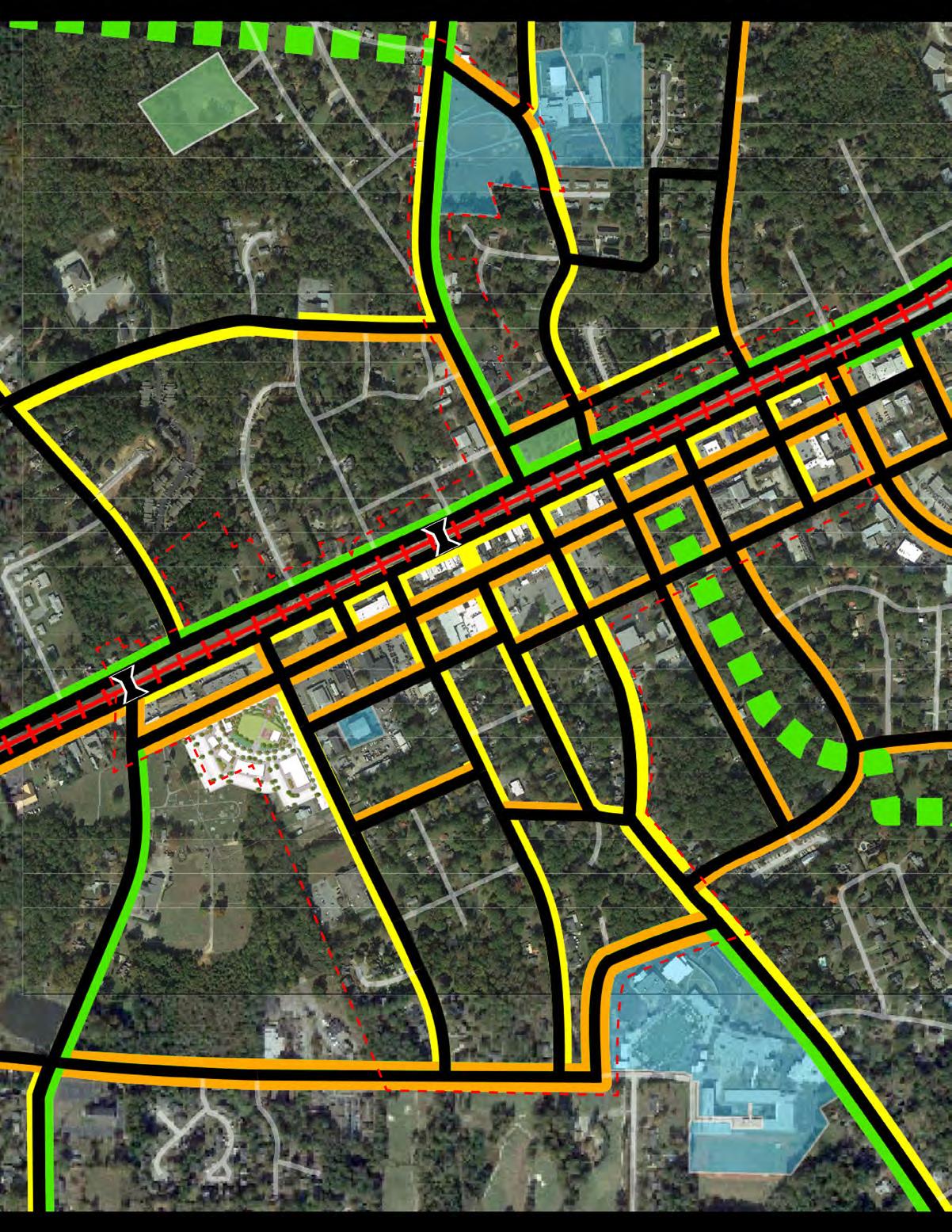


DOWNTOWN CORE PEDESTRIAN RECOMMENDATIONS

FIGURE 37: Downtown Core pedestrian project list.
FIGURE 38: Downtown Core pedestrian + bicycle project list.




ARBOR PLACE AREA PEDESTRIAN RECOMMENDATIONS
PEDESTRIAN PROJECTS

PEDESTRIAN + BICYCLE PROJECTS
FIGURE 39: Arbor Place Area pedestrian project list.
FIGURE 40: Downtown Core pedestrian + bicycle project list.



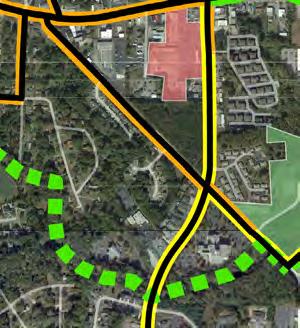
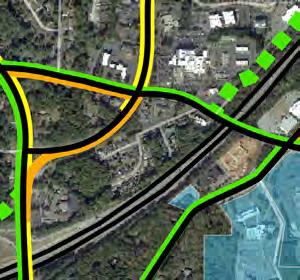































































LEGEND
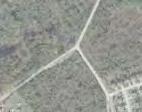

LITTLE ANNEEWAKEE AREA
PEDESTRIAN + BICYCLE PROJECTS
FIGURE 41: Little Aneewakee Area pedestrian project list.
FIGURE 42: Little Aneewakee Area pedestrian + bicycle project list.
SWEETWATER CREEK AREA PEDESTRIAN RECOMMENDATIONS
PEDESTRIAN PROJECTS
PEDESTRIAN + BICYCLE PROJECTS
FIGURE 43: Sweetwater Creek Area pedestrian project list.
FIGURE 44: Sweetwater Creek Area pedestrian + bicycle project list.















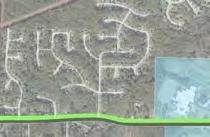


















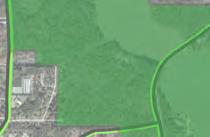






































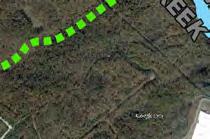






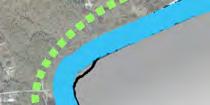






















INFRASTRUCTURE LEGEND
EXISTING SIDEWALK
PROPOSED SIDEWALK




PROPOSED SHARED-USE PATH
PROPOSED GREENWAY/TRAIL




LEGEND
CITY OF DOUGLASVILLE

GREATER DOWNTOWN PAGES 236-237
DOWNTOWN CORE PAGES 238-239
ROSE AVE


ARBOR PLACE AREA PAGES 240-241

OUTSIDE CITY LIMITS
PARKS
SCHOOLS
GROCERY
NS RAILROAD
INTERSTATE ROADS
SHARED-USE PATH
ONE WAY CYCLE TRACK
TWO-WAY CYCLE TRACK
BIKE LANE
BOULEVARD/SHARROWS
GREENWAY/TRAIL
NEW92
LITTLE ANNEEWAKEE AREA PAGES 242-243



CHAPEL HILLRD
FAIRBURNRD
SWEETWATER CREEK AREA
PAGES 244-245




NOTE: The faded out aerial represents areas that are NOT in the city limits. AECOM was limited in scope to streets within the city limits of Douglasville. Any projects depicted here outseide of the city limits were NOT studied and are not listed - they are merely suggestions for consideration.





GREATER DOWNTOWN AREA BICYCLE RECOMMENDATIONS


FIGURE 45: Greater Downtown Area bicycle project list.
FIGURE 46: Greater Downtown Area pedestrian + bicycle project list.
INFRASTRUCTURE LEGEND
SHARED-USE PATH
ONE WAY CYCLE TRACK
TWO-WAY CYCLE TRACK
BIKE LANE
BOULEVARD/SHARROWS
GREENWAY/TRAIL
FEATURES
PARKS
SCHOOLS
GROCERY
NS
PROJECT


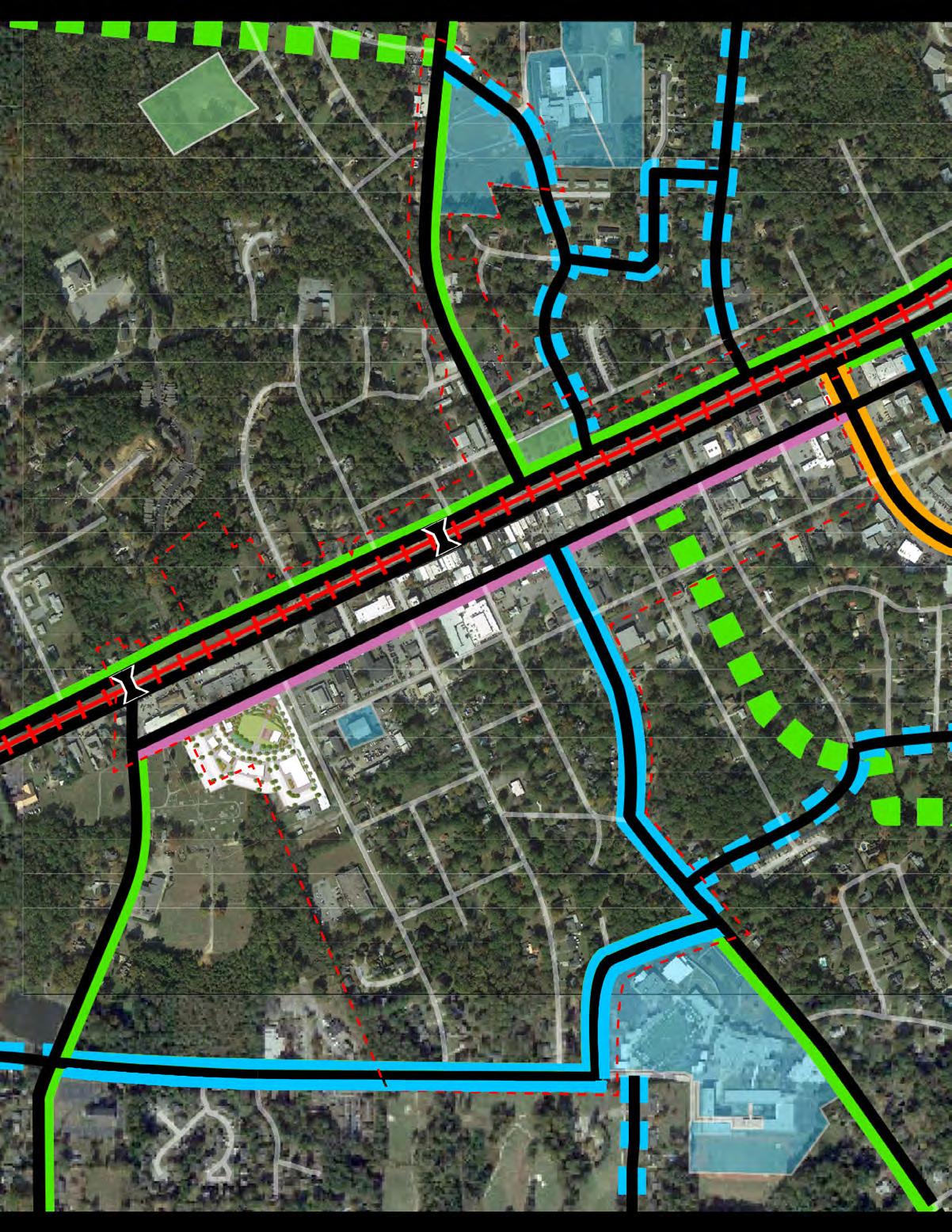

DOWNTOWN CORE BICYCLE RECOMMENDATIONS

FIGURE 47: Downtown Core bicycle project list.
FIGURE 48: Downtown Core pedestrian + bicycle project list.





ARBOR PLACE AREA BICYCLE RECOMMENDATIONS

BICYCLE PROJECTS
PEDESTRIAN + BICYCLE PROJECTS
FIGURE 49: Arbor Place Area bicycle project list.
FIGURE 50: Arbor Place Area pedestrian + bicycle project list.


























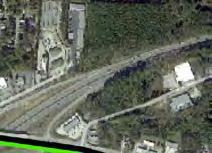








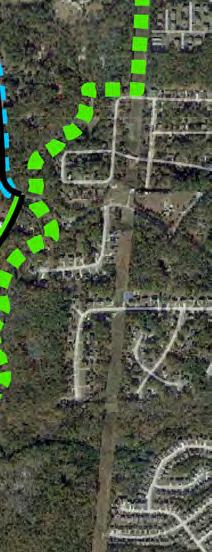

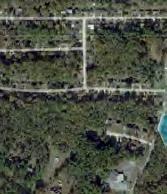





















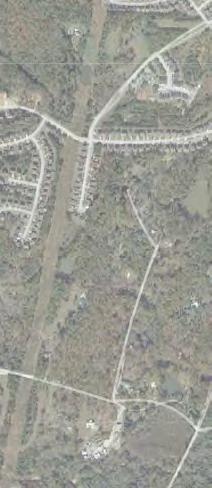





LITTLE ANNEEWAKEE AREA BICYCLE
FIGURE 51: Little Aneewakee Area bicycle project list.
FIGURE 52: Little Aneewakee Area pedestrian + bicycle project list.
SWEETWATER CREEK AREA BICYCLE RECOMMENDATIONS
PEDESTRIAN + BICYCLE
FIGURE 53: Sweetwater Creek Area bicycle project list.
FIGURE 54: Sweetwater Creek Area pedestrian + bicycle project list.

























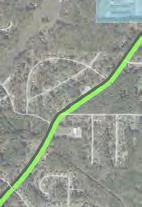




































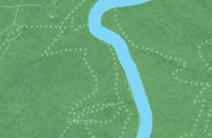









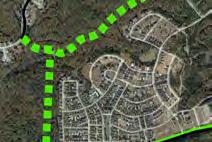















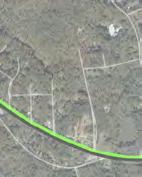
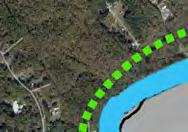


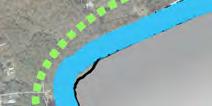















SHARED-USE PATH ONE WAY CYCLE TRACK TWO-WAY CYCLE TRACK BIKE LANE


PRIORITIZED PROJECTS
1 2 3
3.4 PRIORITIZATION METHODOLOGY
Once the design team identified a set of projects, the next step was to prioritize these recommendations. The methodology employed in analyzing the network in Part II was extended to assess the connectivity surrounding the projects themselves. By creating different types of travelsheds originating from the project under consideration, counting the number of important places that fall within those travelsheds, and normalizing those counts to the length of the project, we can get a clear picture of the project’s connectivity context.
This picture of connectivity context is then layered with support from a variety of stakeholders and rough cost estimates that are backed up by AECOM’s design expertise. The result is a nuanced prioritization that captures the many facets that make a city consider building a project.
FIGURE 55: Illustration of highly connective project.
SCORING DATA METHODOLOGY
In order to prioritize these recommendations, we created an entirely new methodogy. It is analagous to the way that the connectivity of the entire network was assessed, but instead of looking at the network as a whole, we are looking at individual corridors. Take for example the Shared-Use Path that is recommeneded along Prestley Mill Rd.
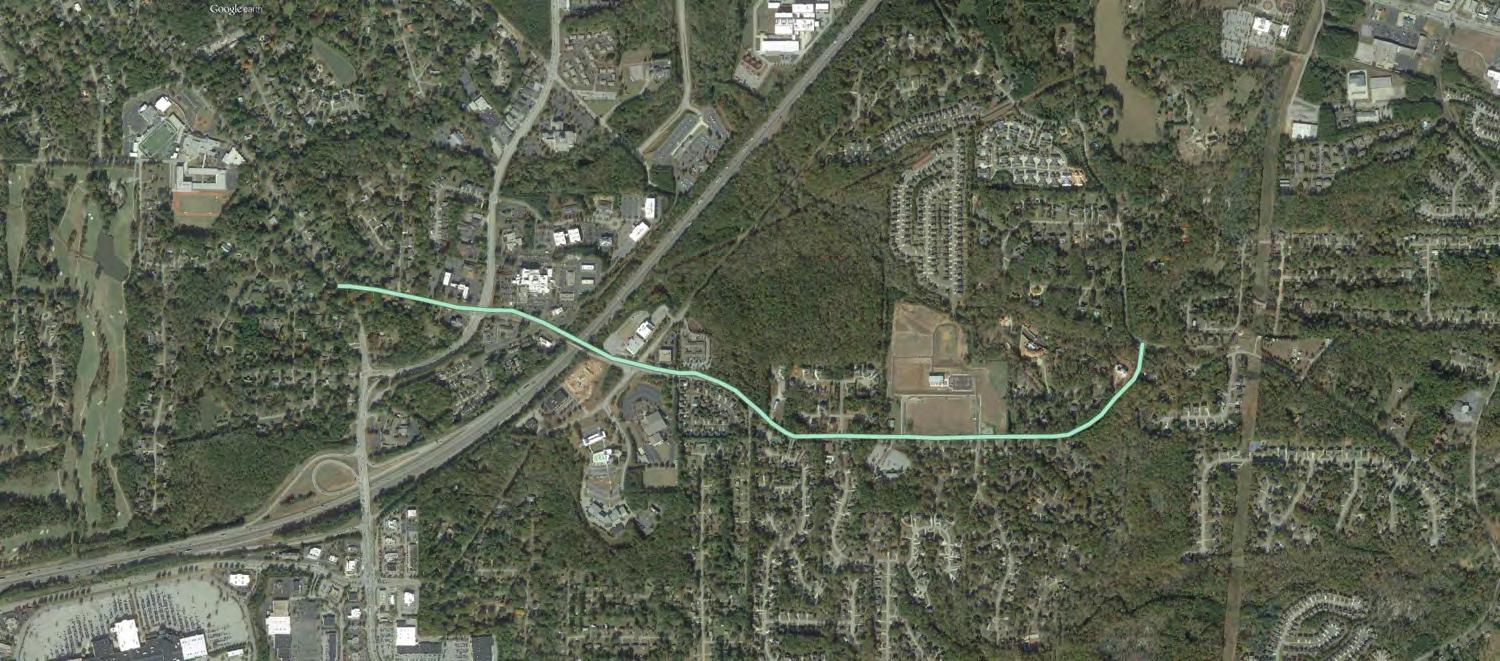
We first build a travelshed from the project itself. The travelshed below is the quarter-mile travelshed - quarter-, half- or one-mile travelsheds are used depending on whether the project is meant for pedestrians, for cyclists, or for both. Then, as you can see on the following page, we count the number of applicable points of interest that lie in the travelshed.

PRESTLEY MILL RD
PRESTLEY MILL RD
FIGURE 56: Quarter-mile travelshed around Prestley Mill Road.

“We

Same PrestleyMill frame with travelshedsand parcels “We measured the number of parcels in the travelsheds…”


35
Prioritizing Projects 36



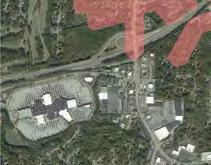




The next step is to assess mathematical characteristics of the network. These characteristics include the number of intersections and the mileage of streets in the travelshed. Such aspects of the project paint an objective picture of its connectivity. Projects whose travelsheds contain higher numbers of intersections are more likely to connect to places of interest. Higher street mileage in the travelshed indicates that the project will impact and be accessible from more streets. These measures can then be compared from project to project to judge them on an apples to apples basis.



Prioritizing Projects
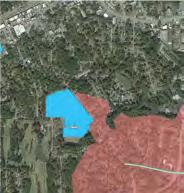
Same
“We
the






36
We also count the number of important places that are within the travelshed. The number of bus stops, schools, parks, residences, businesses, and jobs within the travelshed provide a powerful and relatable gauge of the project’s connectivity. When a project is connected to a variety of these places at once, it is more likely to be impactful to a greater number of people. The destinations of interest that we included in our study are depicted with the icons below. Later on in this section on the project explanation sheets, each project will receive a badge indicating that that destination lies within its travelshed.


Same Prestley Mill frame with travelsheds and
measured the number of in the travelsheds ”
We Count the Street Mileage in the Travelshed
PrestleyMill frame with travelshedsand bus stops
measured
number of bus stops in the travelsheds…”
Same Prestley Mill frame with travelsheds and bus “We measured the number of bus stops in the travelsheds ”
We Count the Schools in the Travelshed
37 We Count the Bus Stops in the Travelshed
Prioritizing Projects
FIGURE 57: Sample of metrics used to prioritize projects.
FIGURE 58: Icons used to indicate connectivity to places in priority project sheets.
We Count the residentialparcels inthetravelshed
-Connectivity -Project Support -Planning Level Cost Estimate

Metrics -Connectivity to More or FewerNormalized -Connectivity per Project Mileage Network ConnectivityConnectivity to PlacesNetwork ConnectivityConnectivity to Places
per Project Mileage
The scoring chart is displayed above. At the top level (Connectivity) is the mileage of the travelshed. The next level indicates whether the parameter being studied is an absolute value or if it has been normalized to the length of the project in question. The last overarching level indicates whether the parameter is a facet of the inherent interconnectedness of the system surrounding the project or is a measure of the absolute number of applicable points of interest in the surrounding system. Each project goes through these criteria and is assigned a score that is normalized to the highest score that was received. This process is repeated for each applicable travelshed length.
At right are three additional criteria. The first is Project Support, which assigns points stakeholder input, public input, and Steering Committee input. For an explanation of our input process, see Appendix C. The next criteria is a planning level cost estimate. Costlier projects received lower scores and vice-versa, to capture the impact that less expensive projects have on rapidly scaling up connectivity. For an explanation of our costing methodology, see Appendix A. The last criteria captures the potential economic development that would occur as a result of the project. Big ticket projects such as the Fairburn Road Complete Street Project receive points because of the impact it will have.



TOP 30 PROJECTS
The projects ranked the highest are listed in the table below. All of these projects except for two fall in the area surrounding downtown. These projects are mapped out on the following pages.

FIGURE 61: Top 30 ranked projects.






PROPOSED SHARED-USE PATH
PROPOSED GREENWAY TRAIL
EXISTING SIDEWALK
PROPOSED SIDEWALK

BURNETT ELEMENTARY EASTSIDE ELEMENTARY








LEGEND
PROPOSED SHARED-USE PATH
PROPOSED GREENWAY TRAIL
PROPOSED TWO-WAY CYCLE TRACK
PROPOSED ONE-WAY CYCLE TRACK PAIR
PROPOSED BIKE BOULEVARD

BURNETT ELEMENTARY EASTSIDE ELEMENTARY WOODIE FITE


MULTIMODAL CENTER
RANK 1: CLUB DRIVE SIDEWALK
AT-A-GLANCE
K
LEGEND
SHARED-USE PATH GREENWAY/TRAIL
EXISTING SIDEWALK PROPOSED SIDEWALK
PARKS
SCHOOLS GROCERY
NS RAILROAD
RR CROSSING
PROJECT ENDPOINTS

STRONG CONNECTIONS





CROSS SECTIONS


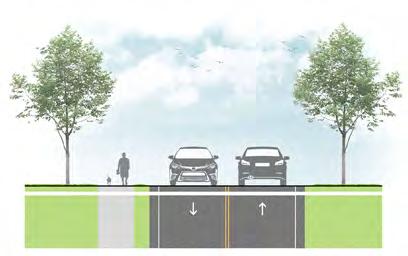
RANK 2: STEWART MIDDLE BOULEVARD
AT-A-GLANCE
TYPE: Bike Boulevard
LENGTH: 1.37 miles
PRIORITY: 2
EST. COST: $49 K SCORE: 100/100
LEGEND
SHARED-USE PATH
GREENWAY/TRAIL
TWO-WAY CYCLE TRACK
ONE-WAY CYCLE TRACK PAIR
BIKE LANES
BIKE BOULEVEARD
PARKS
SCHOOLS GROCERY
NS RAILROAD
RR CROSSING
PROJECT ENDPOINTS
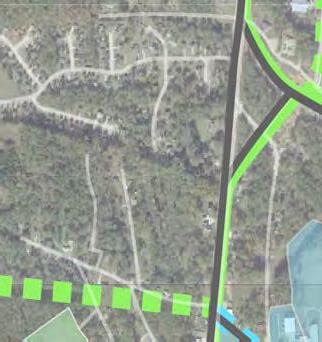

STRONG CONNECTIONS




CROSS SECTIONS






RANK 3: CAMPBELLTON STREET BIKE LANE
AT-A-GLANCE
TYPE: Bike Lane
LENGTH: 2470 ft
PRIORITY: 3
EST. COST: $118 K
SCORE:
LEGEND
SHARED-USE PATH
GREENWAY/TRAIL
TWO-WAY CYCLE TRACK
ONE-WAY CYCLE TRACK PAIR
BIKE LANES
BIKE BOULEVEARD
PARKS
SCHOOLS
GROCERY
NS RAILROAD
RR CROSSING
PROJECT ENDPOINTS
STRONG CONNECTIONS




CROSS SECTIONS




RANK 4: DALLAS HIGHWAY SIDEWALK
AT-A-GLANCE
TYPE: Sidewalk
LENGTH: 450 ft
PRIORITY: 4
EST. COST: $63 K
SCORE: 95/100
LEGEND
SHARED-USE PATH
GREENWAY/TRAIL
EXISTING SIDEWALK
PROPOSED SIDEWALK
PARKS
SCHOOLS
GROCERY
NS RAILROAD
RR CROSSING
PROJECT ENDPOINTS

CHURCHST.


STRONG CONNECTIONS


SCHOOLS
CROSS SECTIONS




RESIDENCES START!
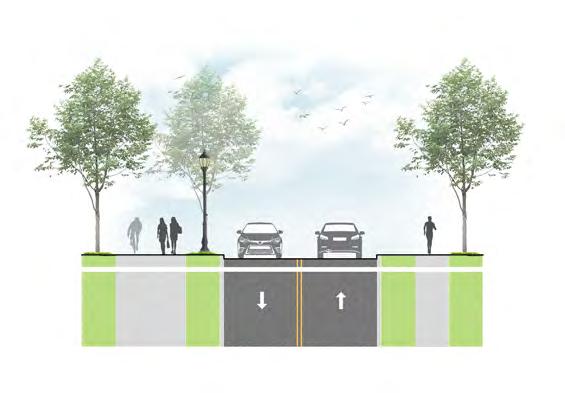
RANK 5: FAIRBURN ROAD SHARED-USE PATH
AT-A-GLANCE
TYPE: Shared-Use Path
LENGTH: 1410 ft
PRIORITY: 5
EST. COST: $609 K
SCORE: 88/100
LEGEND
SHARED-USE PATH GREENWAY/TRAIL
EXISTING SIDEWALK PROPOSED SIDEWALK
PARKS
SCHOOLS
GROCERY
NS RAILROAD
RR CROSSING
PROJECT ENDPOINTS

EASTSIDE ELEMENTARY
BURNETT ELEMENTARY

NOTE:




RANK 6: MALONE ROAD BIKE BOULEVARD
AT-A-GLANCE
TYPE: Bike Boulevard
LENGTH: 2580 ft
PRIORITY: 6
EST. COST: $18 K
SCORE: 88/100
LEGEND
SHARED-USE PATH
GREENWAY/TRAIL
TWO-WAY CYCLE TRACK
ONE-WAY CYCLE TRACK PAIR
BIKE LANES
BIKE BOULEVEARD
PARKS
SCHOOLS GROCERY
NS RAILROAD
RR CROSSING
PROJECT ENDPOINTS


STRONG CONNECTIONS


JOBS SCHOOLS
CROSS SECTIONS





RANK 7: E. STRICKLAND STREET SHARED-USE PATH
AT-A-GLANCE
TYPE: Shared-Use Path
LENGTH: 3900 ft
PRIORITY: 7
EST. COST: $1.64 M
SCORE: 83/100
LEGEND
SHARED-USE PATH
GREENWAY/TRAIL
EXISTING SIDEWALK
PROPOSED SIDEWALK
PARKS
SCHOOLS
GROCERY
NS RAILROAD
RR CROSSING
PROJECT ENDPOINTS


STRONG CONNECTIONS


DALLAS HWY.

FAIRBURNRD. CHURCHST.





CROSS SECTIONS

NOTE:



RANK 8: CLARK STREET SIDEWALK
AT-A-GLANCE
TYPE: Sidewalk
LENGTH: 670 ft
PRIORITY: 8
EST. COST: $91 K
SCORE: 83/100
LEGEND
SHARED-USE PATH
GREENWAY/TRAIL
EXISTING SIDEWALK
PROPOSED SIDEWALK
PARKS
SCHOOLS GROCERY
NS RAILROAD
RR CROSSING
PROJECT ENDPOINTS

STRONG CONNECTIONS

JOBS



CROSS SECTIONS



DOUGLAS
RANK 9: W. STRICKLAND STREET SHARED-USE PATH
AT-A-GLANCE
TYPE: Shared-Use Path
LENGTH: 4360 ft
PRIORITY: 9
EST. COST: $1.83 M
SCORE: 83/100
LEGEND
SHARED-USE PATH
GREENWAY/TRAIL
EXISTING SIDEWALK PROPOSED SIDEWALK
PARKS
SCHOOLS GROCERY
NS RAILROAD
RR CROSSING
PROJECT ENDPOINTS
STRONG CONNECTIONS



CROSS SECTIONS
CHICAGOAVE.



NOTE:



RANK 10: CHURCH STREET COMPLETE STREET
AT-A-GLANCE
TYPE: Complete Street
LENGTH: 4560 ft
PRIORITY: 10
EST. COST: $2.32 M SCORE: 82/100
LEGEND
SHARED-USE PATH
GREENWAY/TRAIL
EXISTING SIDEWALK
PROPOSED SIDEWALK
PARKS
SCHOOLS
GROCERY
NS RAILROAD
RR CROSSING
PROJECT ENDPOINTS
STRONG CONNECTIONS

CROSS SECTIONS
NOTE:



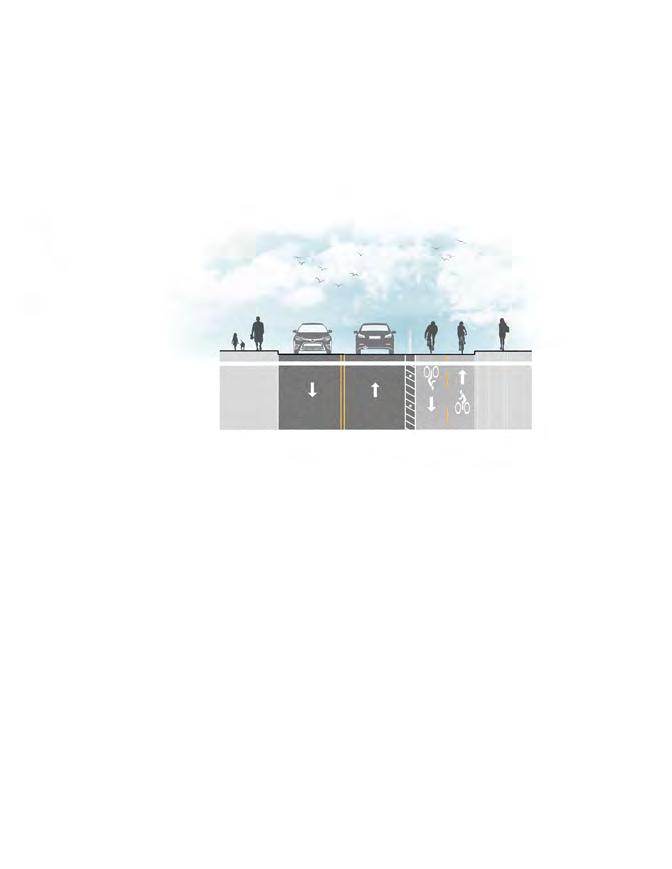
RANK 11: W. SPRING STREET SIDEWALK
AT-A-GLANCE
TYPE: Sidewalk
LENGTH: 900 ft
PRIORITY: 11
EST. COST: $126 K
SCORE: 82/100
LEGEND
SHARED-USE PATH
GREENWAY/TRAIL
EXISTING SIDEWALK
PROPOSED SIDEWALK
PARKS
SCHOOLS
GROCERY
NS RAILROAD
RR CROSSING
PROJECT ENDPOINTS

STRONG CONNECTIONS




CROSS SECTIONS



RANK 12: MALONE STREET N SIDEWALK
AT-A-GLANCE
TYPE: Sidewalk
LENGTH: 660 ft
PRIORITY: 12
EST. COST: $88 K
SCORE: 81/100
LEGEND
SHARED-USE PATH
GREENWAY/TRAIL
EXISTING SIDEWALK
PROPOSED SIDEWALK
PARKS
SCHOOLS
GROCERY
NS RAILROAD
RR CROSSING
PROJECT ENDPOINTS


STRONG CONNECTIONS



CROSS SECTIONS






RANK 13: DALLAS HIGHWAY SHARED-USE PATH
AT-A-GLANCE
TYPE: Shared-Use Path
LENGTH: 4930 ft
PRIORITY: 13
EST. COST: $2.14 M
SCORE: 80/100
LEGEND
SHARED-USE PATH
GREENWAY/TRAIL
EXISTING SIDEWALK
PROPOSED SIDEWALK
PARKS
SCHOOLS
GROCERY
NS RAILROAD
RR CROSSING
PROJECT ENDPOINTS

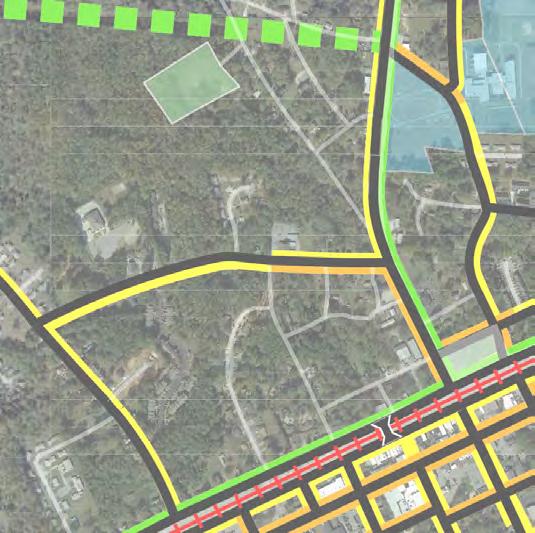



CHURCHST.



RANK 14: ROSE AVENUE SIDEWALK
AT-A-GLANCE
TYPE: Sidewalk
LENGTH: 400 ft
PRIORITY: 14
EST. COST: $54 K
SCORE: 80/100
LEGEND
SHARED-USE PATH
GREENWAY/TRAIL
EXISTING SIDEWALK
PROPOSED SIDEWALK
PARKS
SCHOOLS
GROCERY
NS RAILROAD
RR CROSSING
PROJECT ENDPOINTS


STRONG CONNECTIONS

JOBS


CROSS SECTIONS






RANK 15: MALONE STREET S SIDEWALK
AT-A-GLANCE
TYPE: Sidewalk
LENGTH: 200 ft
PRIORITY: 15
EST. COST: $28 K
SCORE: 80/100
LEGEND
SHARED-USE PATH
GREENWAY/TRAIL
EXISTING SIDEWALK
PROPOSED SIDEWALK
PARKS
SCHOOLS
GROCERY
NS RAILROAD
RR CROSSING
PROJECT ENDPOINTS
STRONG CONNECTIONS

JOBS




CROSS SECTIONS



RANK 16: VETERANS’ MEMORIAL HIGHWAY PATH
AT-A-GLANCE
TYPE: Shared-Use Path
LENGTH: 3190 ft
PRIORITY: 16
EST. COST: $1.99 M
SCORE: 79/100
LEGEND
SHARED-USE PATH
GREENWAY/TRAIL
EXISTING SIDEWALK
PROPOSED SIDEWALK
PARKS
SCHOOLS
GROCERY
NS RAILROAD
RR CROSSING
PROJECT ENDPOINTS


STRONG CONNECTIONS


SCHOOLS
CROSS SECTIONS



NOTE:

RESIDENCES START!


MILL VILLAGE PARK
RANK 17: SELMAN DRIVE BIKE LANE
AT-A-GLANCE
TYPE: Bike Lane
LENGTH: 4510 ft
PRIORITY: 17
EST. COST: N/A
SCORE: 77/100
LEGEND
SHARED-USE PATH
GREENWAY/TRAIL
TWO-WAY CYCLE TRACK
ONE-WAY CYCLE TRACK PAIR
BIKE LANES
BIKE BOULEVEARD
PARKS
SCHOOLS
GROCERY
NS RAILROAD
RR CROSSING
PROJECT ENDPOINTS
STRONG CONNECTIONS

JOBS




CROSS SECTIONS





RANK 18: ADAIR STREET SIDEWALK
AT-A-GLANCE
TYPE: Sidewalk
LENGTH: 2270 ft
PRIORITY: 18
EST. COST: $317 K
SCORE: 75/100
LEGEND
SHARED-USE PATH
GREENWAY/TRAIL
EXISTING SIDEWALK
PROPOSED SIDEWALK
PARKS
SCHOOLS
GROCERY
NS RAILROAD
RR CROSSING
PROJECT ENDPOINTS

STRONG CONNECTIONS




CROSS SECTIONS



RANK 19: E. SPRING STREET SIDEWALK
AT-A-GLANCE
TYPE: Sidewalk
LENGTH: 2760 ft
PRIORITY: 19
EST. COST: $385 K
SCORE: 74/100
LEGEND
SHARED-USE PATH
GREENWAY/TRAIL
EXISTING SIDEWALK
PROPOSED SIDEWALK
PARKS
SCHOOLS
GROCERY
NS RAILROAD
RR CROSSING
PROJECT ENDPOINTS


STRONG CONNECTIONS



CROSS SECTIONS






RANK 20: DOWNTOWN BIKE BOULEVARD
AT-A-GLANCE
TYPE: Bike Boulevard
LENGTH: 3360 ft
PRIORITY: 20
EST. COST: $23 K
SCORE: 73/100
LEGEND
SHARED-USE PATH
GREENWAY/TRAIL
TWO-WAY CYCLE TRACK
ONE-WAY CYCLE TRACK PAIR
BIKE LANES
BIKE BOULEVEARD
PARKS
SCHOOLS
GROCERY
NS RAILROAD
RR CROSSING
PROJECT ENDPOINTS
STRONG CONNECTIONS


SCHOOLS
CROSS SECTIONS
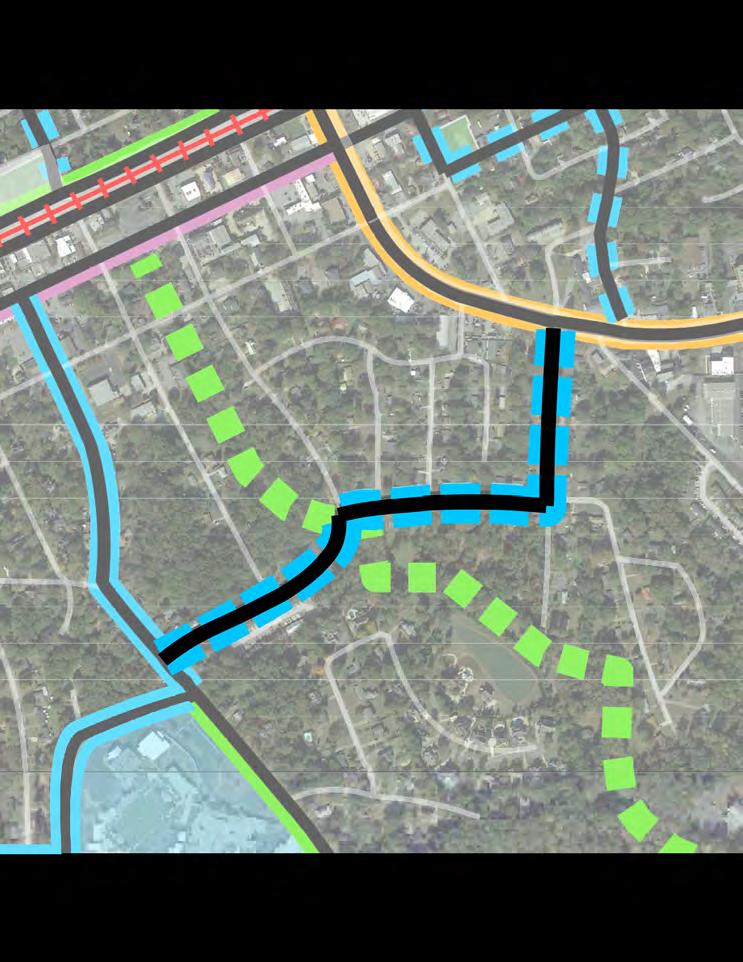
DOUGLAS COUNTY HIGH



RANK 21: HOSPITAL TO DOWNTOWN GREENWAY
AT-A-GLANCE
TYPE: Greenway/Trail
LENGTH: 1.35 Miles
PRIORITY: 21
EST. COST: $4.11 M
SCORE: 71/100
LEGEND
SHARED-USE PATH
GREENWAY/TRAIL
EXISTING SIDEWALK
PROPOSED SIDEWALK
PARKS
SCHOOLS
GROCERY
NS RAILROAD
RR CROSSING
PROJECT ENDPOINTS

STRONG CONNECTIONS


JOBS SCHOOLS
CROSS SECTIONS

CHURCHST.
DOUGLAS COUNTY HIGH


NOTE: Widths are approximate and sections are not to scale. Proposed

RESIDENCES START!





HOSPITAL
RANK 22: DORRIS ROAD SIDEWALK
AT-A-GLANCE
TYPE: Sidewalk
LENGTH: 180 ft
PRIORITY: 22
EST. COST: $24 K
SCORE: 68/100
LEGEND
SHARED-USE PATH
GREENWAY/TRAIL
EXISTING SIDEWALK
PROPOSED SIDEWALK
PARKS
SCHOOLS
GROCERY
NS RAILROAD
RR CROSSING
PROJECT ENDPOINTS


STRONG CONNECTIONS


SCHOOLS
CROSS SECTIONS





RANK 23: TWO ELEMENTARY’S BIKE BOULEVARD
AT-A-GLANCE
TYPE: Bike Boulevard
LENGTH: 2660 ft
PRIORITY: 23
EST. COST: $18 K
SCORE: 67/100
LEGEND
SHARED-USE PATH
GREENWAY/TRAIL
TWO-WAY CYCLE TRACK
ONE-WAY CYCLE TRACK PAIR
BIKE LANES
BIKE BOULEVEARD
PARKS
SCHOOLS
GROCERY
NS RAILROAD
RR CROSSING
PROJECT ENDPOINTS


STRONG CONNECTIONS





JOBS PARKS
SCHOOLS
CROSS SECTIONS

NOTE:

RANK 24: ELEMENTARY TRAIL
AT-A-GLANCE
TYPE: Greenway/Trail
LENGTH: 750 ft
PRIORITY: 24
EST. COST: $277 K
SCORE: 67/100
LEGEND
SHARED-USE PATH
GREENWAY/TRAIL
EXISTING SIDEWALK
PROPOSED SIDEWALK
PARKS
SCHOOLS
GROCERY
NS RAILROAD
RR CROSSING
PROJECT ENDPOINTS

STRONG CONNECTIONS


SCHOOLS
CROSS SECTIONS

NOTE:
NEW92BYPASS




RESIDENCES START!





RANK 25: MILL VILLAGE BIKE BOULEVARD
AT-A-GLANCE
TYPE: Bike Boulevard
LENGTH: 5120 ft
PRIORITY: 25
EST. COST: $35 K
SCORE: 67/100
LEGEND
SHARED-USE PATH
GREENWAY/TRAIL
TWO-WAY CYCLE TRACK
ONE-WAY CYCLE TRACK PAIR
BIKE LANES
BIKE BOULEVEARD
PARKS
SCHOOLS
GROCERY
NS RAILROAD
RR CROSSING
PROJECT ENDPOINTS


STRONG CONNECTIONS



CROSS SECTIONS




RANK 26: MAXWELL STREET SIDEWALK
AT-A-GLANCE
TYPE: Sidewalk
LENGTH: 550 ft
PRIORITY: 26
EST. COST: $75 K
SCORE: 65/100
LEGEND
SHARED-USE PATH
GREENWAY/TRAIL
EXISTING SIDEWALK
PROPOSED SIDEWALK
PARKS
SCHOOLS
GROCERY
NS RAILROAD
RR CROSSING
PROJECT ENDPOINTS
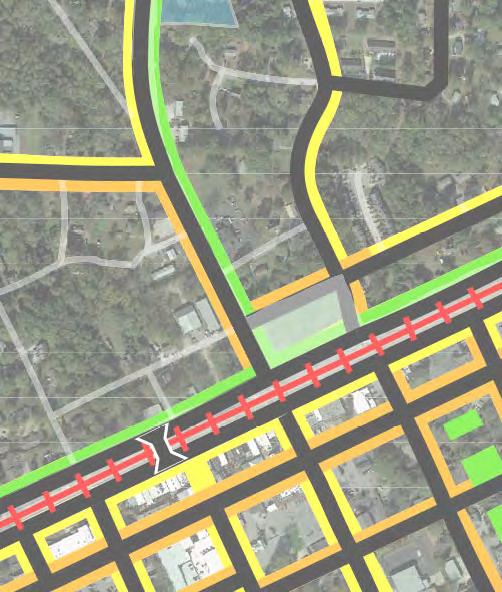
STRONG CONNECTIONS



CROSS SECTIONS





RANK 27: AUTRY CIRCLE BIKE BOULEVARD
AT-A-GLANCE
TYPE: Bike Boulevard
LENGTH: 1510 ft
PRIORITY: 27
EST. COST: $10 K
SCORE: 64/100
LEGEND
SHARED-USE PATH
GREENWAY/TRAIL
TWO-WAY CYCLE TRACK
ONE-WAY CYCLE TRACK PAIR
BIKE LANES
BIKE BOULEVEARD
PARKS
SCHOOLS
GROCERY
NS RAILROAD
RR CROSSING
PROJECT ENDPOINTS


STRONG CONNECTIONS


JOBS SCHOOLS
CROSS SECTIONS





JESSIE
RANK 28: FAIRBURN ROAD COMPLETE STREET
AT-A-GLANCE
LEGEND
NS RAILROAD
RR CROSSING
PROJECT ENDPOINTS
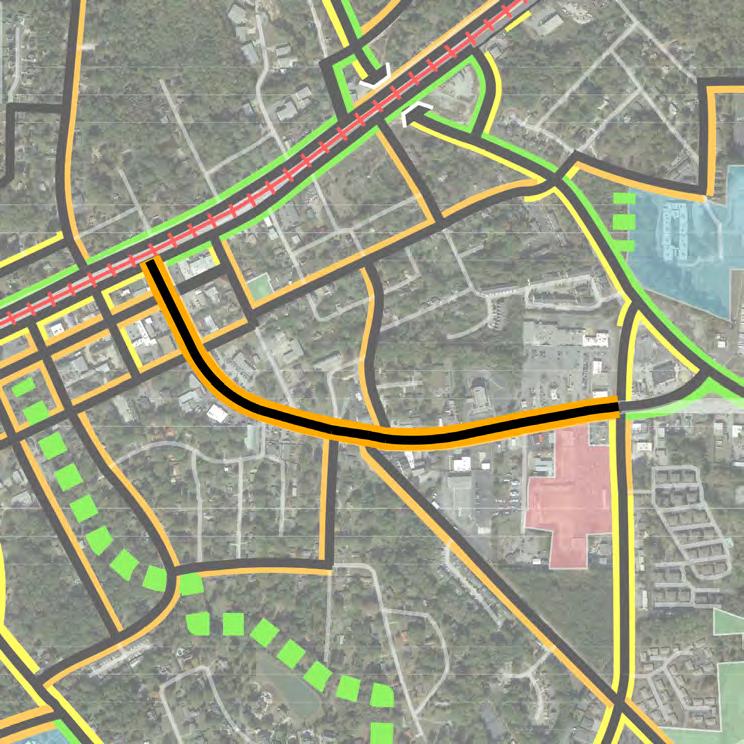
STRONG CONNECTIONS




CROSS SECTIONS
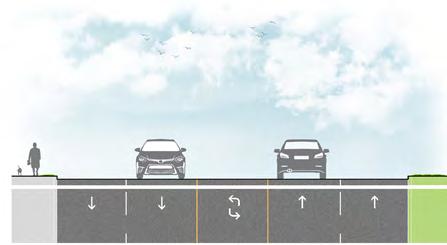


RANK 29: DUNCAN STREET N. SIDEWALK
AT-A-GLANCE
TYPE: Sidewalk
LENGTH: 470 ft
PRIORITY: 29
EST. COST: $66 K
SCORE: 63/100
LEGEND
SHARED-USE PATH
GREENWAY/TRAIL
EXISTING SIDEWALK
PROPOSED SIDEWALK
PARKS
SCHOOLS
GROCERY
NS RAILROAD
RR CROSSING
PROJECT ENDPOINTS

STRONG CONNECTIONS



PARKS
CROSS SECTIONS

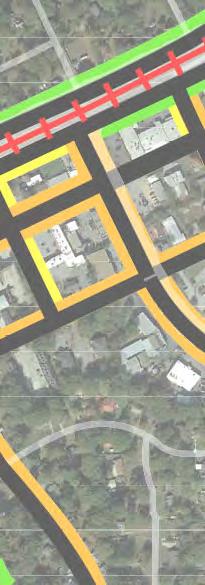



RANK 30: HAGIN STREET SIDEWALK
AT-A-GLANCE
TYPE: Sidewalk
LENGTH: 840 ft
PRIORITY: 30
EST. COST: $111 K
SCORE: 62/100
LEGEND
SHARED-USE PATH
GREENWAY/TRAIL
EXISTING SIDEWALK
PROPOSED SIDEWALK
PARKS
SCHOOLS
GROCERY
NS RAILROAD
RR CROSSING
PROJECT ENDPOINTS


STRONG CONNECTIONS




CROSS SECTIONS


RESIDENCES START!

FULL RANKED PROJECT LIST
3.5 FULL RANKED PROJECT LIST
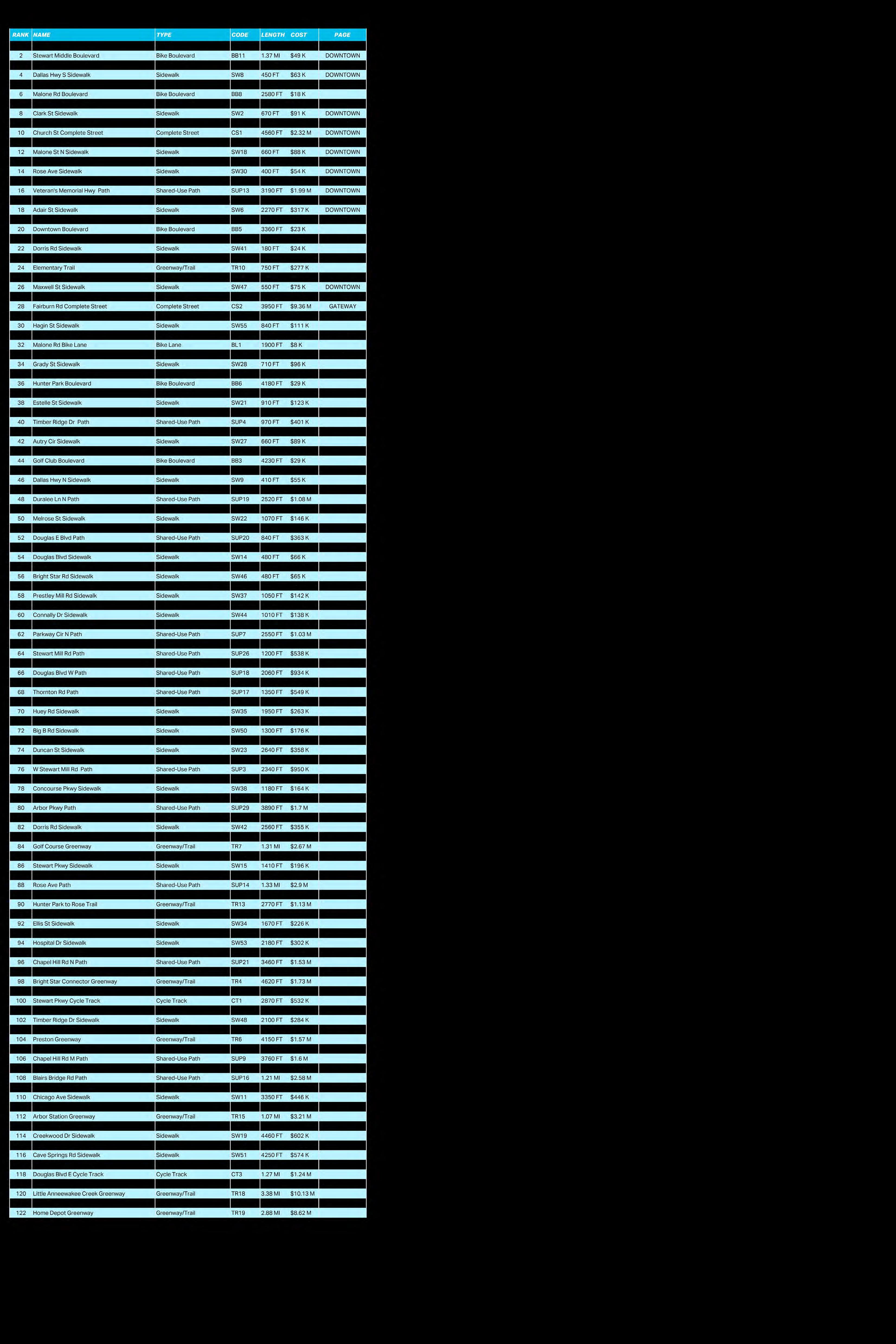
62: Projects ranked 1st through 30th.
FIGURE
63: Projects ranked 31st through 60th.


FIGURE


FIGURE 64: Projects ranked 61st through 90th.
65: Projects ranked 91st through 122nd.


FIGURE
This page left intentionally blank.
BEFORE & AFTER HEATMAPS
3.6 BEFORE & AFTER HEATMAPS
In the Network Analysis chapter of this document, we assessed the existing connectivity of Douglasville’s transportation system through the lens of a pedestrian and a cyclist. In order to understand whether the recommendations described to this point will have an impact on connectivity, we performed the same analysis on the network if all of the recommendations were implemented. This provides us a before and after picture of connectivity. Once again, we take the difference between the existing connectivity and the final condition connectivity to get a sense of the impact of our recommendations.

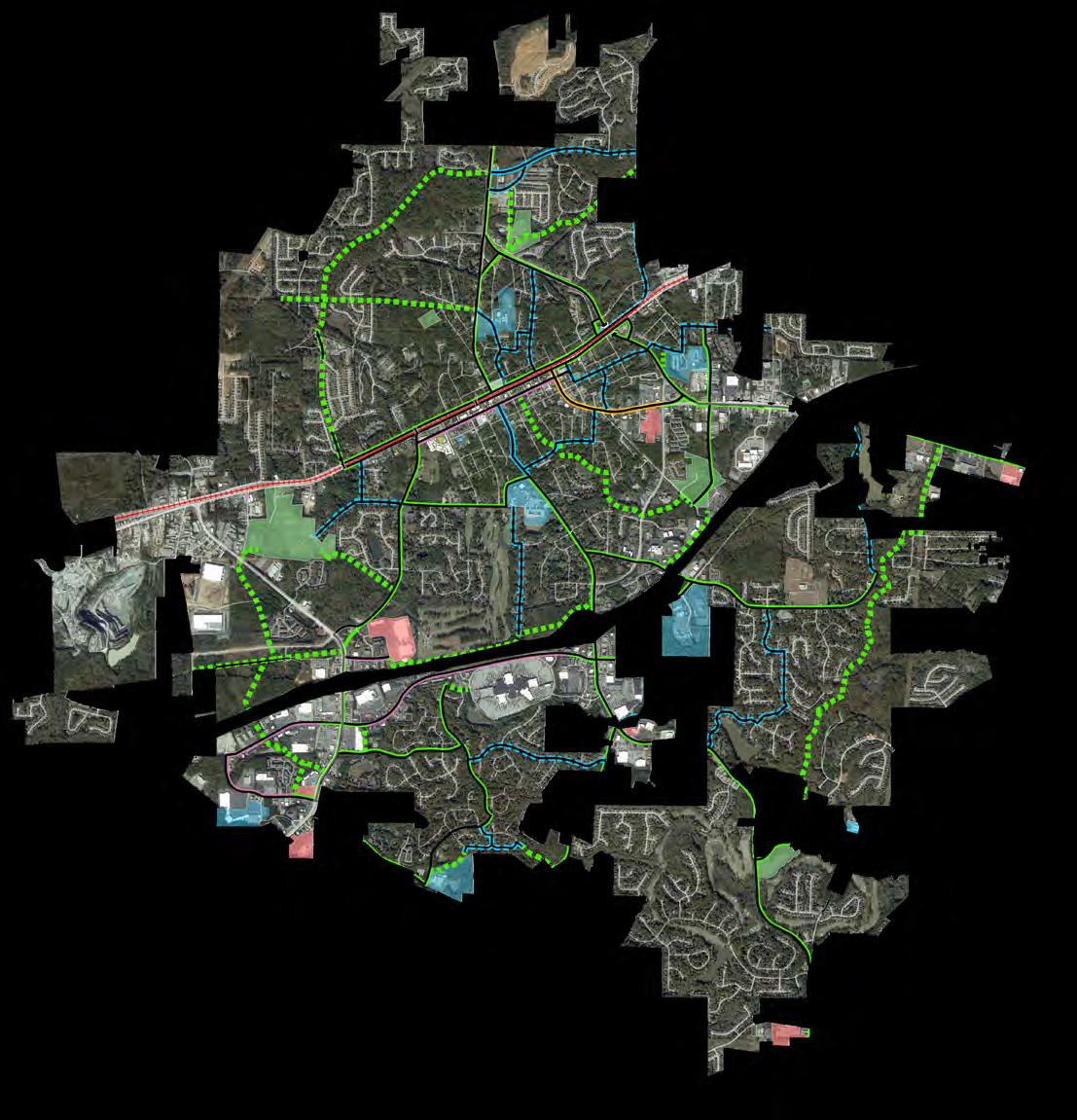
CONNECTIVITY



CONNECTIVITY
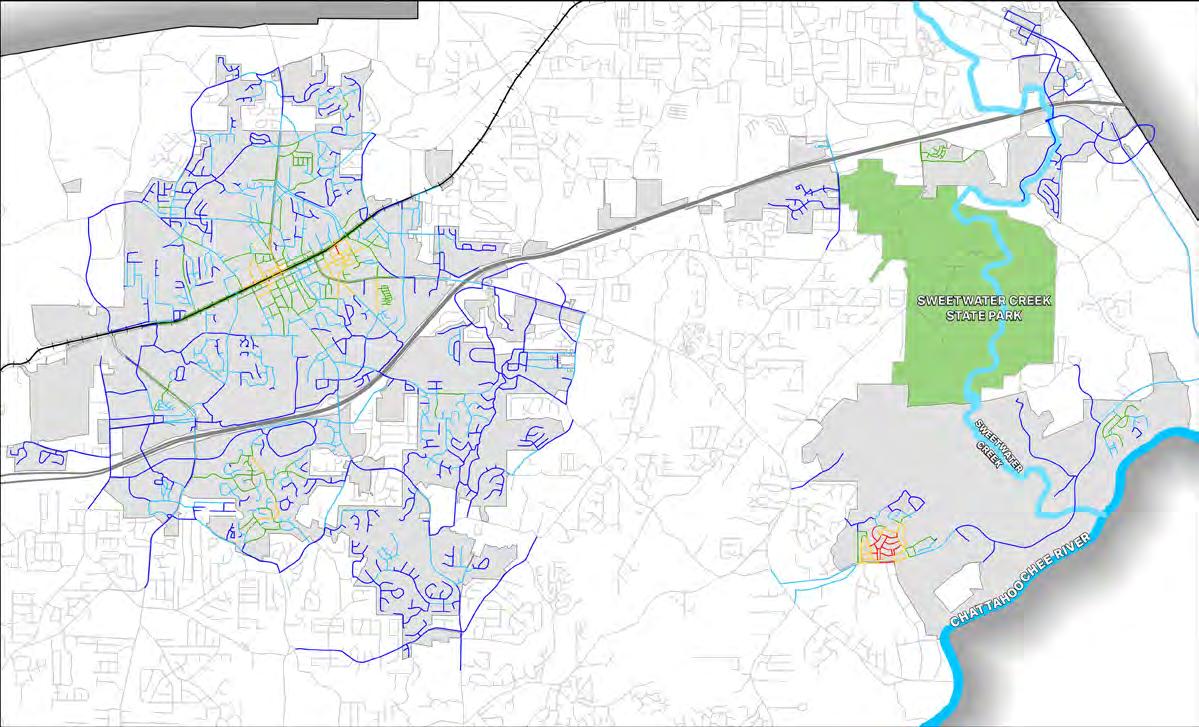



LEGEND
CONNECTIVITY

LEGEND
CONNECTIVITY


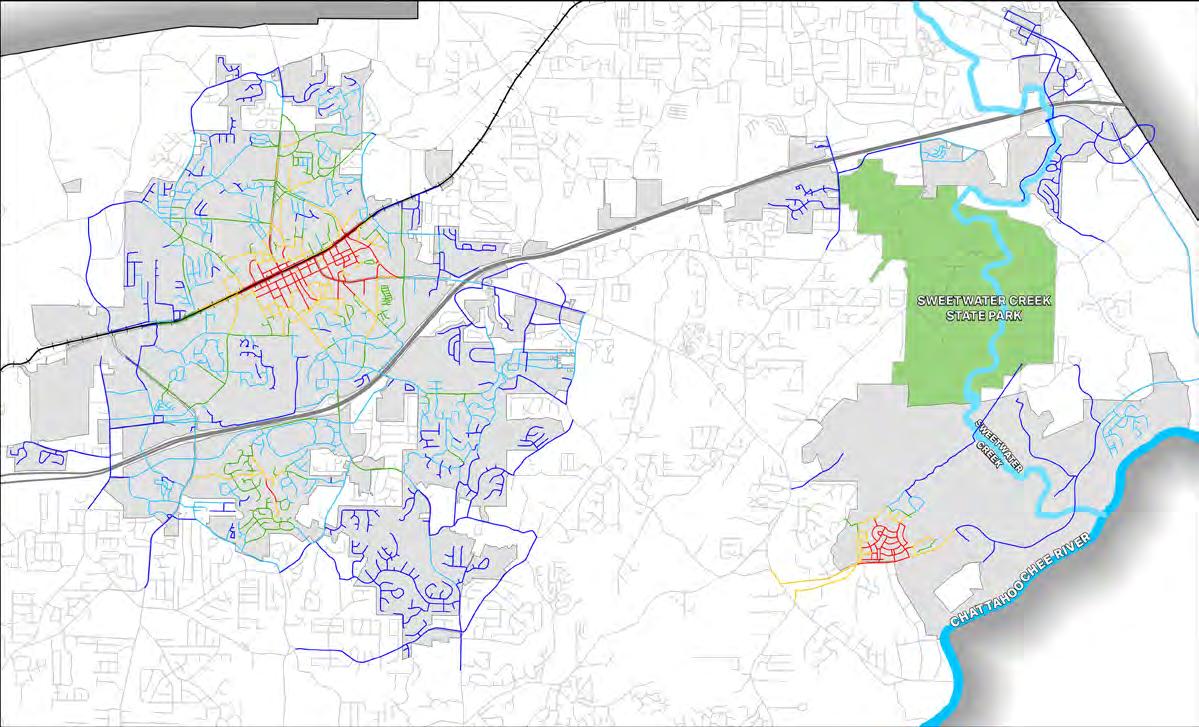

CONNECTIVITY




CONNECTIVITY


LEGEND



CONNECTIVITY

LEGEND
CONNECTIVITY


CONNECTIVITY



CONNECTIVITY
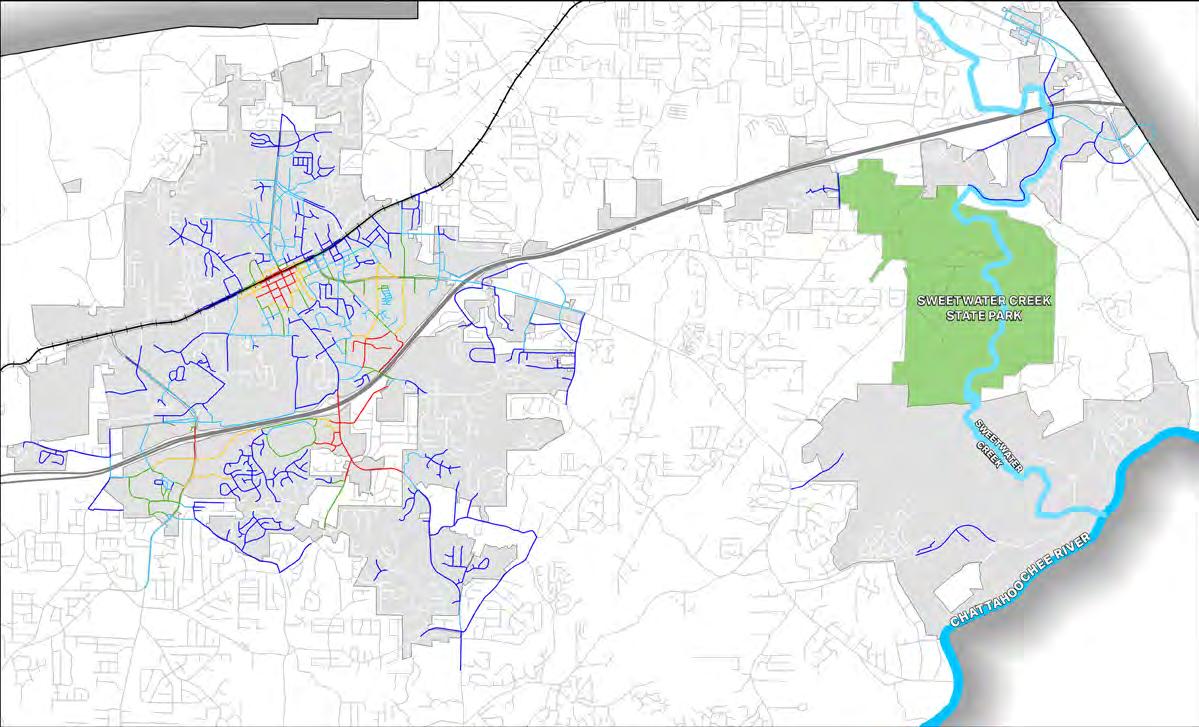


LEGEND


LEGEND
CONNECTIVITY

CONNECTIVITY
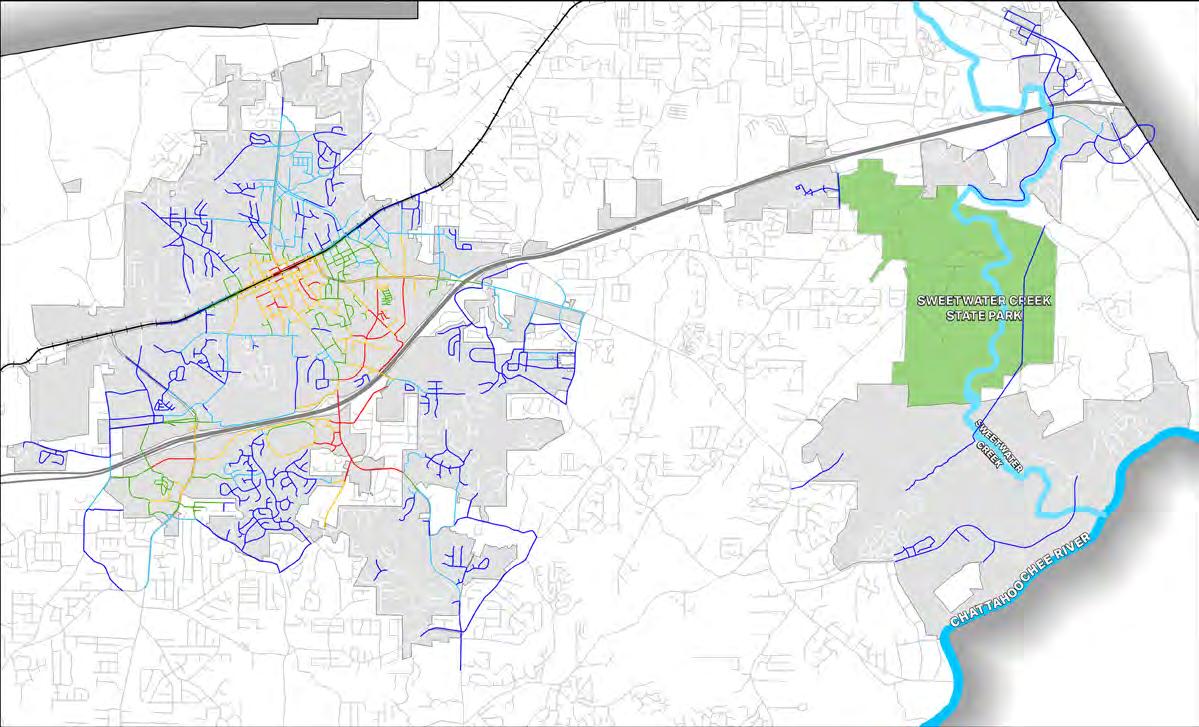


CONNECTIVITY



CONNECTIVITY



LEGEND


LEGEND
CONNECTIVITY

CONNECTIVITY
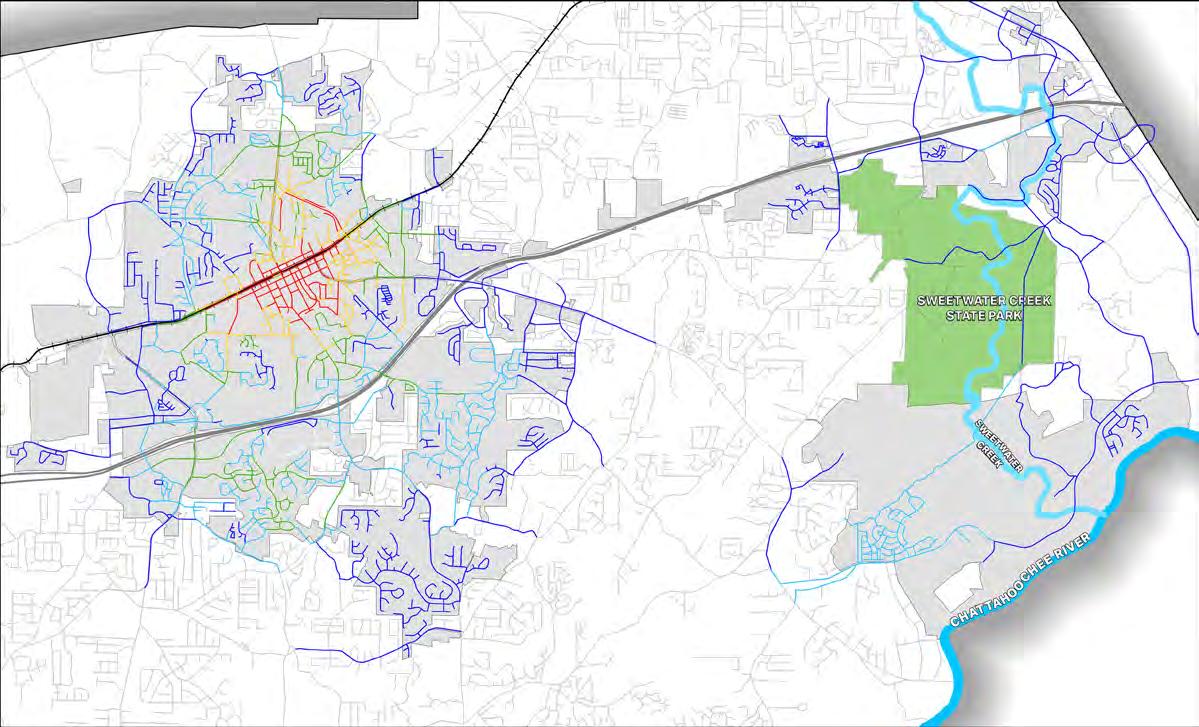


CONNECTIVITY




CONNECTIVITY
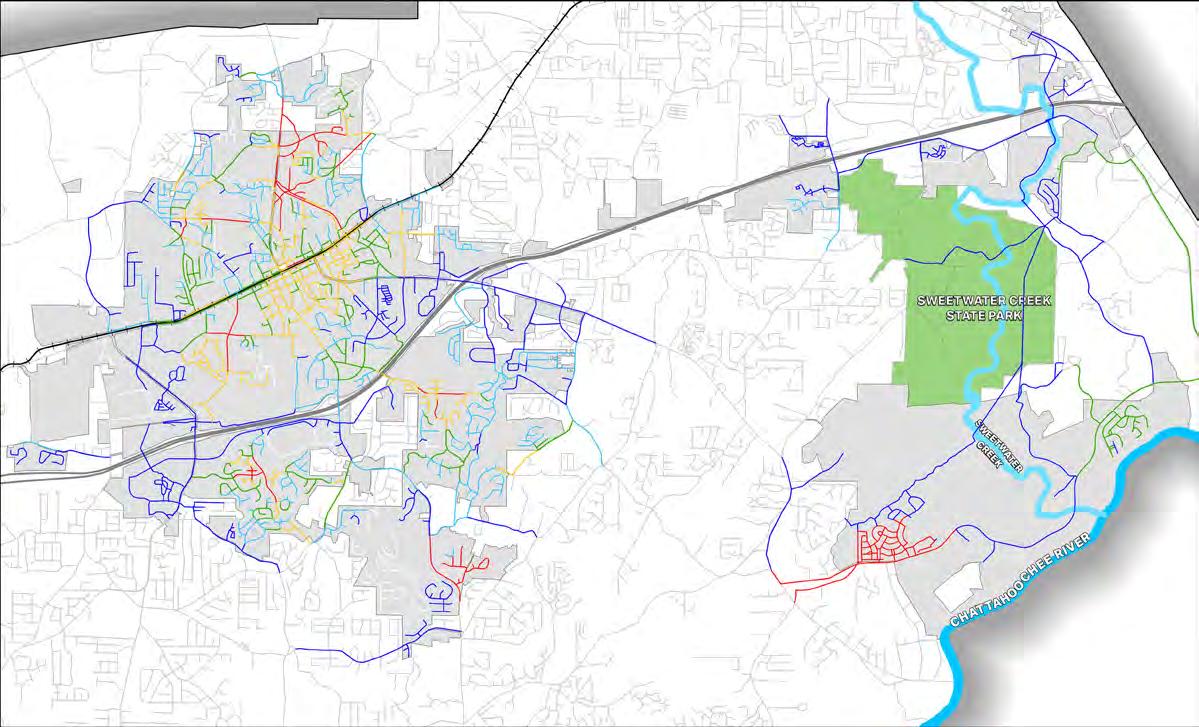

CONNECTIVITY



CONNECTIVITY
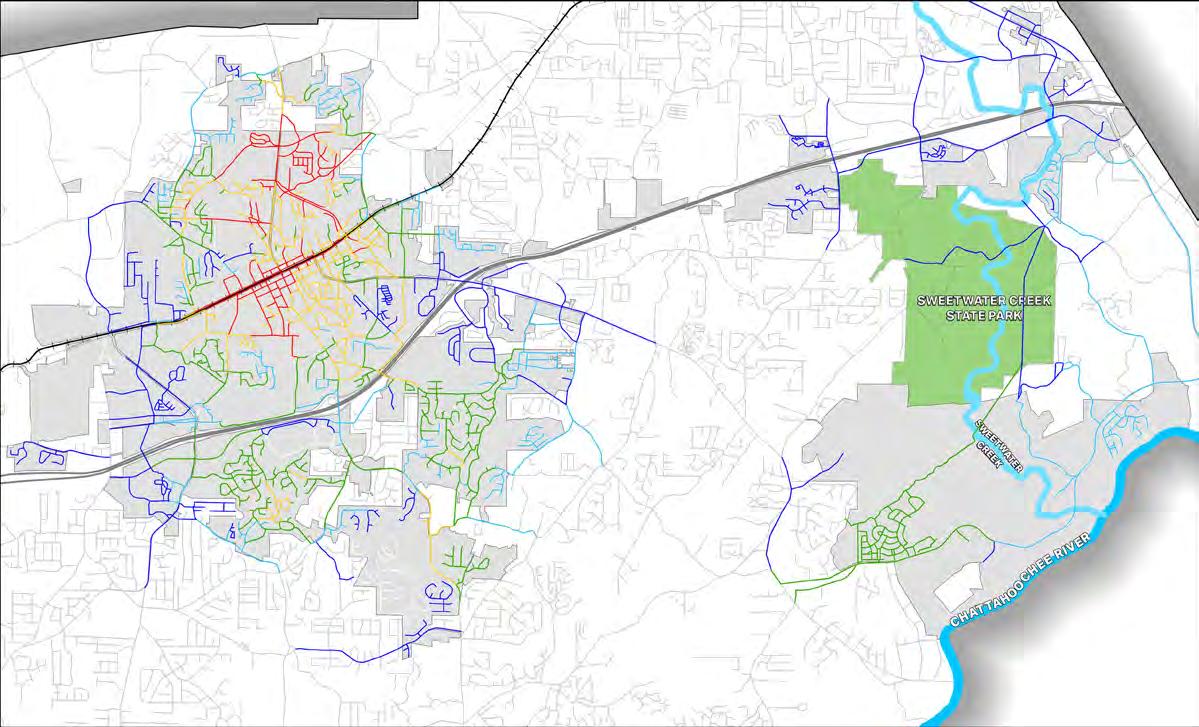





CONNECTIVITY
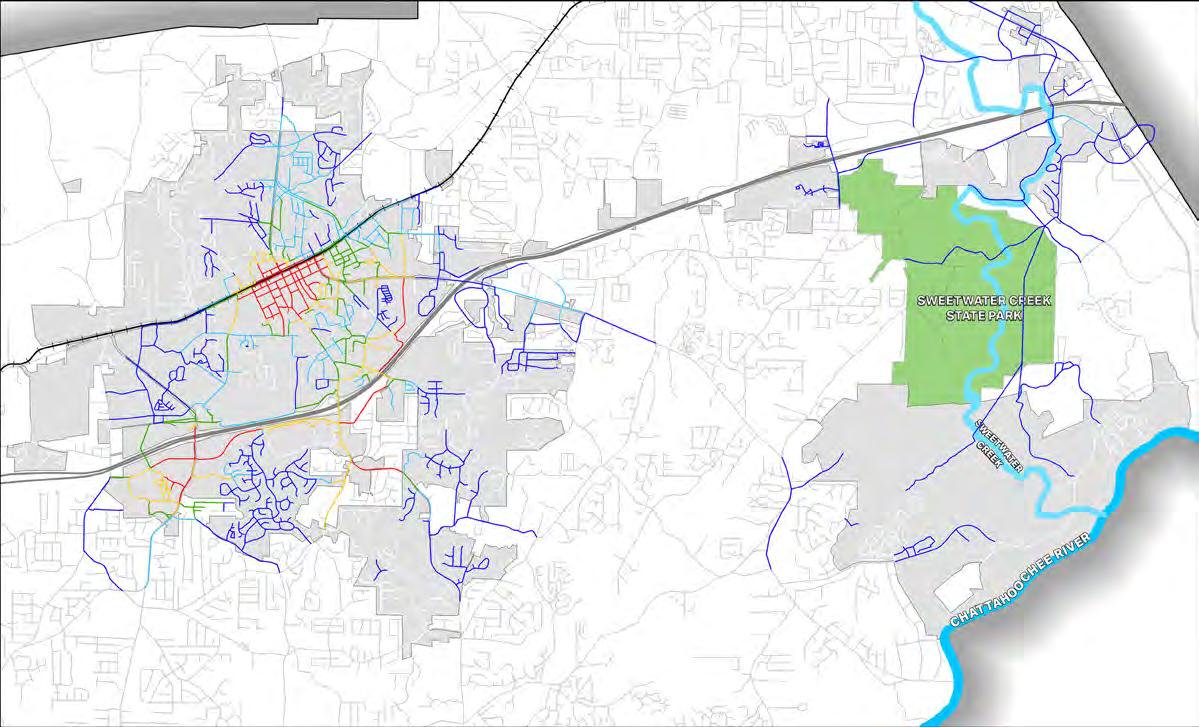


LEGEND



CONNECTIVITY

LEGEND
CONNECTIVITY






